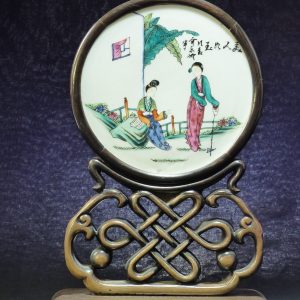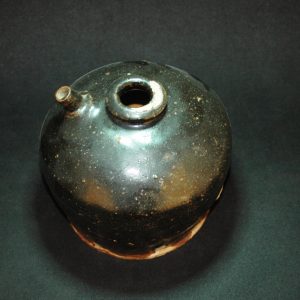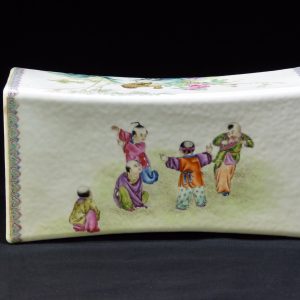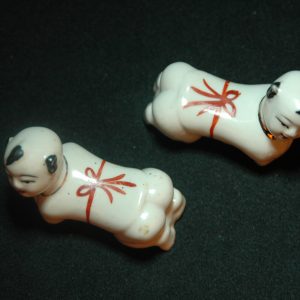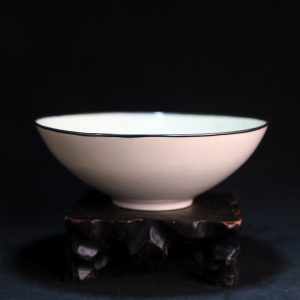Description
五大名窑里,定窑不以釉色取胜,而以纹饰作为装饰特点,刻花、划花、印花……多种多样的装饰手段,将定窑瓷器装点得极其美妙。
定窑在唐代时就已是著名瓷场,北宋是定窑发展的鼎盛时期,北宋中后期,定窑由于瓷质精良、色泽淡雅,纹饰秀美,被宋朝政府选为宫廷用瓷。北宋定窑装饰技法丰富多彩,有堆塑、刻花、划花、剔花、印花等,其剔花、刻花、印花技法对同时期其他窑场产生了重要影响。
故宫博物院的收藏里,定窑类型的瓷器近八百件,多数具有花纹,无论划花流畅如画、印花繁丽如织绣,均能见到宋人纹样设计的多样趣味。
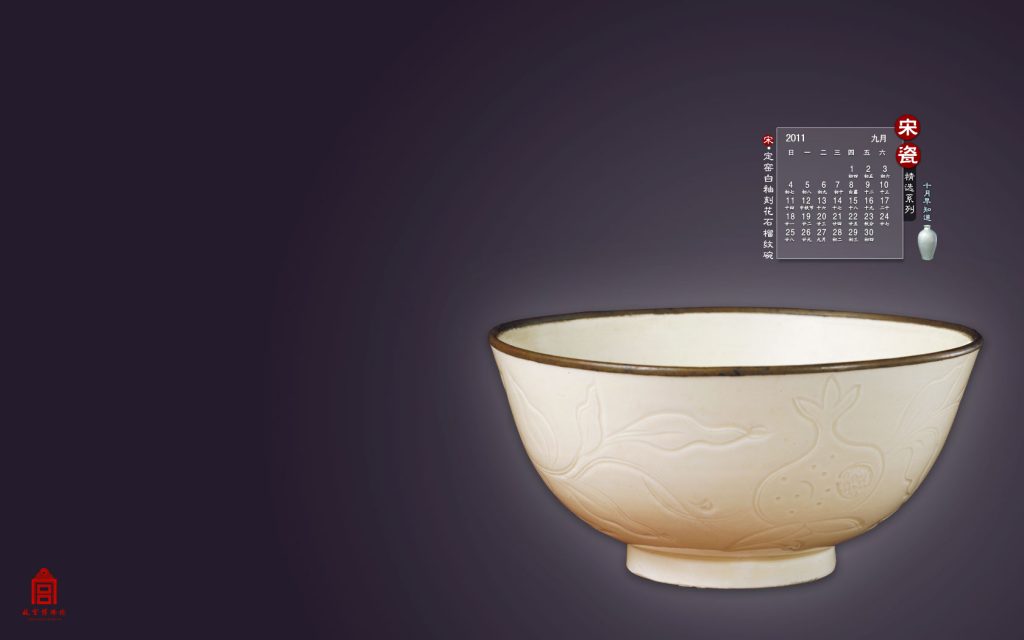
北宋苏东坡曾咏叹「定州花瓷琢红玉」,金人刘示阝亦记载「定州花瓷瓯,颜色天下白」句,足见有花纹的定窑白瓷,风靡当时代。
参考:Sotheby’s 單色釉
Monochrome
拍品 47 北宋 定窰白釉印花纏枝菊花紋盌
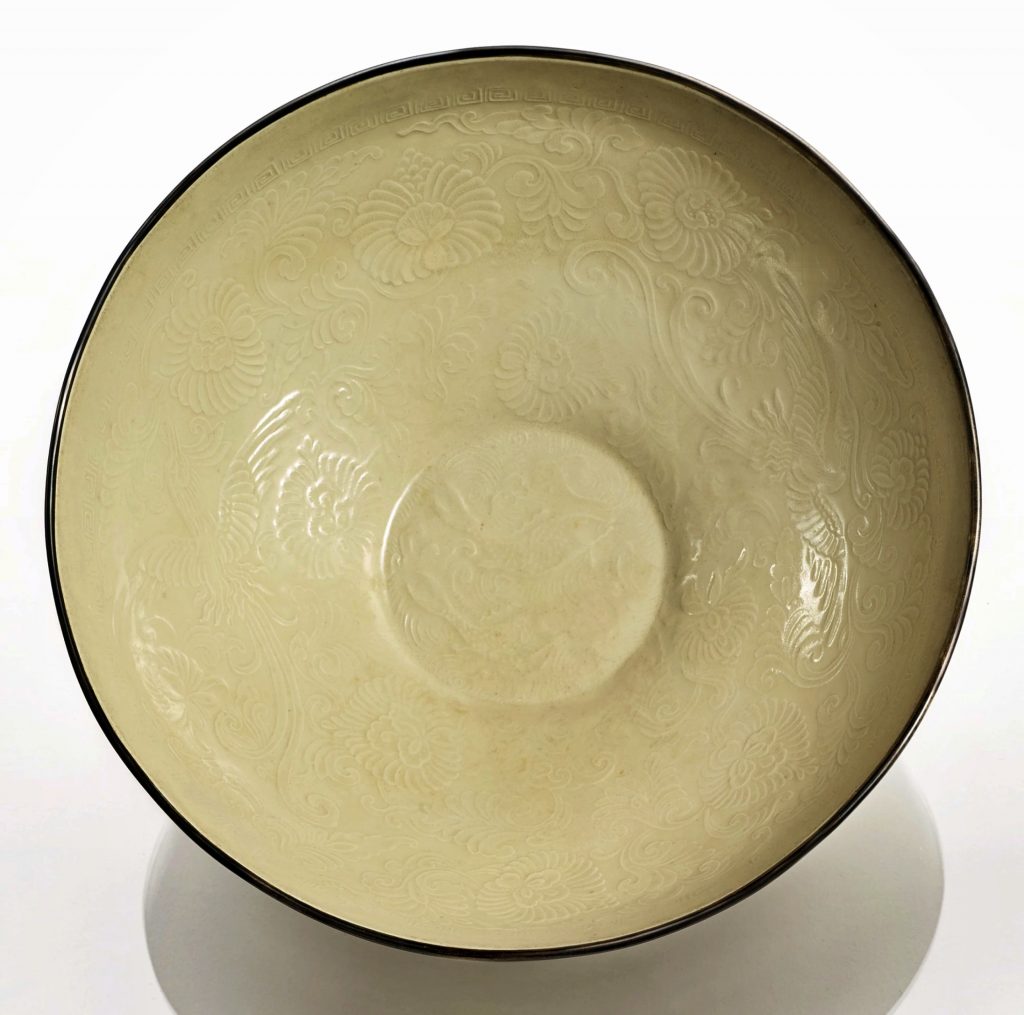
估價 10,000 – 15,000 USD
描述
Ceramic
rising from a short foot, the rounded bowl molded on the interior with a pair of fish in the central medallion amid rolling waves, surrounded by a pair of phoenix among scrolling chrysanthemum flower heads on the well, all below a key-fret border, covered in an even pale ivory glaze pooling in characteristic teardrops down the plain exterior, the rim bound in a metal mount
陶瓷
從短腳上升起,圓形碗在內部模塑而成,中間飾有一對魚,在波濤洶湧的波浪中,在井上滾動的菊花頭中被一對鳳凰包圍,都在鍵品邊框下方, 覆蓋著均勻的淺象牙色釉料,在樸素的外觀上匯集了特有的淚珠,邊緣固定在金屬支架上
來源
購於香港,1986年11月
Condition
The rim polished and bound with a white metal rim. with one approximately 1cm restored rim chip and two further possible small areas of restoration to the rim. The glaze is slightly discolored to a smoky-yellow tone and appears to have been polished or treated in another way. Areas of yellowish discoloration still visible to the sides of the interior, and speckled grayish discoloration visible to interior center. A 5mm firing imperfection to lower body of the exterior.
條件
輪輞拋光並鑲有白色金屬輪輞。 一個大約1厘米的修復輪輞缺口和另外兩個可能修復輪輞的小區域。 釉面略微變色為煙黃色,似乎經過拋光或其他方式處理。 內部兩側仍然可見黃色變色區域,內部中心可見斑點狀灰色變色。 外部下半身有5毫米的烧瓷缺陷。
参考:佳士得
12月 7日 12PM (HKT) | 網上拍賣 20203
古今網上拍賣-中國藝術
拍品 3249 北宋 定窯白釉印花荷塘魚藻紋盌
NORTHERN SONG DYNASTY (960 – 1127)
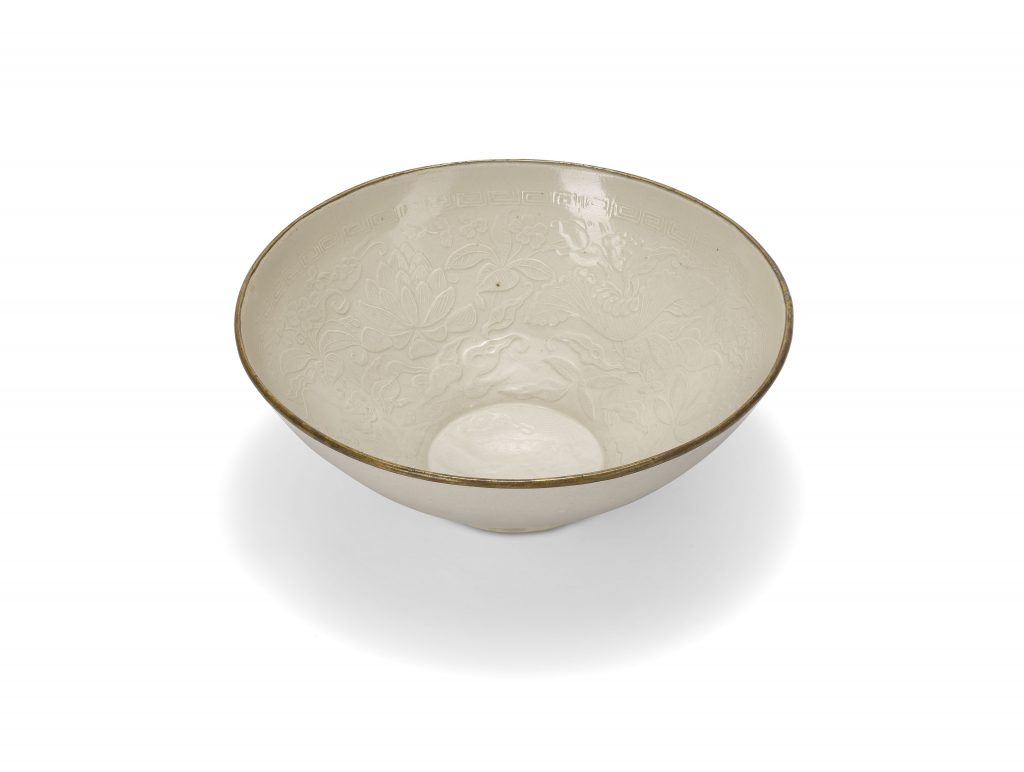
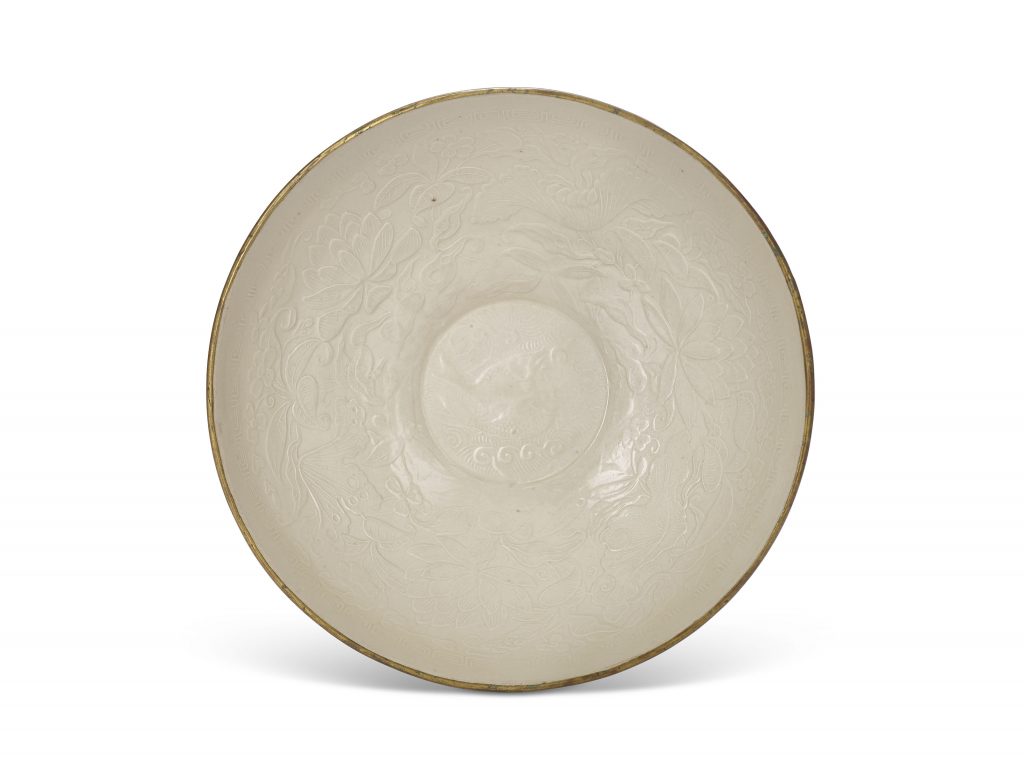
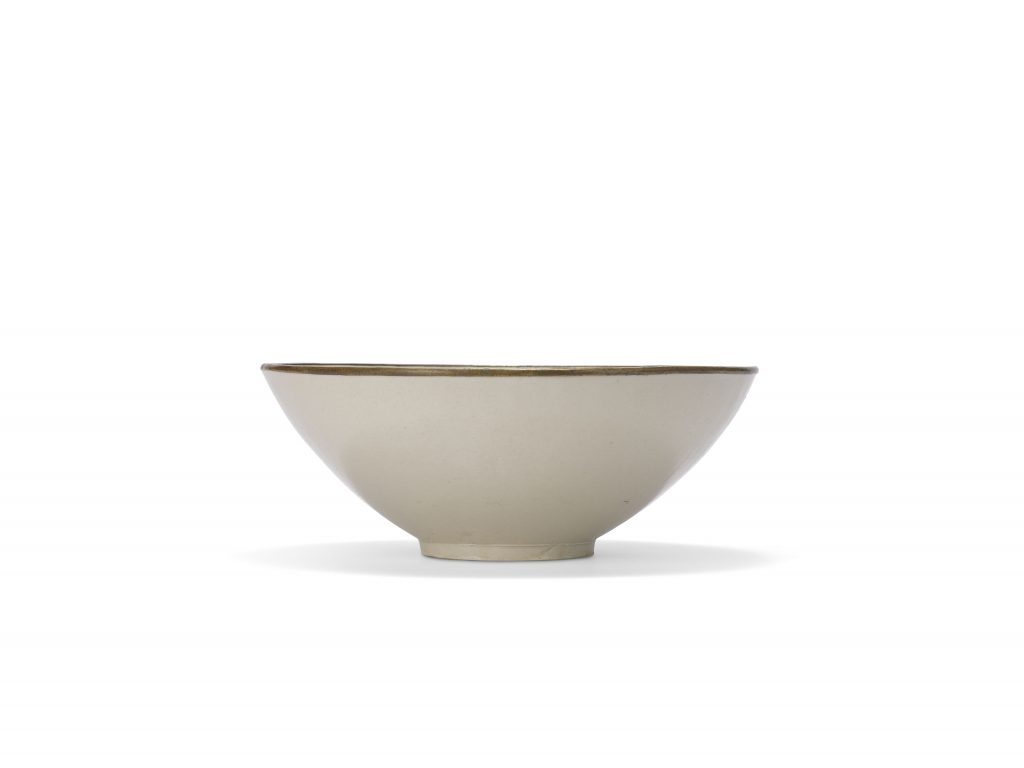
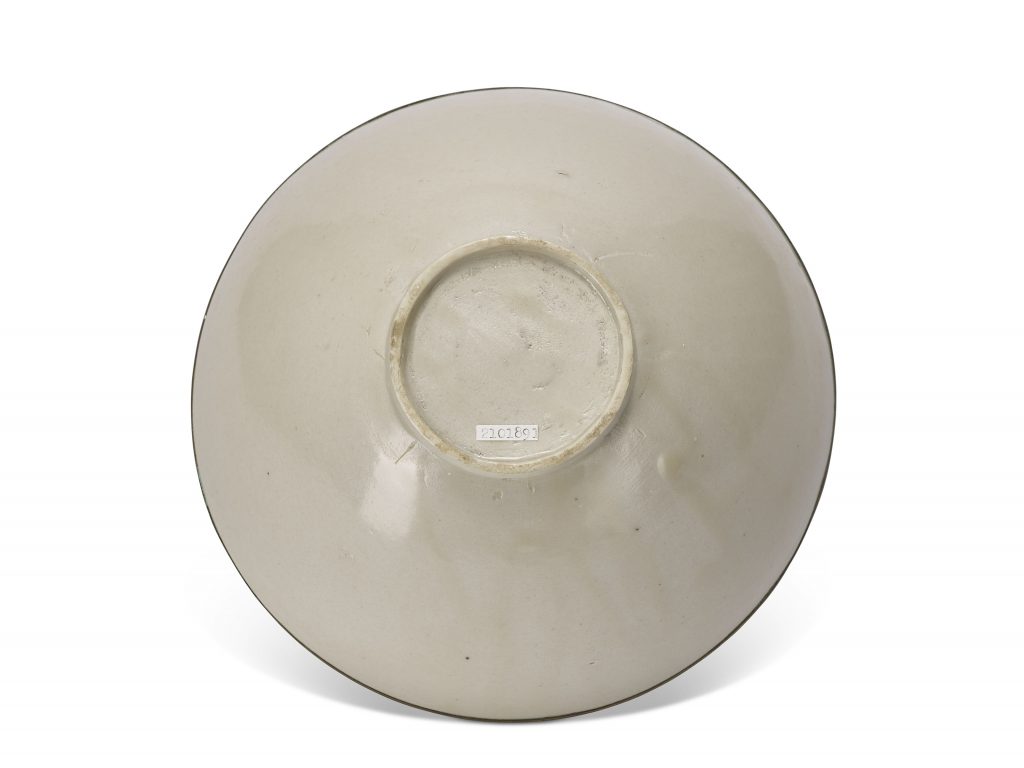
估價 HKD 100,000 – HKD 150,000
北宋 定窯白釉印花荷塘魚藻紋盌
NORTHERN SONG DYNASTY (960 – 1127)
7.1/ in. (18.3 cm.) diam., Japanese double wood boxes
來源
壺中居,東京
狀況報告
拍品的狀況可能存在極大差異,而由於其性質使然,拍品難以處於完美無瑕的狀態。拍品均以拍賣時的狀況出售。
謹請注意,所有拍品均按「現狀」拍賣,閣下或閣下的專業顧問應於拍賣前親自查看拍品以評鑑拍品之狀況
– 口沿鑲銅口
– 盌內底部有一道沖線修經復,並有相關補色
– 有一般表面磨損及刮痕,屬年代久遠所致的正常現象
参考:佳士得
29 11月 2016| 現場拍賣 12675
養德堂珍藏中國古陶瓷
拍品 3110
A SMALL DING MOULDED ‘TWIN-FISH’ DISH
金 定窯印花雙魚紋盤
JIN DYNASTY (1115-1234)
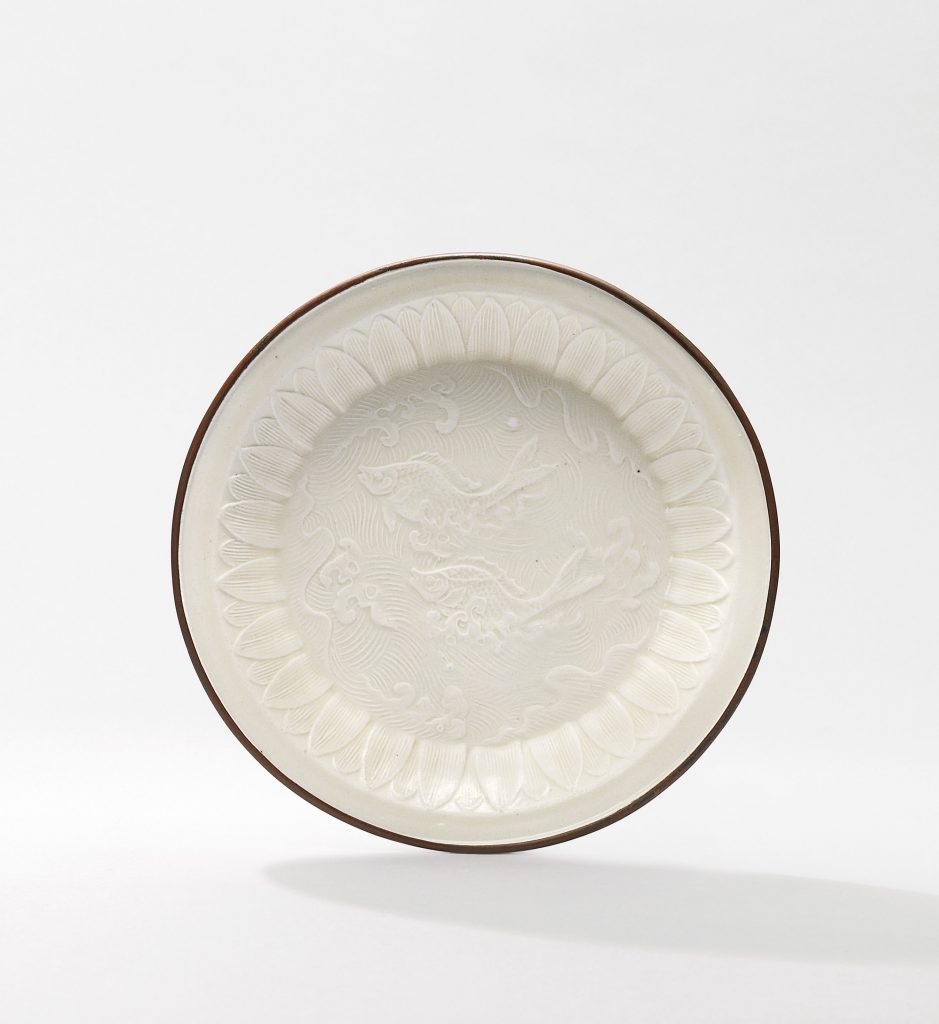
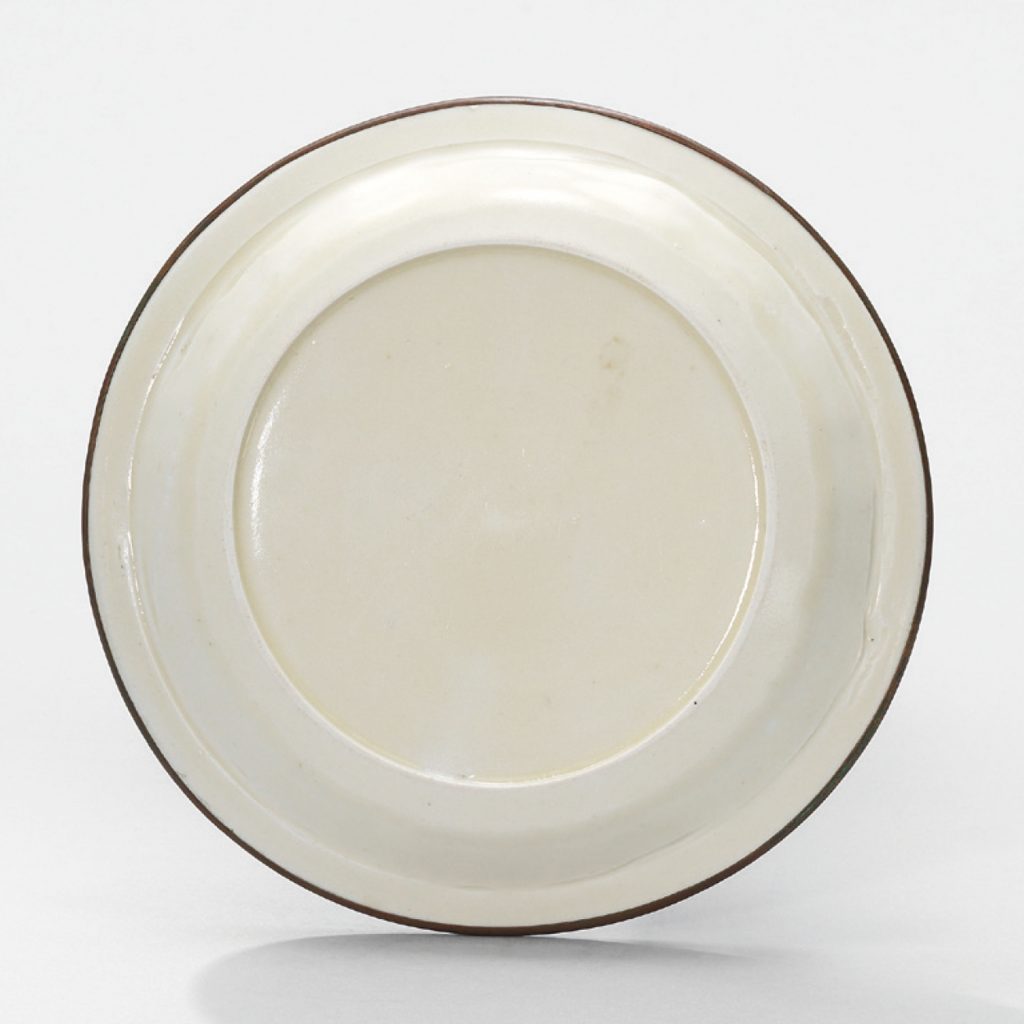
成交價 HKD 562,500
估價 HKD 260,000 – HKD 350,000
金 定窯印花雙魚紋盤
JIN DYNASTY (1115-1234)
5 3/4 in. (14.5 cm.) diam., box
狀況報告
謹請注意,所有拍品均按「現狀」拍賣,閣下或閣下的專業顧問應於拍賣前親自查看拍品以評鑑拍品之狀況。
– 整體品相良好,器面有輕磨損,屬正常現象
参考:佳士得
28 5月 2013| 現場拍賣 3220
益清閣珍藏中國瓷器
拍品 2005
A CARVED DING ‘DOUBLE FISH’ LOBED-RIM DISH
北宋/金 定窰白釉刻劃雙魚紋葵口盤
NORTHERN SONG/JIN DYNASTY (960-1234)
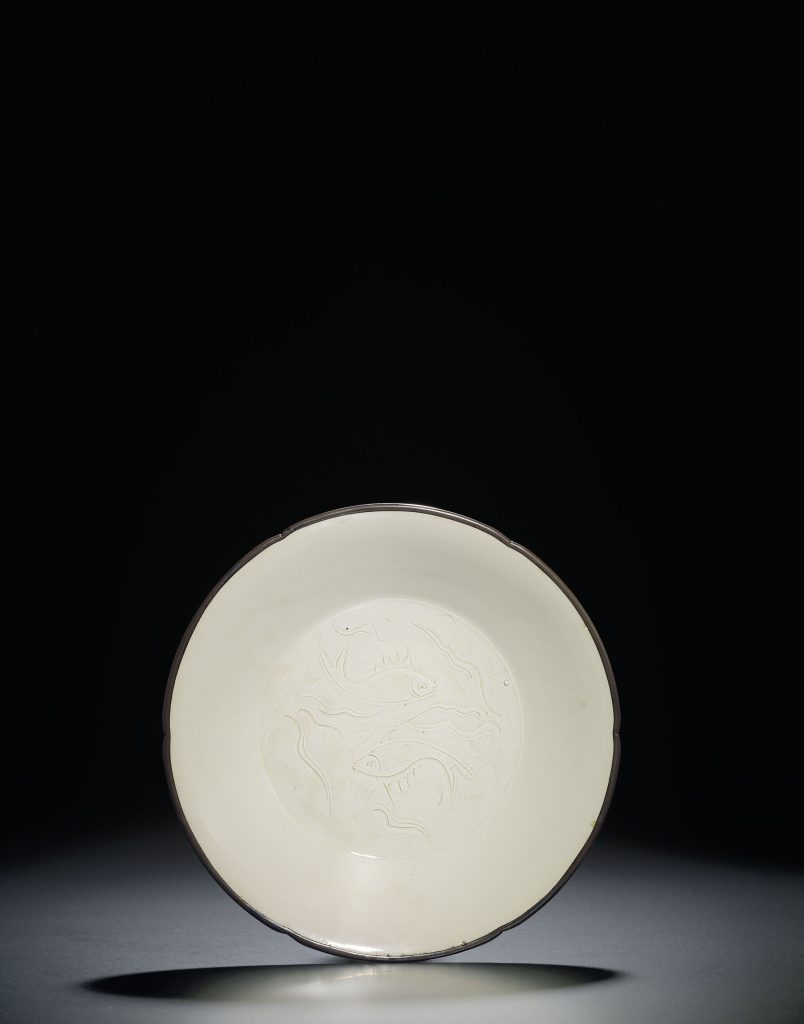
成交價 HKD 600,000
估價 HKD 400,000 – HKD 600,000
北宋/金 定窰白釉刻劃雙魚紋葵口盤
NORTHERN SONG/JIN DYNASTY (960-1234)
拍品專文
盤敞口,直腹,折腰,圈足。內外施牙白色釉,鑲銅口。盤心刻雙魚游弋,篦劃水波紋。
此器紋飾線條流暢揮灑,表現出定窰刻劃花的成熟技術。宋代定窰器以刻劃萱草紋較多,其次為荷塘游魚紋。如此器的雙魚紋往往輔以篦劃水波紋,清宮舊藏一件刻劃雙魚紋大盤,魚身劃線作鱗,塘中水藻飄浮,均與本盤的紋飾相若,載於1996年香港出版故宮博物院藏文物珍品全集《兩宋瓷器‧上》,圖版56號。其他近似例子包括倫敦大維德中國藝術基金會收藏一件較小型盤;以及臺北故宮博物院收藏二盌,曾展出於1987年舉辦《定窰白瓷特展》,圖錄編號48、49;49號盌更如本盤同樣葵口鑲銅邊。
狀況報告
We have sought to record changes in the condition of this piece acquired after its initial manufacture.
– There are a few small nicks to the mouth rim.
拍品專文
Images of fish have been used to decorate Chinese ceramics from the Neolithic period, and have remained a popular theme – providing both form and decoration. The Song dynasty saw an even greater use of fish for decoration on ceramics. Amongst the most elegant were the fish carved and incised under the glaze of the classic Northern Song Ding wares, such as that carved in the interior of the large bowl from the Qing Court Collection, illustrated in Porcelain of the Song Dynasty (I), The Complete Collection of Treasures of the Palace Museum, Hong Kong, 1996, p. 64, no. 56; a smaller dish in the Percival David Foundation, see M. Medley, Illustrated Catalogue of Ting and Allied Wares, Percival David Foundation, London, 1980, pl. V, no. 29; and two bowls included in the Special Exhibition of Ting Ware White Porcelain, National Palace Museum, Taipei, 1987, Catalogue, nos. 48 and 49. The latter bowl, in particular, has a lobed, metal-bound rim.
Much of the popularity of fish as a decorative theme, especially in later dynasties, hinges on the fact that the word for fish, yu, is a homophone for the word for abundance or surplus – thus two fish represent doubled abundance and a gold fish an abundance of gold. The depiction of fish in water, as on the current dish, has also come to provide a rebus for Yushui hexie, ‘May you be as harmonious as fish and water’. Such symbolism is particularly appropriate in the context of marriage, and decoration including two fish additionally symbolizes both fertility and conjugal happiness in the same context.
参考:佳士得
25 11月 2018| 現場拍賣 17461
不凡- 宋代美學一千年 (晚間拍賣)
拍品 8005
A FINE DING CARVED ‘LOTUS’ HEXAFOIL BOWL
THE PROPERTY OF A GENTLEMAN
北宋 定窯刻蓮紋花口盌
NORTHERN SONG DYNASTY (960-1127)
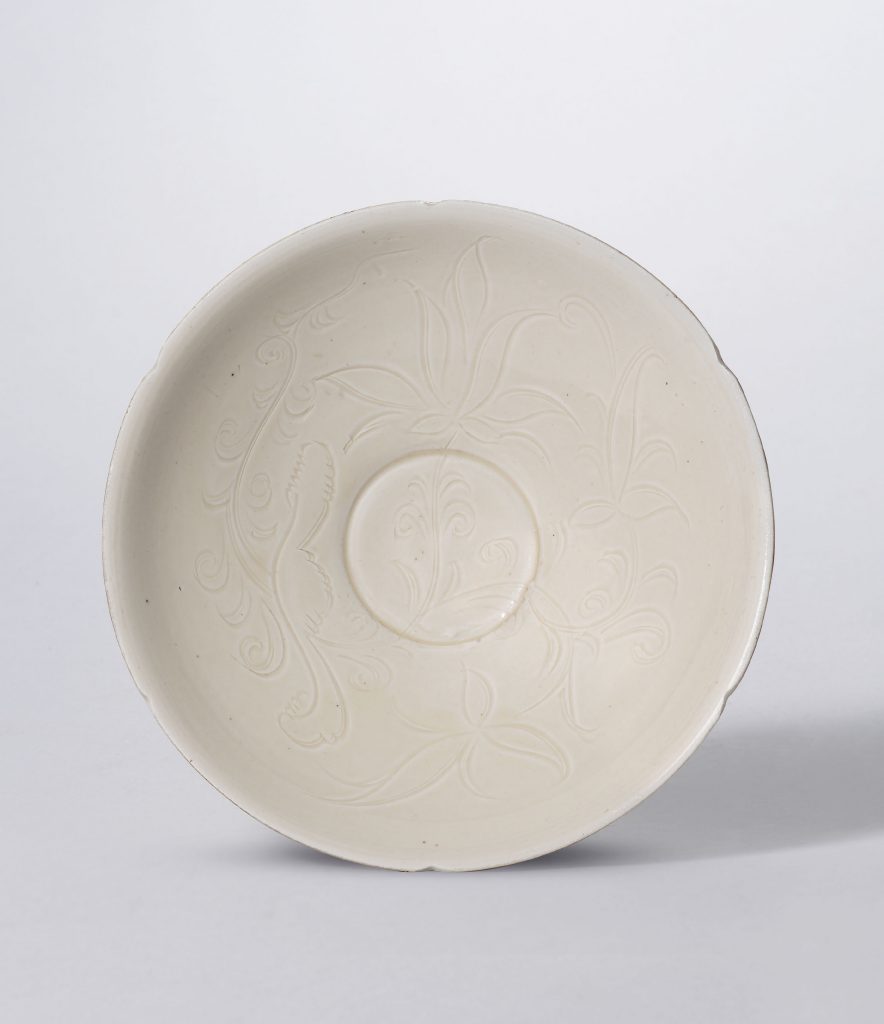
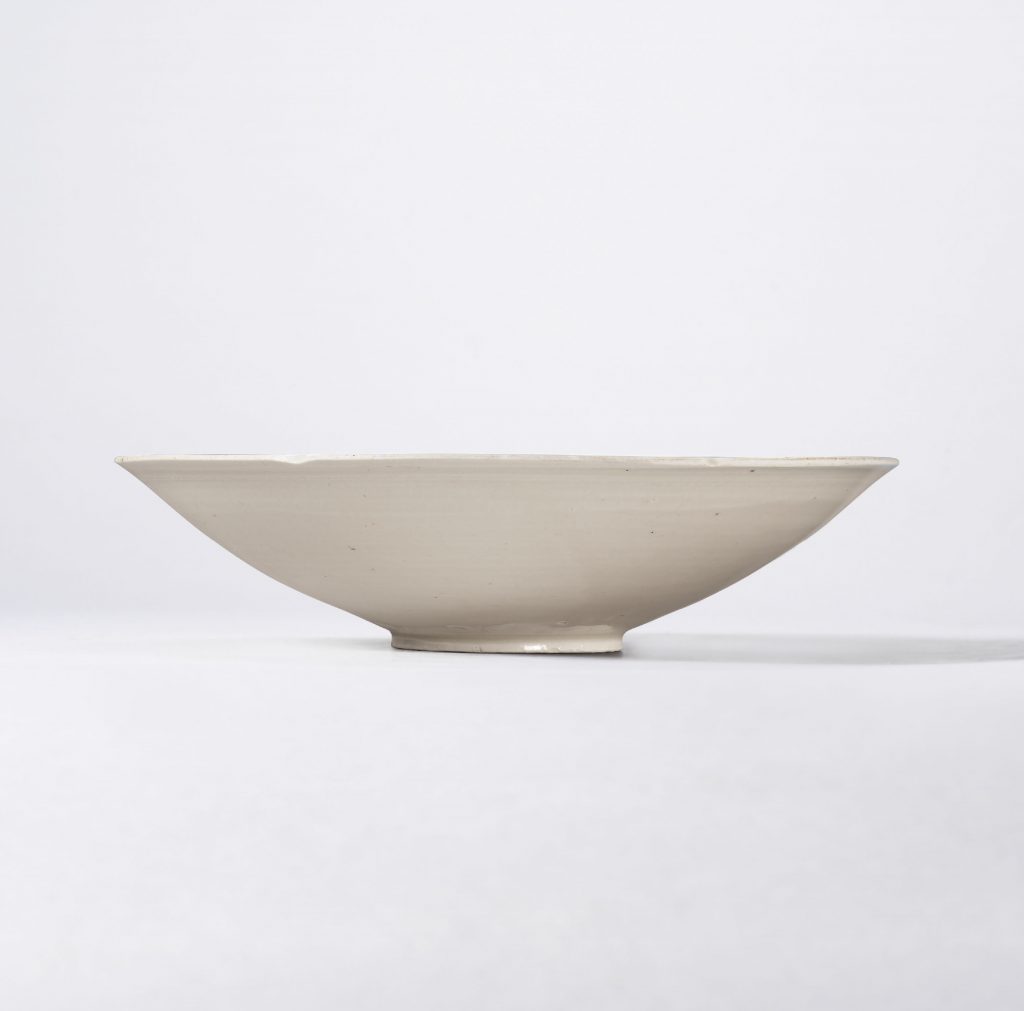
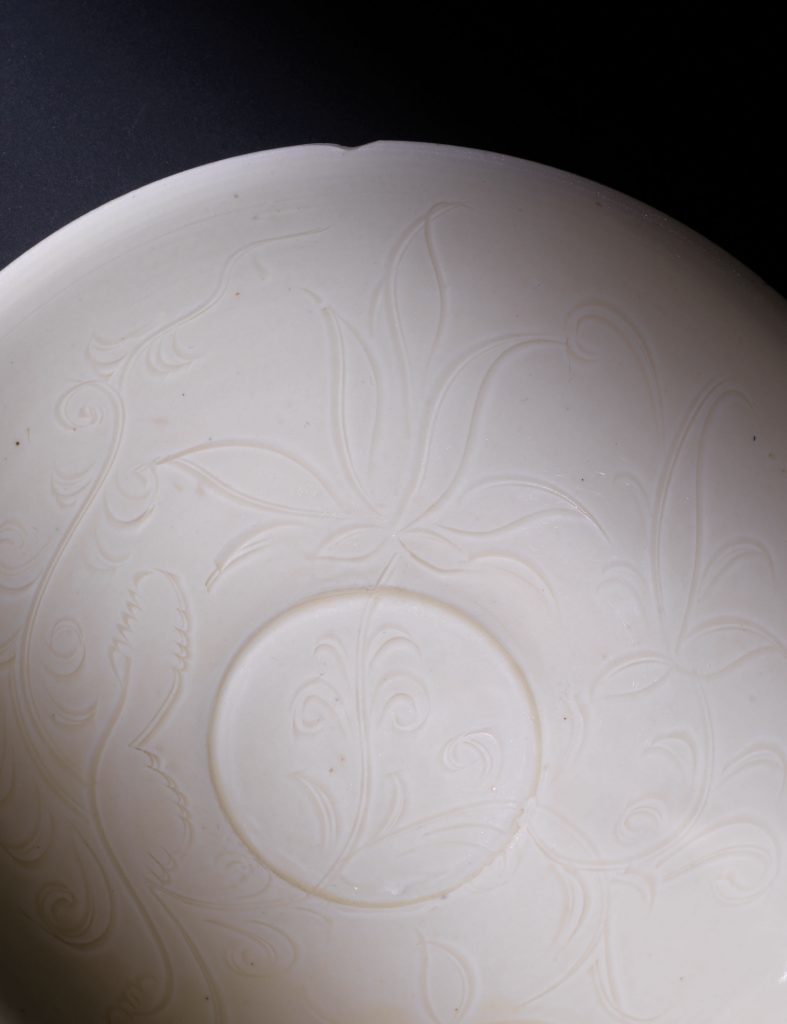
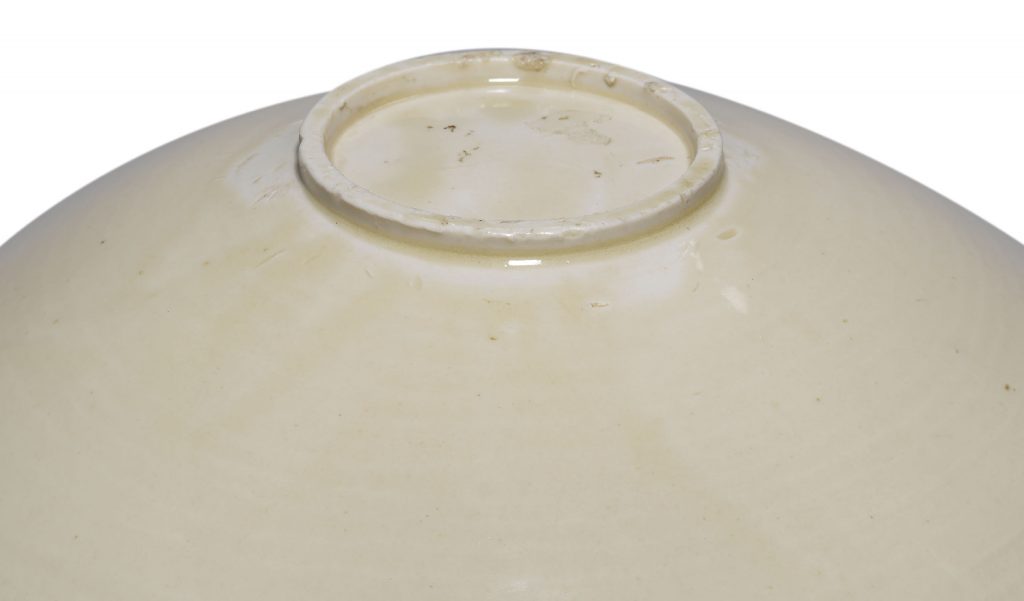
成交價 HKD 1,750,000
估價 HKD 1,200,000 – HKD 1,800,000
北宋 定窯刻蓮紋花口盌
NORTHERN SONG DYNASTY (960-1127)
細節
北宋 定窯刻蓮紋花口盌
盌敞口,六瓣式,淺弧腹,矮圈足。內壁刻三株長莖彎繞的蓮花及一片伸張蓮葉,內底平凹,外壁光素。通體施素雅象牙白釉,口沿露胎處呈現堅細白瓷胎。
7 3/4 in. (19.7 cm.) diam., box
來源
2000 年6 月12 日購自倫敦埃斯肯納齊
西方私人珍藏
倫敦邦瀚斯,2013 年5 月16 日,拍品7 號
狀況報告
謹請注意,所有拍品均按「現狀」拍賣,閣下或閣下的專業顧問應於拍賣前親自查看拍品以評鑑拍品之狀況。
-整體品相非常良好,惟外足沿有兩個非常小的淺磕,各約0.2公分
-口沿有數個微磕,於燒製時產生
拍品專文
潞公煎茶學西蜀,定州花瓷琢紅玉
-《試院煎茶》,蘇軾,熙寧五年(1072)
以上詩句節錄自《試院煎茶》,是北宋文豪蘇軾在熙寧五年當杭州通判時寫下的雜言古詩。裡面提到同僚文彥博(北宋宰相,著《文潞公集》)以西蜀古法煎茶,茶湯撞上有花紋的定窯白瓷,湯色泛紅,視覺效果有如經雕琢的紅玉。這兩句雖從沒提到「白」字,卻活靈活現地道出定窯瓷的晶瑩白潤,以及定窯器在當時為風雅文人所喜用的茶具。有趣的是,約二十年以後,在元祐八年(1093),蘇軾受命出知定州,可見蘇軾與定窯瓷有著不解之緣。其《定州謝到任表》裡的幾句「臣敢不勤恤民勞,密修邊備。茍無大過,以及期年。漸還魚鳥之鄉,以畢桑榆之景」,更透露出這位心繫家國的文人,兢兢業業地經營定州政務的心境。蘇軾以後,「定州花瓷」一語廣為文人所用,例如金人劉祁(1203-1259)《歸潛志》裡記「定州花瓷甌,顏色天下白」,可見時至金代晚期,有花紋的定窯白瓷依然深為文士所稱頌,並造就定窯瓷在後世歷久不衰的地位。
本盌器形雋雅靜謐,胎骨細白,釉光澄淨潤澤,刀工嫻熟流暢,為「定州花瓷」中之精品。可比較一件紋飾、器形幾乎一致的例子,為Oppenheim 舊藏,現藏大英博物館,著錄於《The World’s Great Collections: Oriental Ceramics》,卷5,圖版20 號。另一相似例曾著錄於1987 年東京出版《中國陶磁:出光美術館藏品圖錄》,後在2009 年12 月1 日於香港佳士得拍賣,拍品1863 號。亦有一件器形及尺寸相若例子,惟盌內蓮紋風格迴異,藏北京故宮博物院,著錄於《中國陶瓷全集 – 定窯》,上海,1981 年,圖版90 號。Alfred Clark 夫人及戴潤齋曾先後遞藏一件器形相似的定窯盌,盌內花紋略異,於2011 年3 月22 日紐約蘇富比拍賣,拍品167 號。
参考:佳士得
21 3月 2018 | 現場拍賣 14850
古韻天成-臨宇山人珍藏( 三 )
拍品 504
A SUPERB AND VERY RARE CARVED DING ‘PEONY’ DISH
北宋/金 定窯刻牡丹紋折沿盤
NORTHERN SONG-JIN DYNASTY (960-1234)
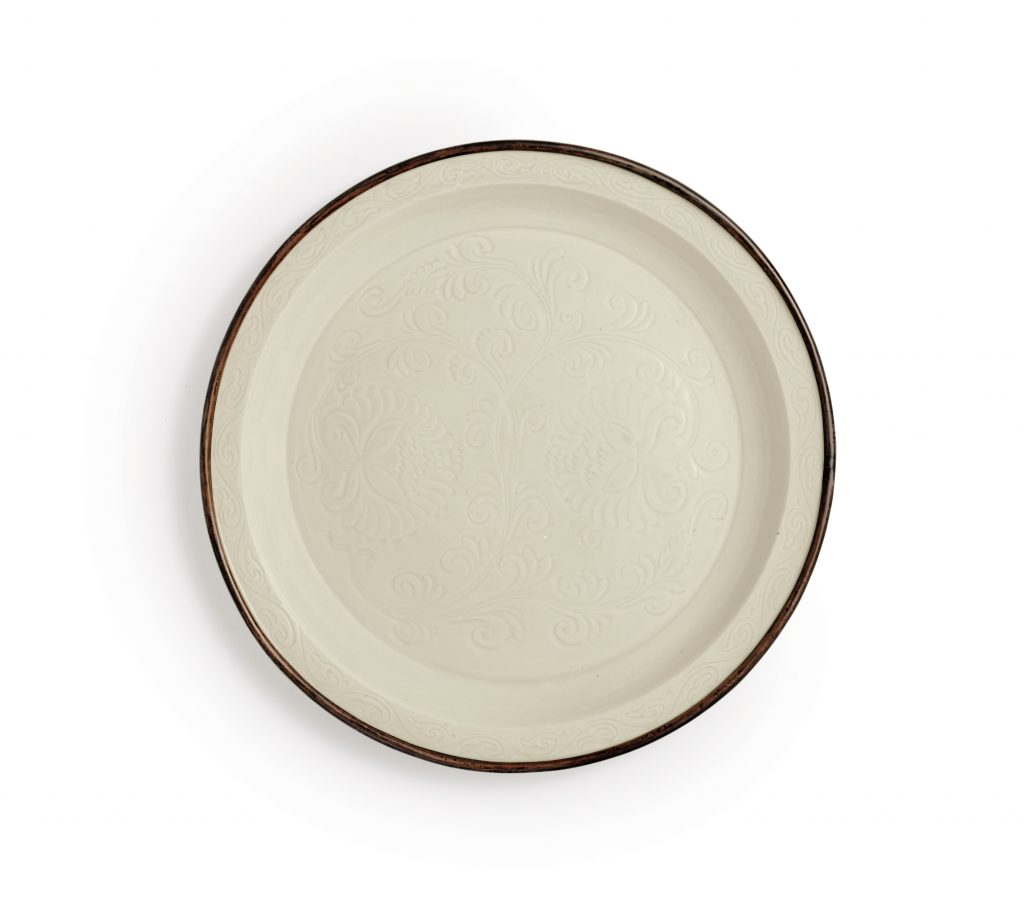
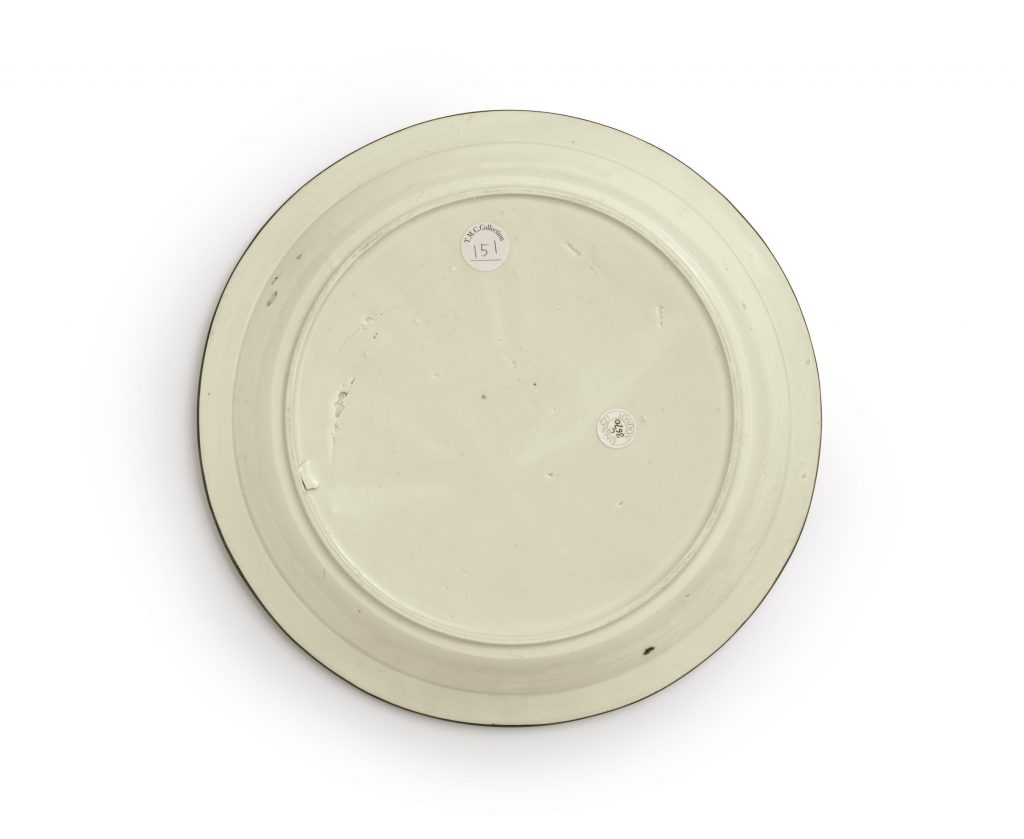
成交價 USD 948,500
估價 USD 400,000 – USD 600,000
北宋/金 定窯刻牡丹紋折沿盤
NORTHERN SONG-JIN DYNASTY (960-1234)
10 ¼ in. (26 cm.) diam., cloth box
來源
盧芹齋,1941年。
美國麻薩諸塞州Forbes家族珍藏。
埃斯肯納齊,倫敦,2007年3月,編號C3670。
出版
盧芹齋,《Exhibition of Chinese Arts, Special Sale》,紐約,1941年,編號570。
埃斯肯納齊,《Song Chinese ceramics 10th to 13th century (part 3)》,紐約,2007年,22-23頁,編號4。
佳士得,《古韻天成:臨宇山人宋瓷珍藏展覽》,香港,2012年,46-47頁,編號11。
展覽
盧芹齋,《Exhibition of Chinese Arts, Special Sale》,紐約,1941年11月1日至1942年4月30日。
埃斯肯納齊,《Song Chinese ceramics 10th to 13th century (part 3)》,紐約,2007年3月。
佳士得,《古韻天成:臨宇山人宋瓷珍藏展覽》,香港,2012年11月22至27日;紐約,2013年3月15至20日;倫敦,2013年5月10至14日。
狀況報告
We have sought to record changes in the condition of this piece acquired after its initial manufacture.
– appears to be in overall good condition
– the dish is slightly warped
– some expected minor wear and scratches to the surface
– the rim is covered with a metal band; the excat conditon of the rim is difficult to ascertain
拍品專文
定窯是五大名窯中唯一以紋飾見長者,素以其豐富多彩的紋飾和溫潤典雅的牙白釉著稱。本件定窯盤於內底飾折枝花一朵,雙花並蒂,舒展有致,為定窯劃花器的傑出代表。國立故宮博物院藏有一件與本品幾乎一致的定窯盤,載於蔡玫芬,《定州花瓷-院藏定窯系白瓷特展》,臺北,2014年,69頁,編號II-24。紐約大都會博物館亦藏有一件近似的定窯劃花盤,惟其花莖折向右側,見John Ayers,《Chinese Ceramics: The Koger Collection》,倫敦,1994年, 47頁,編號22。
此類定窯折沿大盤另有飾其它兩類劃花花卉紋者。其一飾與本盤構圖相似的折枝花,亦為雙花並蒂,惟其花瓣邊緣呈鋸齒狀,例如國立故宮博物院所藏之兩件,載於蔡玫芬,《定州花瓷-院藏定窯系白瓷特展》,臺北,2014年,72-73頁,編號II-27、28,以及故宮博物院所藏之一例,載於故宮博物院藏文物珍品全集《兩宋瓷器(上)》,香港,1996年,第154 頁,編號140。另一種飾纏枝花紋,於彎曲的莖上呈現綻放的蓮花、卷曲的蓮葉和蓮蓬,見波士頓美術館所藏一例,著錄於《Oriental Ceramics, The World’s Great Collections》,卷10,東京,1980年,編號16,2015年5月倫敦埃斯肯納齊展覽一例,載於《Principal Wares of the Song Period from a Private Collection》,編號6,以及東京國立博物館藏一例,載於《東京国立博物館所藏横河民輔コレクション : 中国陶磁名品選》,東京,2012年,編號22。
本盤中所飾之花紋在文獻中常被認爲是牡丹或菊花,然而其細窄層叠的花瓣和花形似乎更像是一種藝術化的造型,或為宋人所稱的寳相花、寳牙花之屬,見蔡玫芬,《定州花瓷-院藏定窯系白瓷特展》,臺北,2014年,69頁之討論。此种花卉圖像在定窯上最早見於北宋早期,如河北定州靜志寺地宮所出的一件長頸瓶肩部的紋飾,載於《中國出土瓷器全集》,卷3:河北,北京,2008年,98頁,編號98。這種紋飾亦流行於北宋早期的耀州窯和河南窯場深剔花品種上,參見安思遠舊藏的一件耀州窯小罐,2015年3月17日於紐約佳士得拍賣,拍品20號,以及華盛頓弗利爾美術館所藏的一件深剔花盤口瓶,載於《世界陶磁全集》,卷12:宋 ,東京,1977 年,109-110頁,編號109。相較之下,此式定窯盤上的第二類紋飾因其花瓣邊緣呈鋸齒狀,更接近牡丹花的形象。如上所述的這三類器形、尺寸相近,紋飾不同的定窯盤在當時可能為皇宮中成套使用者。
参考:佳士得
21 3月 2018 | 現場拍賣 14850
古韻天成-臨宇山人珍藏( 三 )
拍品 505
A RARE CARVED DING ‘CHILONG’ BRUSH WASHER
北宋 定窯刻螭龍紋洗
NORTHERN SONG DYNASTY, 11TH-12TH CENTURY
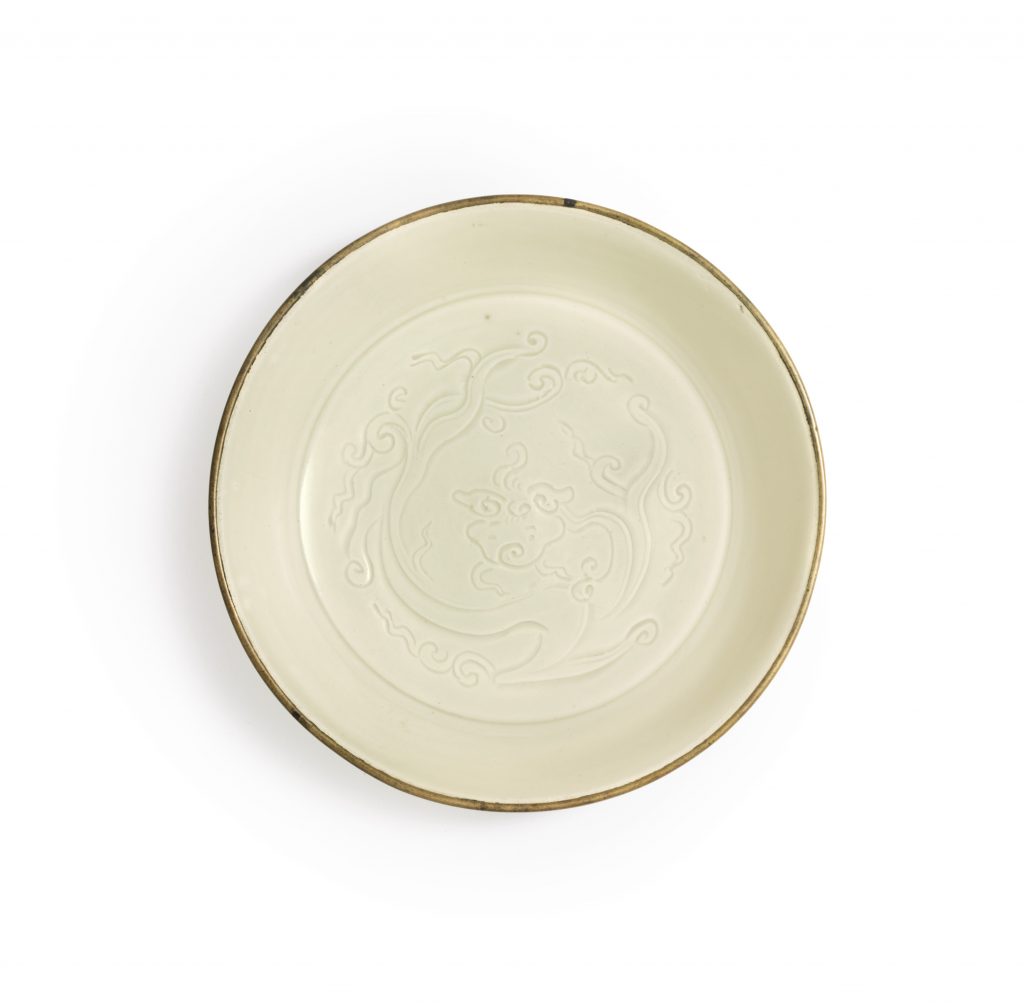
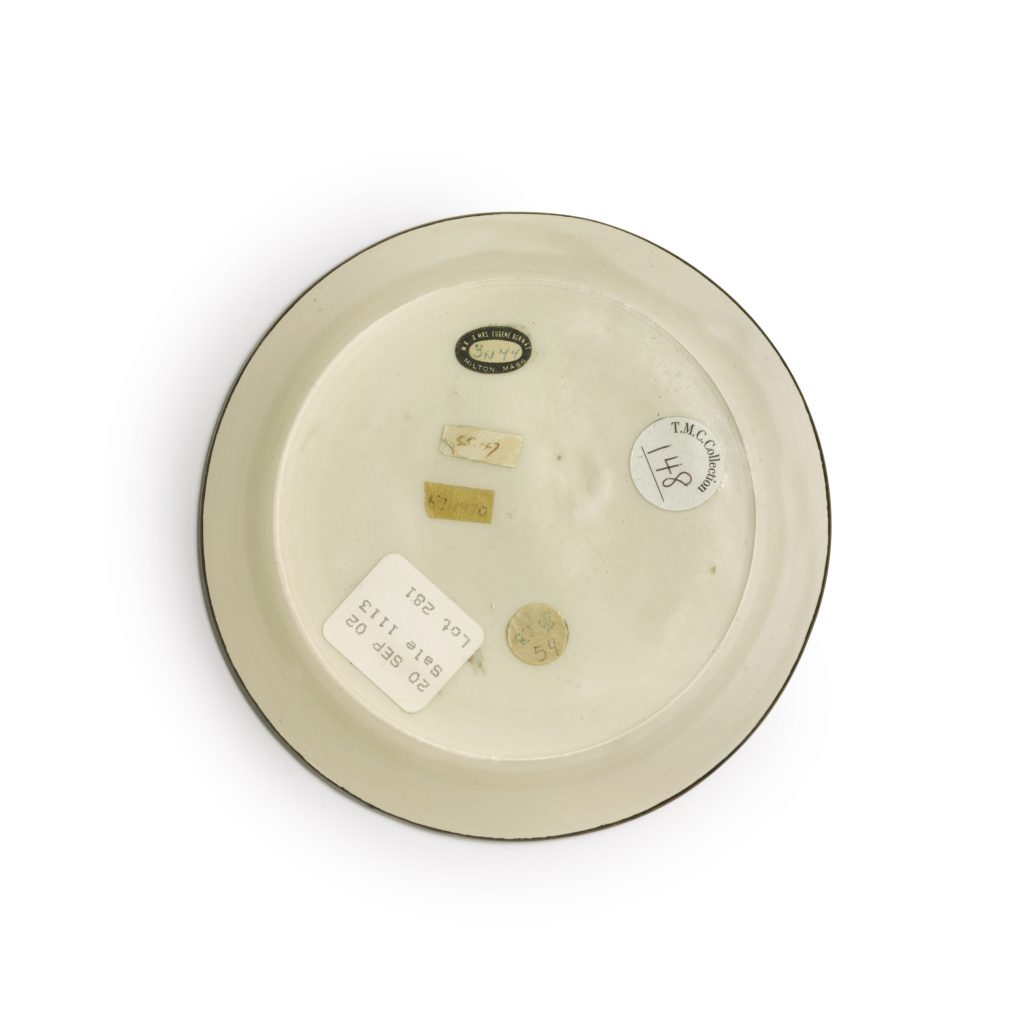
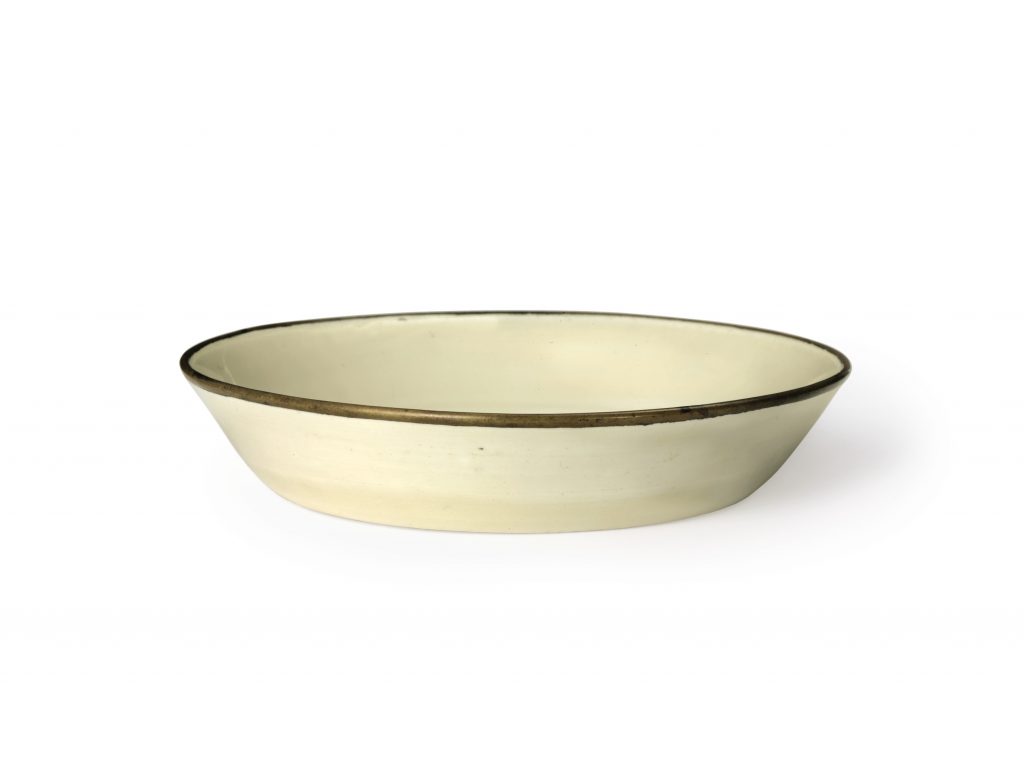
成交價 USD 468,500
估價 USD 60,000 – USD 80,000
北宋 定窯刻螭龍紋洗
NORTHERN SONG DYNASTY, 11TH-12TH CENTURY
北宋 定窯刻螭龍紋洗
5 ½ in. (14 cm.) diam., cloth box
來源
Eugene Bernat伉儷珍藏。
紐約蘇富比,1980年11月7日,拍品113號。
出版
波士頓美術館,《Exhibition of Chinese Ceramics Lent by Mr. and Mrs. Eugene Bernat》,1947年,波士頓,編號71。
The Currier Gallery of Art,《Chinese Ceramics of the Sung Dynasty》,新罕布什爾州曼徹斯特,1959年,編號11。
Smith College Museum,《Chinese Art: An Exhibition of Paintings, Jades, Bronzes and Ceramics》,麻薩諸塞州,1962年,編號114。
Sir Harry Garner、Margaret Medley合著,《Chinese Art》,卷3,倫敦,1969年,128頁,圖版17號,編號6。
佳士得,《古韻天成:臨宇山人宋瓷珍藏展覽》,香港,2012年,30-31頁,編號5。
展覽
波士頓美術館,《Exhibition of Chinese Ceramics Lent by Mr. and Mrs. Eugene Bernat》,1947年9月9日至10月19日。
The Currier Gallery of Art,《Chinese Ceramics of the Sung Dynasty》,新罕布什爾州曼徹斯特,1959年4月11日至5月31日。
Smith College Museum,《Chinese Art: An Exhibition of Paintings, Jades, Bronzes and Ceramics》,麻薩諸塞州,1962年。
借展於麻薩諸塞州Worcester Art Museum。
佳士得,《古韻天成:臨宇山人宋瓷珍藏展覽》,香港,2012年11月22至27日;紐約,2013年3月15至20日;倫敦,2013年5月10至14日。
狀況報告
We have sought to record changes in the condition of this piece acquired after its initial manufacture.
– appears to be in very good condition overall
– some expected minor wear and scratches to the surface
拍品專文
此洗清淡高雅,乃公元十一世紀末至十二世紀初最受宮廷推崇的河北定窰瓷器。雖然洗壁斜直、內外光素,但坦平內底飾一尾寓意吉祥的螭龍 (又名無角龍)。
螭是一種古老的神獸,其歷史至少可上溯至戰國時期 (公元前481-221年) 的文獻記載,形象大多為活潑生動的幼龍。顧名思義,「無角」曰螭,因無角之故,多被視為「未成年」之龍或幼龍,所以英文常直譯為「小龍」或「初生之龍」。單獨出現的螭大多回顧身後及尾部,構圖呈C形,本拍品即為一例。有些作品的螭龍身畔尚有一螭或雙螭,間或伴一成年之龍,人們常視之為母龍;若以「母子」形象出現,幼螭常在母龍身旁嬉戲追逐,或在其背上歡蹦亂跳。
螭與成年之龍系出同源,而且均寓意祥瑞,既象徵尊榮顯貴,亦含名成利就之祝願。再者,根據呂不韋 (公元前290至235年) 約於公元前239年著成的《呂氏春秋》所記,相傳孔子 (公元前551–479年) 曾比較龍、螭及魚,繼而以螭自況:「孔子曰:『龍食乎清而游乎清,螭食乎清而游乎濁,魚食乎濁而游乎濁。今丘上不及龍,下不若魚,丘其螭邪。』」(電子版參見http://ctext.org/lv-shi-chun-qiu/ju-nan/zh,英譯改編自John Knoblock 及Jeffrey K. Riegel合著的《The Annals of Lü Buwei》頁505 (加州:史丹福大學出版社,2005)。) 文中將螭與孔子相提並論,既確立了螭在中國神話的崇高地位,亦彰顯了它在各式裝飾藝術題材中的神聖意義。
以螭龍為飾的定窯器物,或如本拍品般僅飾一螭,或如上所述襯以別的螭龍。僅飾一螭者,其背景有的像此洗般光素無紋,有的則襯以朵朵祥雲或纏枝蓮紋。
國立故宮博物院藏有一件定窯劃花碟,器形、紋飾皆與本件洗如出一轍,惟其螭龍之刻劃稍顯草率,著錄於蔡玫芬著《定州花瓷-院藏定窯系白瓷特展》編號II-58(台北,2014年)。與此洗螭龍紋風格一致者還有一例北宋定窯瓷盌內底的紋飾,圖見Jan Wirgin所著《Sung Ceramic Designs》(倫敦:寒山堂,1979),原圖發表於《The Museum of Far Eastern Antiquities Bulletin》刊號42圖版70b (斯德哥爾摩:1970)。紐約佳士得曾於2014年9月18至19日拍出一例定窯盤 (拍品編號732),盤上所刻螭紋與本拍品類似,惟其四周飾纏枝蓮紋。另有一件洗壁斜直的近似例,其盤心刻祥雲螭紋,圖見國立故宮博物院編撰的中英雙語《故宮宋瓷圖錄:定窯‧定窯型》圖版60 (東京:學習研究室,1973)。同類器形飾雙螭者參見前述蔡玫芬著作編號II-59。
此洗與同場推出的臨宇山人典藏定窯黑釉鷓鴣斑盌 (拍品編號506) 一樣,均來自著名的波士頓白納德伉儷 (Eugene and Elva Bernat) 舊藏。白氏伉儷活躍於二十世紀中葉,其庋藏的中國早期陶瓷佳作雲集,數量逾150多件,年代由新石器時代至宋代不等。白氏珍藏的百多件宋瓷最為人津津樂道,這些珍品件件精奇,常亮相於特展和學術著作。各地博物館和私人珍藏均對白氏珍品趨之若鶩,自1980年11月舉行白氏珍藏專拍以來,其舊藏迄今仍散見於全球各大珍藏。
明代 (公元1368至1644年) 與清代 (公元1644至1911年) 收藏家均視定窯為宋代五大名窯之一,餘者為鈞、汝、官、哥四窯。定窯出品的瑩潤白瓷馳名天下,此外也有燒造赤褐及黑釉器,拍品中的臨宇山人珍藏定窯黑釉鷓鴣斑盌 (拍品編號506) 即為一例。雖然定窯本身並非御窯,即非官府運營或專為內廷燒製用瓷的窯口,但它在十世紀末、十一世紀及十二世紀初確曾燒造大批宮廷陶瓷。
毛瑞 (Robert D. Mowry)
哈佛大學藝術博物館亞洲部榮譽主任暨佳士得高級顧問
参考:佳士得
26 11月 2013 | 現場拍賣 3266
英國里埃斯科珍藏重要中國瓷器
拍品 3101
A DING CARVED ‘DAYLILY’ HEXAFOIL BOWL
北宋/金 定窰刻萱草紋六棱盌
NORTHERN SONG/JIN DYNASTY, 12TH-13TH CENTURY
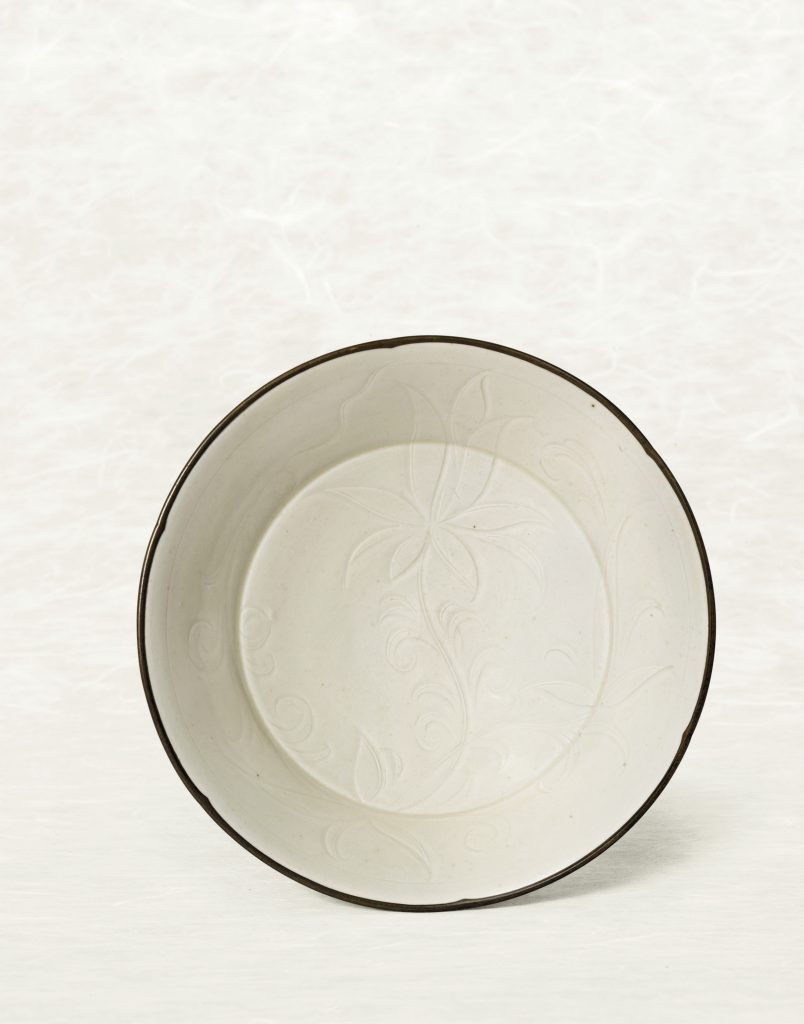
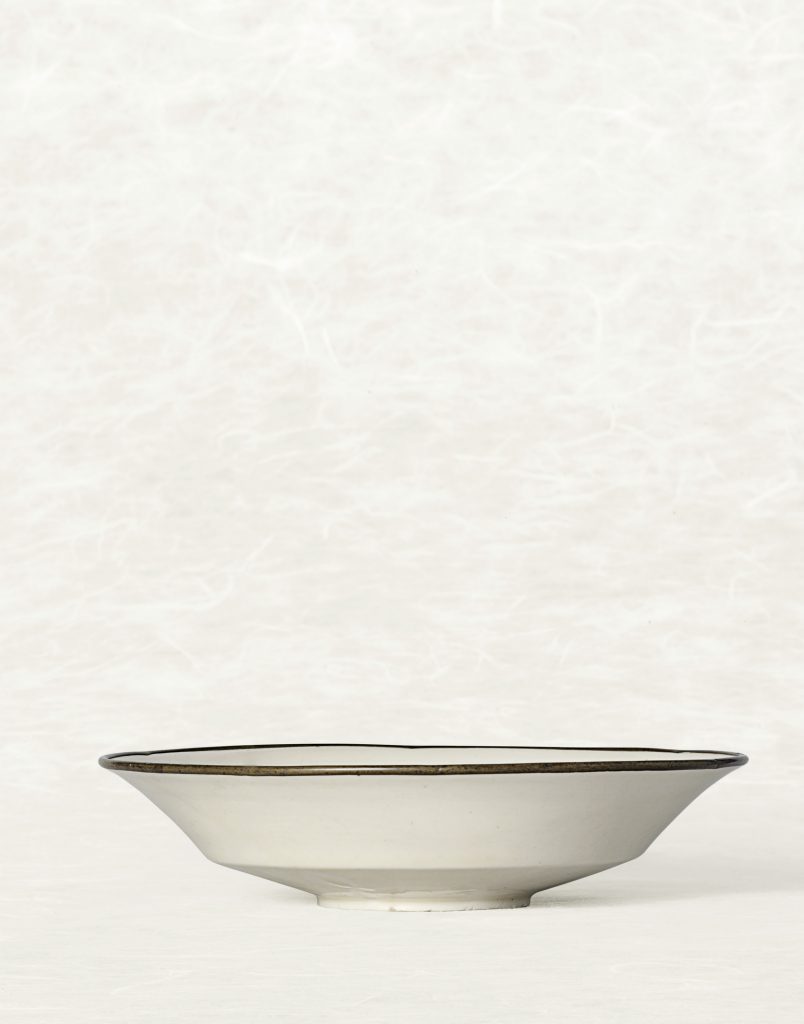
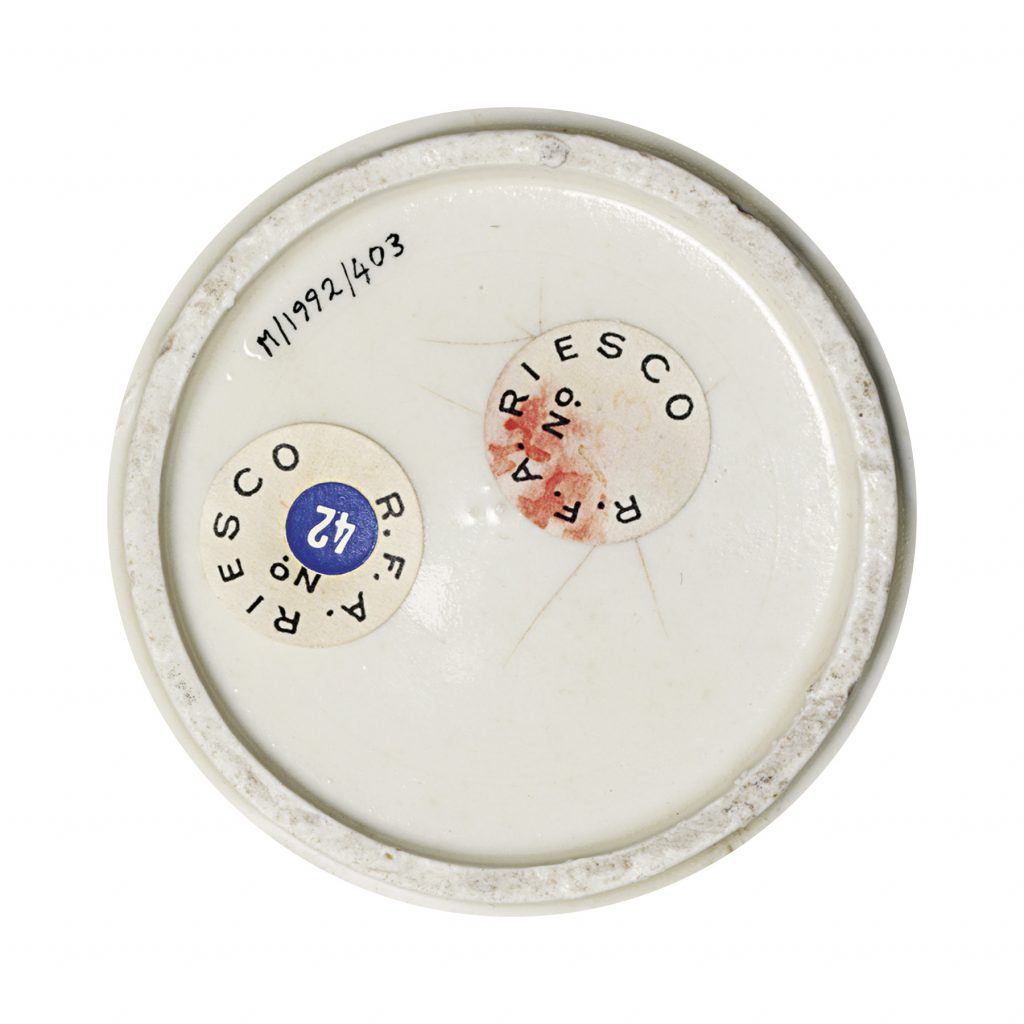
成交價 HKD 1,600,000
估價 HKD 1,500,000 – HKD 2,500,000
北宋/ 金 定窰刻萱草紋六棱盌
NORTHERN SONG/JIN DYNASTY, 12TH-13TH CENTURY
細節
盌敞口,外撇腹,近足內折,平底微出邊,圈足。盌心淺刻一折枝萱草紋,枝葉伸繞內壁。鑲銅口。
此器造型規整,秀麗典雅,釉色均勻,白中帶牙黃。花卉紋線條簡潔有力,似是任意揮灑的作品,陶匠運刀尤如運筆寫意,加上定窰白釉特有的溫潤晶瑩,使紋飾更顯得典貴優雅。
本盌形制配合內劃萱草紋的例子並不多見,遼寧省博物館收藏一件稍小例子,紋飾構圖略有不同,載於1981年上海出版《中國陶瓷全集.9.定窰》,編號70。臺北故宮博物院收藏三件近似的劃萱草紋定窰盤,見1987年台北出版《定窯白瓷特展目錄》,圖版111-113號。日本臨宇山人收藏一件盌例,載於2012年香港出版《古韻天成:臨宇山人宋瓷珍藏展覽》,圖版4號。北京故宮博物院收藏二件缽例,載於1996年香港出版故宮博物院藏文物珍品全集《兩宋瓷器 .上》,圖版47、55 號。
此器源自Alfred Shoenlicht(卒於1955 年);1955 年12 月13日於倫敦蘇富比拍賣,拍品56 號;1955 年購自倫敦Bluett & Sons。曾借展予波士頓美術館。著錄於1987 年克羅伊登博物館出版《Riesco Collection of Chinese Ceramics Handlist》,編號42。
里埃斯科收藏編號103p。
來源
Alfred Shoenlicht (d. 1955)
Sold at Sotheby’s London, 13 December 1955, lot 56
Bluett & Sons, London, 1955
Raymond F.A. Riesco Collection, no. 103p
拍品專文1 出版
天賦慧眼—收藏家里埃斯科
蘇玫瑰 亞洲藝術部資深學術顧問
本拍賣專集隆重呈獻英國企業家兼收藏家里埃斯科(1877-1964年)(圖一)舊藏之二十四件中國陶瓷。里埃斯科出生於英國,父親為南美洲人,母親為蘇格蘭人,他於四名子女中居長。 里埃斯科在倫敦克羅伊登市以南的南諾伍德渡過童年,他的南美藉父親卻不甚習慣英國天氣,亦經常出差。里埃斯科年僅十五歲就開始在一間小型保險公司工作,他表現極佳,深得上司器重,後來更引薦他轉職倫敦的大型保險公司Price Forbes,提議由他執掌業務。結果他與創辦人共同管理公司,直至退休為止。
1914年7月14日里埃斯科與Ada Mary Hovenden(1886-1968年)結婚,婚後育有二女一子。 1925年里埃斯科購入克羅伊登附近赫思費特之大宅(圖二),原來的房屋及花園頗為荒廢。他不惜斥資修建,設計出美侖美奐的花園,而大獲訪客好評。大宅落成包括露台、傳統花園、賞石花園、石楠花園、玫瑰花園。而他最大的心思在於庭園中廣植大樹成林;還遍植杜鵑,好等春天盛放燦爛;以及在草坪上種滿大朵紫丁香,形成一片幽香淡紫的花海。至於所置馬廄不單養畜兒女的小馬,同時提供世交Peter Thrale安置賽馬。里埃斯科夫婦非常好客,經常招待來自世界各地的訪客,他們的女兒Jean就記錄了俄羅斯皇室珠寶商法貝熱之兒子到訪(1984年出版Jean Thorpe著《“Heathfield” Remembered 1925-65》)。
二次世界大戰期間里埃斯科的倫敦辦公室約20名職員曾暫居赫思費特大宅,以逃避倫敦的砲火,該宅雖遭轟炸,只命中農場,無人受傷。1954年里埃斯科退休後,他專心管理大宅附屬的農場,打造出「模範農場」。
里埃斯科除保險事業外,並有不少嗜好。夫婦二人經常出門旅行,尤其到美國、加拿大、南非,里埃斯科夫人有姊妹居於南非約翰內斯堡。他們特別喜歡從海路出發,當時流行遠洋遊輪,他們乘搭過冠達郵輪旗下的瑪麗皇后號、阿奎坦尼亞號、茅利塔尼亞號,以及北德意志羅伊德郵輪旗下的不來梅號。他們從郵輪上寄回明信片及其他小紀念品,均存放於家庭相簿。里埃斯科亦是著名的集郵專家,並收藏水彩畫及蝕刻畫。他的郵票珍藏於二次世界大戰以前已出售。自1935年起他專注收藏中國陶瓷,1951至1961年間並列席東方陶瓷學會委員會,期間借出藏品予該會多次展覽。本專集中三件拍品就曾展出於1946年舉辦展覽《Ming Blue-and-White Porcelain》(拍品3107、3117、3119),參展的還有他的另外三件藏品。1953-54年舉辦的展覽《Loan Exhibition of Chinese Blue and White Porcelain 14th to 19th Centuries》,他亦是籌備委員,並以四十六件藏品參展,包括這次拍賣的八件青花瓷(拍品3105、3107、3108、3111、3113、3116、3117、3119)。1957年舉辦的展覽《Loan Exhibition of the Arts of the Ming》,他再次出任展覽委員,並以十二件藏品參展,其中六件於本次拍賣(拍品3114、3117、3118、3119、3121、3122);至於該參展者均是顯赫的收藏家,包括瑞典國王、倫敦大維德爵士、帕爾默伉儷。自里埃斯科藏品轉贈克羅伊登市後,其中四件又參展了1971年舉辦的大型展覽《The Ceramic Art of China》,它們亦於本次拍賣(拍品3109、3114、3117、3121)。
里埃斯科亦是東方陶瓷學會的慷慨捐助人,更發起成立學會捐贈基金。他並將一系列明瓷贈予大英博物館(2001年倫敦出版 J. Harrison-Hall著《Ming Ceramics in the British Museum》,594頁)。1964年他逝世後,倫敦克羅伊登市議會買下里埃斯科家族赫思費特大宅,以及相連的倫敦南部阿丁頓地皮,他餘下的中國陶瓷藏品大部份亦收歸克羅伊登市名下。 第一次世界大戰結束時,里埃斯科從倫敦Bluett & Sons購藏最早的藏品,但直至1935年舉辦的《倫敦中國藝術國際展覽會》,才啟發他認真收藏中國瓷器。根據Bluett & Sons的銷售檔案,里埃斯科曾於該古董商購買逾500件物品,最後一次為他逝世前三年之1961年(CARP出版Dominic Jellinek著作「Bluett Essay(Part 2)」)。
他的女兒Jean憶述當時父親的中+國陶瓷收藏遠不及後來的豐富,其中一些於二次大戰期間曾裝箱埋在花園,以保安全(《“Heathfield” Remembered 1925-65》)。她並記得父親最早的中國陶瓷藏品中有一件唐三彩馬,年幼的子女看到它缺了尾巴而大失所望,里埃斯科遂走進馬廄,剪下家中威爾斯種小馬的尾毛,插於唐三彩馬。今天該馬還留著這條馬尾毛,現收藏於克羅伊登鐘樓里埃斯科展覽廳,與其他藏品一起展出(圖三)。 自1935年起里埃斯科開始建立他的中國陶瓷珍藏,集中搜集明清瓷器,亦著眼於較早朝代的珍品(圖四︑五),贏得一位同輩讚許他對中國陶瓷獨具慧眼。里埃斯科對每件購藏物品皆手書詳細記錄,集結成三冊收藏目錄。這些收藏記錄逾740項,其中一些為成對或成組藏品,而第三冊的附錄註有少量日本陶瓷。他的陶瓷藏品起自新石器時代陶器,直至清瓷精品,1951年出版的《Antique Collector》六月、八月、十月號就刊載了Edgar Bluett介紹這批藏品的三篇文章,後來更結集成書《The Riesco Collection of Old Chinese Pottery and Porcelain》,並增訂插圖。很明顯里埃斯科希望建立一個完整系列的藏品,以代表中國陶瓷的發展史,然而他個人還是偏愛宋瓷珍品,尤好明瓷,以及清康雍乾三朝精品。 此次拍賣包羅的大部份為明瓷,亦有三件較早年代的珍品,它們在里埃斯科收藏以前,來源非常顯赫。
宋代定窰刻花盌(拍品3101)為紐約及海牙收藏家Alfred Schoenlicht舊藏,1955年他逝世後其珍藏在倫敦拍賣。金/元鈞窰紫斑盌(拍品3103)為英國銀行家William Cleverley Alexander(1840-1916年)舊藏,他以藝術藏品豐富而聞名。珍罕的官用青瓷盌(拍品3104)為Alfred Chester Beatty(1875-1968年)舊藏,他後來獲封爵士,的其他藏品現收歸愛爾蘭都柏林切斯特比特圖書館。 這次拍品中大部份明清瓷器在里埃斯科收藏以前已有著錄。永樂青花纏枝花卉紋盌(拍品3106)、成化青花嬰戲圖盌(拍品3113)均源自Archibald Dooley Brankston(1909-1941年)舊藏。他在中國出生,曾參與籌備1935年舉辦的《倫敦中國藝術國際展覽會》。他後來繼任Robert L. Hobson成為大英博物館東方文物部助理館長,並於1938年出版著作《Early Ming Wares of Chingtechen》,這次珍罕的宣德青花蓮子盌(拍品3109)亦是他的舊藏,並載於著作中,圖版5a。瑰奇的宣德青花葫蘆式扁瓶(拍品3111)先後為法國駐北京大使、JohnFrederick Woodthorpe(1897-1966年)收藏。John Frederick Woodthorpe是大法官署的主事官,他活躍於東方陶瓷學會。
永樂青花折沿大盤(拍品3105)原屬著名的博學收藏家大維德爵士所有,他的藏品獲譽為中國以外最佳的私人收藏。罕見的大型宣德饅頭心盌(拍品3107)源自英國少校 Lindsay Fitzgerald Hay(1891-1946年)舊藏,他任職英國陸軍之高地兵團,身高6呎11吋,以收藏古董汽車及明瓷見稱。珍罕的成化青花蓮托八寶紋盤(拍品3112)來自1930年代北京著名古董商吳賚熙。雅緻的弘治綠彩雲龍紋盤(拍品3115)曾為希臘大亨George Eumorfopolous(1863-1939年)收藏,他是東方陶瓷學會的首任會長(任期1921-1939年)。他的中國陶瓷收藏結集成六冊巨著,由Robert L. Hobson(1872-1941年)編纂。
精美的弘治黃地青花梔子花紋盤(拍品3114)曾讓里埃斯科放到花園中拍照(圖六),以採得最好的自然光度,它源自Francis Howard Paget(卒於1945年)舊藏,他曾參與1935年《倫敦中國藝術國際展覽會》,並捐贈一些珍貴的明瓷予大英博物館。同樣為黃地青花紋飾的嘉靖穿花鳳紋盤(拍品3118)曾為Charles G. Seligman(1873-1940年)教授之夫人Brenda Z.(卒於1965年)收藏,Seligman伉儷是倫敦1935年舉辦中國藝術展覽的主要參展者,他們二人共同購藏、Brenda Z.後來購入的藏品,均著錄於1964年出版John Ayers所編二冊圖錄。罕有的康熙釉裏紅夔鳳紋雙陸尊(拍品3123)原為一對,這件源自英國元帥Horatio Herbert Kitchener(1850-1916年)舊藏,他後來獲封第一代喀土穆伯爵,豐功偉績廣受歌頌,第一次世界大戰時其肖像更印成召募軍兵海報。
此次拍品中不乏稀世珍品,以明十五世紀青花瓷最多,那是無數鑑藏家視為中國青花瓷的黃金時代。經典之一的宣德葫蘆式扁瓶(拍品3111),鼓圓上部口沿書六字橫款,它巧妙地融合中國與中東的風格,不但備受西域諸國貴冑的珍賞,更獲明十五世紀初宮廷的垂青,南京皇城遺址曾出土同款器物的瓷片,足以佐證(1996年香港出版《朱明遺萃:南京明故宮出土陶瓷》,48頁,編號52)。
另一件珍品為宣德青花纏枝蓮瑞果紋盤(拍品3108),盤心飾不同造型的蓮紋相間,內壁繪寫實折枝果紋,屬鳳毛麟角的例子,惟見臺北故宮博物院收藏一件稍小而直沿的近似例子,其盤心蓮紋與本盤相若(1998年台北出版《明代宣德官窯菁華特展圖錄》,426-427頁,圖版186號)。
第三件是成化青花庭園嬰戲圖盌(拍品3113),傳統上成化與宣德同譽為明青花瓷的經典時期,早於唐代中國裝飾藝術已出現嬰戲圖,紋飾象徵兒孫滿堂、家族興旺的祝願,參考天民樓收藏一件罕有的永樂青花嬰戲圖盌(1987年香港出版《天民樓藏瓷.上》,圖版15)。至成化皇帝因殷切祇求子嗣,下命製造大量多子紋飾的工藝品。
其他拍品包括明中葉、清康熙的精品。
里埃斯科獨具慧眼所購藏的名瓷,除多次參展東方陶瓷學會展覽外,其中五件曾展出於威尼斯1954年舉辦展覽《Arte Cinese》(拍品3107、3108、3116、3121、3122),以及著錄於中國陶瓷重要著作,例如1954年倫敦出版Harry Garner著《Oriental Blue and White》(拍品3109、3111、3116)。此次拍賣的里埃斯科珍藏,無疑展現出一位資深收藏家對中國陶瓷孜孜以求的心血。
展覽
On loan at the Museum of Fine Arts, Boston, prior to 1955
狀況報告
We have sought to record changes in the condition of this piece acquired after its initial manufacture.
– There are two small star cracks to the underside of the base, one of which can be seen from the interior of the dish.
– There is one minute shallow chip to the inner mouth rim and a few minute nicks to the foot rim.
– Some general surface scratches and wear as expected from use and age.
拍品專文2
The present bowl is a classic example of the finest Ding wares of the 12th-13th century. The form, almost certainly derived from metalwork, is one that provided a significant test for its potter particularly when combined with carved decorations. In order to achieve the sharp junction between base and sides, the thrown dish had to be placed over a wooden form and pressed down to achieve the sharp junction between base and sides. This process was rendered more difficult because the decoration had already been carved into the interior of the dish and risked being squashed in the forming process. It is a measure of the potter’s skill that the decoration remains crisp and distinct, and the current bowl stands as a testimony to such artistry, demonstrating a synergy of elegant form and fluid design.
Daylily blossoms was a popular motif on Ding wares from mid-Northern Song to Jin periods, and can be found on other open forms such as shallow dishes, conical bowls and deep bowls. Compare to a similar shallow bowl carved with the same motif, but bearing slight variation in composition, in the Liaoning Provincial Museum, and illustrated in Zhongguo taoci quanji – 9 – Dingyao, Shanghai renmin meishu chubanshe, 1981, no. 70. For the same carved motif on other forms, compare to three shallow dishes in the National Palace Museum, Taipei, illustrated in Catalogue of the Special Exhibition of Ting Ware White Porcelain, Taipei, 1987, nos. 111-113; a conical bowl included in the catalogue of The Classic Age of Chinese Ceramics: An Exhibition of Song Treasures from the Linyushanren Collection, Hong Kong, 2012, no. 4; and two deep bowls in the Palace Museum, Beijing, illustrated in Porcelain of the Song Dynasty (I), The Complete Collection of Treasures of the Palace Museum, Hong Kong, 1996, nos. 47 and 55. Other motifs carved on bowls of this form include ducks in lotus pond, such as an example illustrated by G. Hasebe in Sekai Toji Zenshu – 12 – Song, Tokyo, 1977, pl. 143, and a peony spray, as shown on a bowl sold at Christie’s New York, 22 March 2013, lot 1441.
拍品專文3
A Collector of Instinctive Good Taste Rosemary Scott, International Academic Director, Asian Art This season we are delighted to offer a select group of 24 Chinese ceramics from the collection of the British businessman and connoisseur Raymond F. A. Riesco (1877-1964) (fig. 1). Raymond Riesco’s father was from South America, while his mother was Scottish. Born in England, the eldest of four children, Raymond Riesco was christened Ramon Francesco Alfredo Riesco, but later, encouraged by his wife, he anglicised his given names to Raymond Francis Alfred, keeping only his surname in its original form. However, to his many friends he was ‘Jimmy’ Riesco. His early childhood was spent in South Norwood, in the south London borough of Croydon, although his South American father disliked the English climate and frequently worked abroad. At the age of fifteen Raymond Riesco began work in a small insurance office. He proved to be extremely able, and after a successful career in this small company, his employer introduced him to the much larger firm of Price Forbes in the City of London, suggesting that Riesco might run the firm. Eventually he did indeed run the firm with Mr. Forbes, until he retired. On 14 July 1914 Raymond Riesco married Ada Mary Hovenden (1886-1968), with whom he had three children – two daughters and a son. In 1925 Riesco bought ‘Heathfield’ (fig. 2) near Croydon. Both the house and grounds had been somewhat neglected but Riesco expended considerable funds and effort in restoring them, creating gardens that were greatly admired by visitors. There were terraces, a formal garden, a rock garden, a heather garden, and a rose garden, but one of Riesco’s greatest inspirations was to plant many mature trees, creating woods, as well as having rhododendrons and azaleas, whose flowers provided banks of brilliant colour in spring, while the large Chinese lilac on the lawn produced wonderfully fragrant pale mauve blossoms. The stables not only housed the Riesco children’s ponies, but were used by a family friend, Peter Thrale, for his racehorses. Riesco and his wife enjoyed entertaining and welcomed visitors from all over the world, including, as his daughter Jean has recorded, a Mr. Faberg?, son of the famous Russian court jeweller (Jean Thorpe, “Heathfield” Remembered 1925-65, 1984). During the Second World War about 20 members of staff from Riesco’s London office also moved into ‘Heathfield’ to escape the London bombings, and, although a flying bomb did hit the farm, no one was hurt. After Riesco retired in 1954 he took over the management of the farm, which was part of the estate, and ‘ran it as a model farm’. Riesco had many interests outside the insurance business. He and his wife enjoyed travelling – particularly to the United States, Canada and South Africa. His wife had a sister in Johannesburg, South Africa. They particularly enjoyed travelling by sea in the age of the grand ocean liners, and they were able to make voyages on Cunard’s Queen Mary, Aquatania, and Mauretania, and Norddeutscher Lloyd’s Bremen – sending back post cards and other mementos, which were put in albums by the family. Riesco was an acknowledged authority on philately, and also had a collection of watercolours and etchings. His collection of stamps was sold before the Second World War, but after 1935 he gave serious attention to the collection of Chinese ceramics. From 1951 to 1961 he served on the Council of the Oriental Ceramic Society, and he loaned pieces from his collection to various of the exhibitions held by the Society. Indeed he loaned three of the pieces in the current sale to the Society’s 1946 exhibition of Ming Blue-and- White Porcelain (Lots 3107, 3117 and 3119) – three further pieces belonging to Riesco were also included in this exhibition. Raymond Riesco was on the Exhibition Committee of the OCS Loan Exhibition of Chinese Blue and White Porcelain 14th to 19th Centuries, held in London in 1953-4, loaning 46 pieces from his own collection, including eight of the undeglaze blue decorated porcelains in the current sale (Lots 3105, 3107, 3108, 3111, 3113, 3116, 3117, and 3119). Riesco was also on the Exhibition Committee of the 1957 OCS Loan Exhibition of the Arts of the Ming, in which twelve of his own pieces were displayed, including six of the porcelains in the current sale (Lots 3114, 3117, 3118, 3119, 3121, and 3122). This was a very prestigious exhibition and his pieces were shown alongside those belonging to other great collectors such as H.M. the King of Sweden, Sir Percival and Lady David, and Mr. and Mrs. R.H.R. Palmer. After the Riesco collection was acquired by the London Borough of Croydon, four of the items in the current sale were loaned to the Oriental Ceramic Society’s major 1971 exhibition The Ceramic Art of China (Lots 3109, 3114, 3117, and 3121). Raymond Riesco was also a generous benefactor to the OCS, and initiated the setting up of the Society’s endowment fund. He also bequeathed a selection of Ming dynasty ceramics to the British Museum (see J. Harrison-Hall, Ming Ceramics in the British Museum, London, 2001, p. 594). The majority of the remaining pieces from Riesco’s Chinese ceramic collection were acquired by the London Borough of Croydon when the Council purchased Mr Riesco’s home, Heathfield House, and surrounding land in Addington, south London, following his death in 1964. Riesco appears to have made some of his first purchases of Chinese ceramics from the firm of Bluett & Sons in London at the end of the First World War, but it was not until after the International Exhibition of Chinese Art held in London in 1935 that he was inspired to form a significant collection. The archives of Bluett’s show that Riesco purchased more than 500 pieces from the company, and his last purchase from them was in 1961, only three years before his death (Dominic Jellinek, ‘Bluett Essay (Part 2), CARP). His daughter Jean Thorpe (n?e Riesco) recalls that although his collection of Chinese ceramics was not then as extensive as it would later become, some of the pieces were buried in the garden in packing cases during the Second World War to keep them safe (Jean Thorpe, “Heathfield” Remembered 1925-65, 1984). Riesco’s daughter Jean has also recalled that one of the first items of Chinese ceramics which her father bought was a Tang dynasty horse. When it arrived at their home, the children of the family were young enough to be disappointed that the horse had no tail. Raymond Riesco therefore went out into the paddock, cut some of the hair from the tail of their little Welsh pony ‘Taffy’ and attached these to the Tang horse. Today the Tang horse still has its ‘real’ tail, and is on display in the Riesco Gallery at Croydon Clocktower with other items from the Riesco collection (fig. 3). From 1935 Riesco set about assembling a fine collection of Chinese ceramics, concentrating on the porcelains of the Ming (1368-1644) and Qing (1644-1911) dynasties, but including pieces from the earlier periods (fig. 4 and fig. 5). He was described by one of his contemporaries as having instinctive good taste in his selection of Chinese ceramics. Each of Riesco’s purchases was meticulously recorded, in his own hand, in one of the three volumes which form an inventory of his collection. This hand-written inventory includes more than 740 entries – some of them pairs or sets – while the third volume records, in an appendix, a small number of Japanese ceramics. The scope of the collection, which ranges from the cold-painted earthenwares of the Neolithic period to the fine porcelains of the Qing dynasty, was described by Edgar Bluett in a series of three articles for the Antique Collector published in June, August and October 1951. These articles were later published in book form, entitled The Riesco Collection of Old Chinese Pottery and Porcelain, with additional illustrations. Although he evidently wished to construct a collection which would exemplify the historical development of Chinese ceramics, it is clear that Raymond Riesco had a personal preference for fine wares of the Song dynasty, and, most especially, porcelains of the Ming dynasty, as well as those from the reign periods of the three great Qing emperors – Kangxi, Yongzheng and Qianlong. While the ceramics in the current sale are predominantly porcelains from the Ming dynasty, smaller number of exceptional early wares are included. Three of these had been in important collections even before they were purchased by Riesco. The exquisite Song dynasty Ding ware dish with carved daylily decoration (Lot 3101) was in the collection of Alfred Schoenlicht – resident of New York and the Hague, whose fine collection was sold in London after his death in 1955; the impressive Jin-Yuan dynasty splashed Jun ware bowl (Lot 3103) was in the famous collection of William Cleverley Alexander (1840-1916) – a wealthy English banker with an extensive collection of art; and the rare lobed Guan ware bowl (Lot 3104) was in the collection of Alfred Chester Beatty (1875-1968), later Sir Alfred Chester Beatty, whose remaining collection is now in the Chester Beatty Library in Dublin. A large proportion of the Ming and Qing porcelains in the current sale also had illustrious histories before entering the Riesco collection. The vibrantly painted Yongle bowl (Lot 3106) and the rare Chenghua ‘boys’ bowl (Lot 3113), were both formerly in the collection of Archibald Dooley Brankston (1909-41), who was born in China, was involved in the preparations for the 1935 International Exhibition of Chinese Art, and succeeded Robert L. Hobson as Assistant Keeper in the Department of Oriental Antiquities at the British Museum. He was also the author of Early Ming Wares of Chingtechen, published in 1938, and the very rare lianzi bowl (Lot 3109) had also belonged to him, and was illustrated in his Early Ming Wares of Chingtechen, as plate 5a. The beautiful and rare Xuande (1426-35) double gourd-shaped vase (Lot 3111), was previously in the collection of the French Ambassador to Peking and that of John Frederick Woodthorpe (1897-1966), a Master of the Supreme Court, Chancery Division, who was also an active member of the Oriental Ceramic Society. The large finely-painted blue and white dish (Lot 3105) had belonged to the revered collector and scholar Sir Percival David (1892-1964), who was generally acknowledged to have the finest private collection of Chinese ceramics outside China. The unusually large Xuande ‘sugar loaf base’ or CY mantou xin bowl (Lot 3107) was formerly in the collection of Major Lindsay Fitzgerald Hay (1891-1946) – an officer in the Black Watch who was known for his exceptional height (6 feet 11 inches) and his collections of classic cars and Ming porcelain, while the rare Chenghua dish with lotus scrolls bearing the Eight Buddhist Emblems (Lot 3112) had been with Wu Lai-Hsi, a well-known dealer in Beijing in the 1930s. The striking Hongzhi ‘green dragon’ dish (Lot 3115) had been in the collection of George Eumorfopolous (1863-1939), a Greek tycoon, who was the first president of the Oriental Ceramic Society (1921-39), and whose Chinese ceramic collection was published in six folio volumes, catalogued by Robert L. Hobson (1872-1941). The fine Hongzhi dish with underglaze blue fruit and flowers against a yellow enamelled ground (Lot 3114), which Riesco photographed in his garden to get the full effect of the colours in natural light (fig. 6), had come from the collection of Francis Howard Paget (d. 1945), who was one of the lenders to the 1935 exhibition and bequeathed a number of rare Ming porcelains to the British Museum, while the Jiajing ‘phoenix’ dish in the same palette (Lot 3118) had been in the collection of Mrs. Brenda Z. Seligman (d. 1965), widow of Professor Charles G. Seligman (1873-1940) – they too were major lenders to the 1935 exhibition, and the pieces they acquired together and those acquired by Mrs. Seligman after her husband’s death were published in two volumes by John Ayers in 1964. The extremely rare Qing dynasty Kangxi mallet vase with underglaze copper red decoration (Lot 3123) is one of a pair that had been in the collection of Field Marshall Horatio Herbert Kitchener, 1st Earl Kitchener of Khartoum (1850-1916), much decorated military officer whose image was used on recruiting posters during the First World War, encouraging young men to enlist in the armed forces. The group of vessels in the current sale include many exceptional pieces, but is particularly rich in blue and white porcelains from a period which many connoisseurs regard as the Golden Age of Chinese blue and white – the 15th century. Among the highlights is a rare and elegant Xuande (1426-35) double gourd-shaped vase, which bears a six-character Xuande reign mark written horizontally around the upper bulb (Lot 3111). This vase reflects an especially successful melding of Chinese and Near Eastern inspiration, which was appreciated by wealthy patrons in countries to the west of China, and by the Chinese court of the early 15th century, as evidenced by the discovery of a fragment of a similar flask in the ruins of the early Ming dynasty imperial palace at Nanjing (illustrated in A Legacy of the Ming, Hong Kong, 1996, p. 48, no. 52). Another highlight from the Xuande reign period is the beautiful dish with a lotus scroll in the central roundel and exquisitely painted naturalistic fruiting sprays on the interior walls (Lot 3108). The delicate variegated lotus scroll on the interior of this dish is exceedingly rare, however an identical scroll can be seen on the interior of a slightly smaller, straight-rimmed, dish in the collection of the National Palace Museum, Taipei (illustrated in Catalogue of the Special Exhibition of Selected Hs?an-te Imperial Porcelains of the Ming Dynasty, Taipei, 1998, pp. 426-7, no. 186). A third important piece in this group is a bowl from the reign period traditionally lauded, alongside the Xuande reign, as producing the finest porcelains of the 15th century. This is the reign of the Chenghua Emperor (1465-87), and a particularly delightful bowl in the current sale is decorated with a scene of boy children playing in a garden (Lot 3113). As early as the Tang dynasty (AD 618-907) images of young boys at play was a popular secular theme on the Chinese decorative arts, being viewed as an auspicious symbol associated with the wish for sons and grandsons, and thus the continuation of the family line as well as the prosperity of the family. This decorative motif appears on rare, blue and white porcelain bowls of the Yongle reign (1403-24), such as that in the Tianminlou collection (Illustrated in Chinese Porcelain – The S.C. Ko Tianminlou Collection, Hong Kong, 1987, p. 43, no. 15), but in the Chenghua reign this decorative theme was particularly favoured by the Emperor, whose desire for an heir led to his commissioning items with auspicious wishes for sons and grandsons. The group of porcelains in this sale also includes outstanding items from the middle Ming period as well as very rare pieces from the Qing dynasty Kangxi reign. It is a measure of the quality of Raymond Riesco’s collection that, as well as appearing in exhibitions organised by the Oriental Ceramic Society, five of the pieces in the current sale were included in the prestigious Arte Cinese exhibition, Venezia, 1954 (Lots 3107, 3108, 3116, 3121, and 3122) and a number have been illustrated in seminal works on the subject of Chinese ceramics, such as Sir Harry Garner’s Oriental Blue and White, London, 1954 (Lots 3109. 3111, and 3116). The Riesco collection was assembled with great care by a man who seems to have had an instinct for exceptional Chinese ceramics.
参考:佳士得
26 11月 2019 | 現場拍賣 16696
重要中國瓷器及工藝精品
拍品 3058
A VERY RARE LARGE DING CARVED ‘FISH’ BOWL
北宋/金 定窯白瓷刻魚藻紋大盌
NORTHERN SONG-JIN DYNASTY (960-1234)
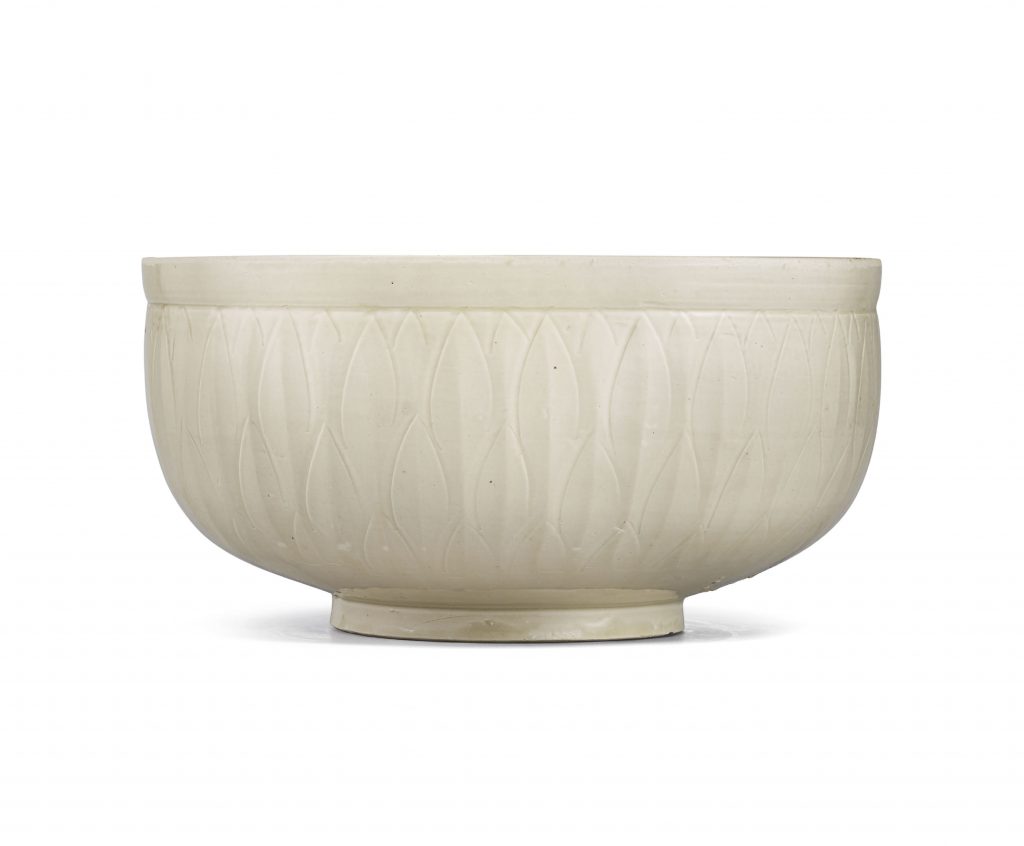
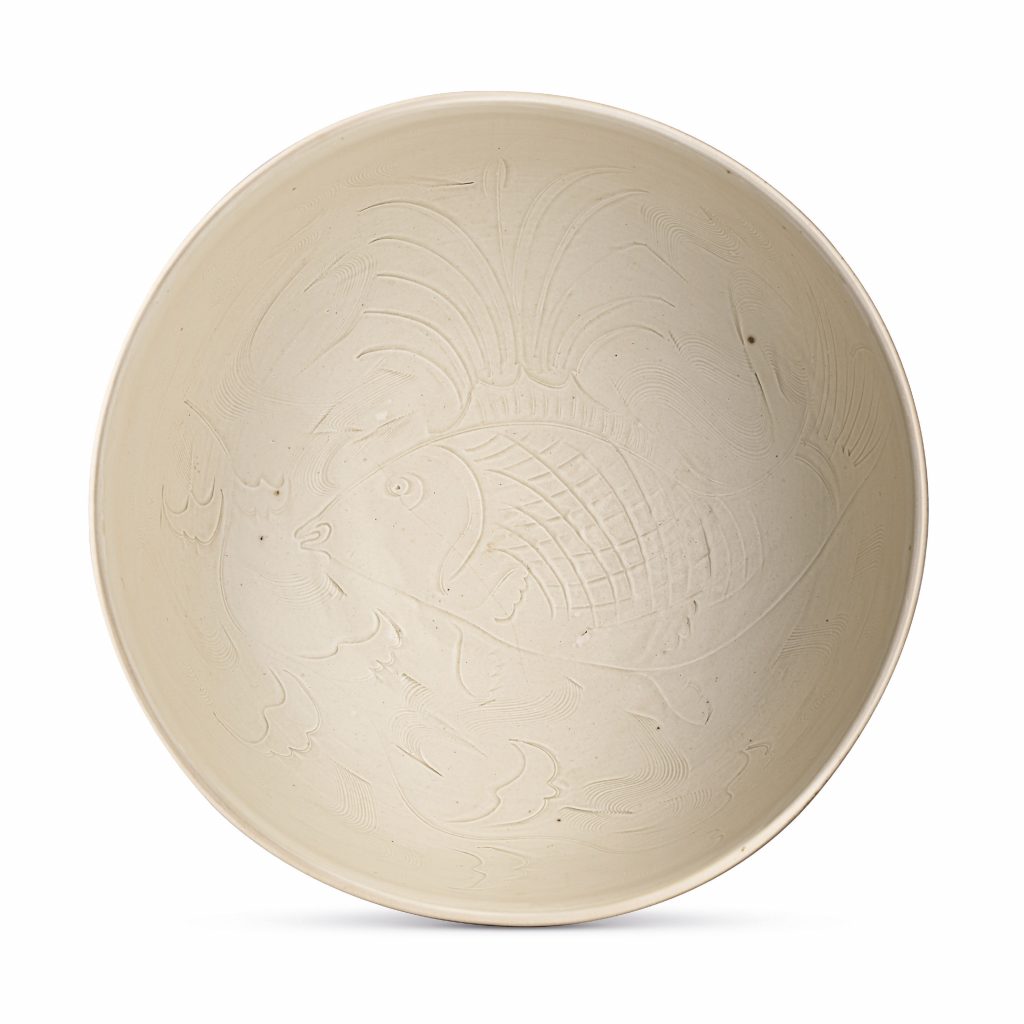
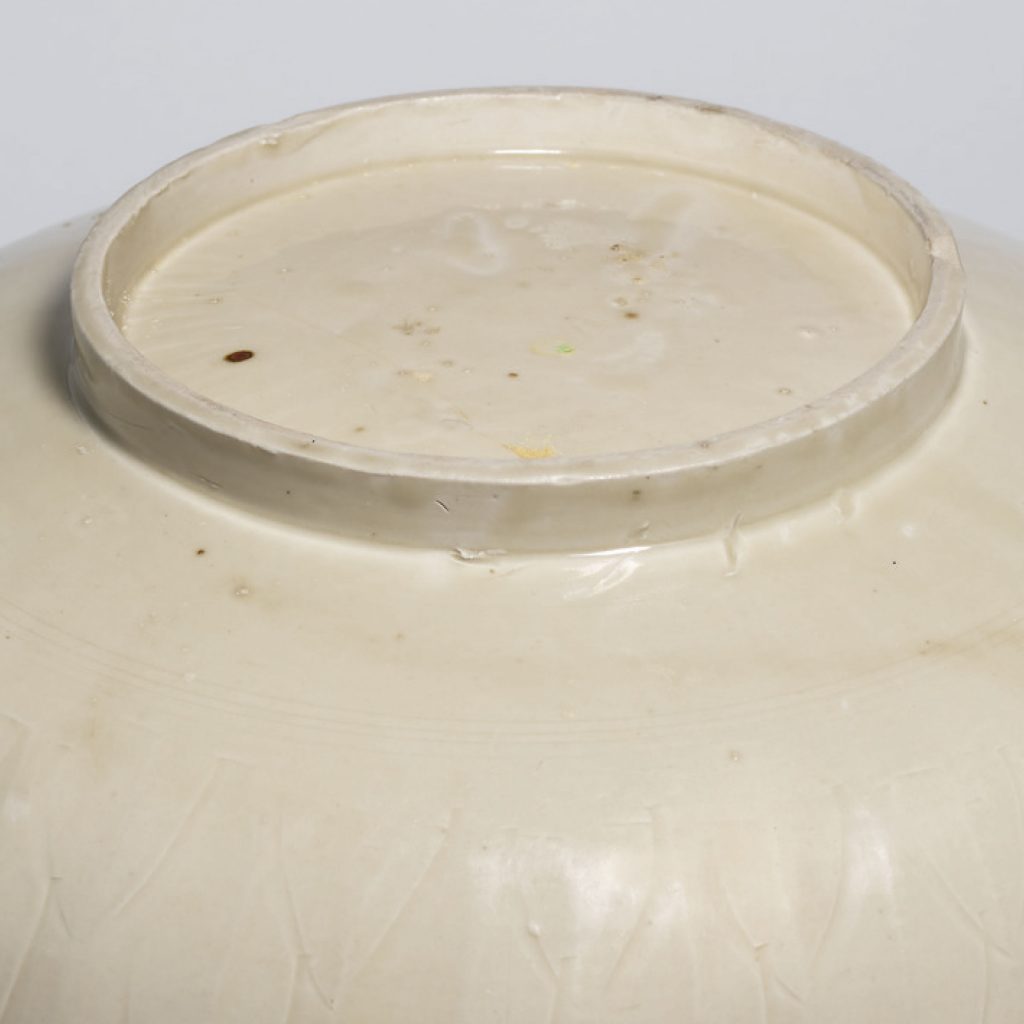
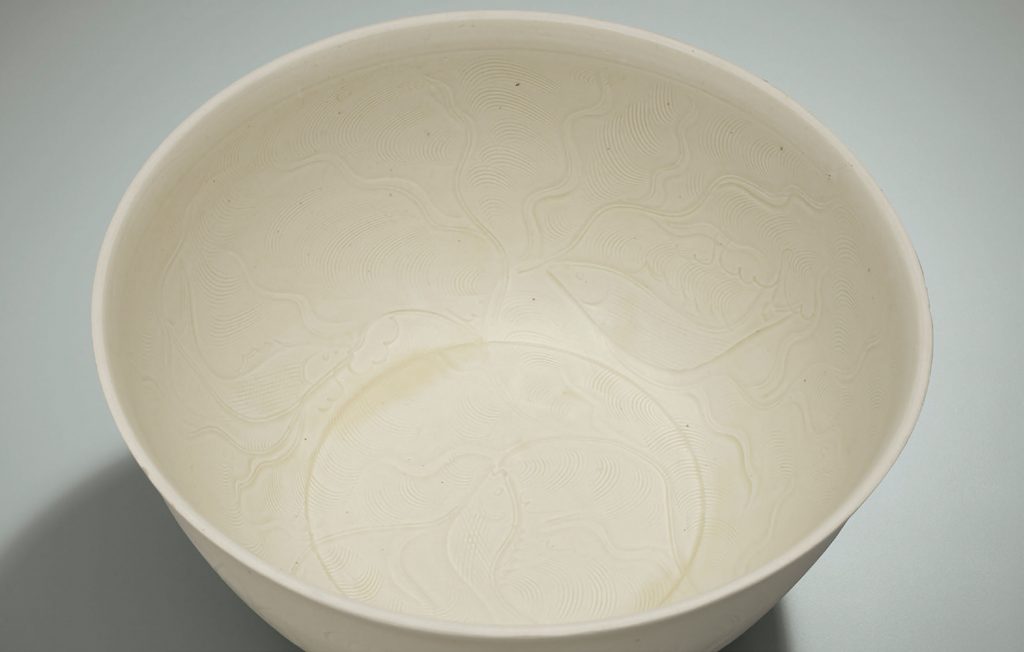
成交價 HKD 6,125,000
估價 HKD 5,000,000 – HKD 7,000,000
北宋/金 定窯白瓷刻魚藻紋大盌
NORTHERN SONG-JIN DYNASTY (960-1234)
13 in. (33 cm.) diam.
來源
香港蘇富比,1995年10月31日,拍品343號
出版
香港蘇富比,《香港蘇富比三十週年》,香港,2003年,頁127,編號103
狀況報告
謹請注意,所有拍品均按「現狀」拍賣,閣下或閣下的專業顧問應於拍賣前親自查看拍品以評鑑拍品之狀況。
-底部有一細裂,約13.5公分
-足沿有兩磕及其他小磕
-器面有輕磨損,屬正常現象
盌直口,深弧腹,矮圈足。盌心刻劃一尾鯉魚悠然暢泳於池中,水草搖曳;外壁刻四層蓮瓣紋。通體施象牙白釉,口沿不掛釉,露細白澀胎。
此盌器形碩大,口徑達33 公分,造型規整,釉汁潔淨光潤,胎質細膩堅硬,為定窯白瓷中之上乘精品。
大型定窯器原不多見,裏外刻花者更是珍罕,而此器裏外紋飾不同,實在彌足珍貴。清宮舊藏一件定窯盌,盌心同樣刻魚藻紋,著錄於故宮博物院藏文物珍品全集《兩宋瓷器(上)》,圖版56 號。英國大維德基金會藏另一例,見M. Tregear著《Song Ceramics》,倫敦,1982年,圖29號;大英博物館亦藏一例,著錄於《Oriental Ceramics, The World’s Great Collections》,第五冊,1981年,圖56號。國立故宮博物院藏一件定窯盌,內壁刻魚紋,著錄於《定窯白瓷特展目錄》,台北,1987年,圖版31號。另可參考一尺寸略小的定窯盌(26.7公分),內壁刻三尾魚,2014年5月28日於香港佳士得拍賣,拍品3212號(圖一)。
拍品專文:
定窯鴛鴦形蓋蓮座香薰
柯玫瑰 香港博物館專家顧問 前維多利亞阿伯特博物院遠東部總館長
定窯器為五代、北宋和金代名瓷,被朝廷及各大寶剎奉為上品。
1 官府對窯務極為關注,五代時期更在當地設立瓷窯商稅務使 (或簡稱「瓷窯務使」或「窯務使」),此事在公元957年碑文中也有提及。
2 部份定窯器銘「官」或「新官」款,以示其地位不同凡響,定瓷貴為宮廷用瓷,北宋朝廷一直訂製不斷。 明清學者譽定窯為宋代「五大名窯」之一,如此一來,定瓷更是備受歷代藏家追捧和重視。定窯器聞名天下,難怪宋代學者如陸游、葉置、周密等皆有提及,但首次詳加分析此類收藏品的特徵與價值者,當數明代學者曹昭。他在著作中指出:「古定器,土脈細色白而滋潤者貴,質麄而色黃者價低。外有淚痕者是真,…… 宣和[公元1119至1125年]、政和[公元1111至1117年]間窯最好。…… 凡窯器茅篾骨出者價輕。」他還提到,當時定瓷的價格之貴已超越上乘景德鎮官瓷。
3 時至今日,定瓷的價值有增無減。藏家對定窯的盤盌類標準器趨之若鶩,工精制奇者 (如本拍品) 更是可遇而不可求。本香薰做工精絕,蓋頂巧塑二鴛鴦,交頸之姿纏綿繾綣,座子狀若盛放的仰蓮。此器雖經修復,但巧奪天工的複雜造型仍清晰可見。鴛鴦頸部線條婉轉流暢,乍看之下恍如白玉雕,蓋因曲線曼妙若此在陶瓷之中殊為罕見。更讓人拍案叫絕的,是鴛鴦足下沿蓋所塑的一周仰蓮瓣。每瓣單獨成型,再與座子接合,底部襯翻捲的小巧花萼。這一佈局既娉婷嫋娜,且動感十足。座子下半部承如意小足,其上環飾一道開光,內有卷草紋及小巧獅首。開光之上為一圈覆蓮紋,下端若如意雲頭。覆蓮瓣內與開光內的卷草紋上下呼應。器內口沿下刻一倒置的「月」字。此器的造型暗指夫妻恩愛、忠貞不渝,因鴛鴦與蓮合指「鴛鴦貴子」,而花卉之中,惟有蓮蓬與花同生,而蓮蓬多籽,故象徵連生貴子。
4 鴛鴦與伴侶長相廝守,且交頸之姿柔美繾綣,故代表琴瑟和鳴、相知相惜之情。其實,正如本香薰所用的白色,此處的蓮花也與佛教息息相關。寺廟與佛教徒均喜用白色或無色半透明器物,因為透光這一特質象徵佛光普照之下心境澄明、幡然醒悟。故此,白玉備受追捧,水晶與玻璃亦然。白色薄胎瓷也是禮佛之物,就是可證諸遼寧一座公元十二世紀初佛門古墓的出土文物,此墓的主人很可能是位份極高的僧侶。墓墻鑲十四篇金字梵文,而隨葬品更有一批精美定窯器和青白瓷。
5 兩者均屬白瓷,各源自華北與華南。而且,兩者的薄胎之作均可透光,故可作禮佛之用。 這類蓮座之上飾一對鴛鴦的香薰,其形制或脫胎於金屬器。以製作工藝而言,金銀器可錘揲成型,而青銅器則可澆鑄成器,故難度較低。相形之下,陶瓷作品的定形要難得多。可是,北宋名窯卻迎難而上。汝窯遺址近期的考古發掘,便出土了若干模製蓮座(圖一)。其中一例為素胎香薰的完整蓮座,也有一批素胎及掛釉的殘片,圖見葉喆民相關著作。
6 從掛釉之作看來,蓮瓣的刻工格外細膩,瓣沿皆劃一道輪廓線,正中綴一乳釘。惟其浮雕蓮瓣外觀厚重,不像本香薰的蓮瓣般楚楚動人、娉婷而立。耀州和景德鎮均有燒造青白釉鴛鴦形蓮座香薰。
7(圖二)這批作品雖工絕精巧,但其蓮座造型厚重,不像本香薰的蓮瓣般玲瓏立體。如斯複雜的陶瓷作品,究竟產於何地呢?河北境內,有多處窯口燒造定瓷。定窯一說源於「定縣」,但其窯址其實位於曲陽縣的澗磁村和燕山村。
8 曲陽縣在宋代仍屬定州管轄,故有「定瓷」一說,也解釋了窯址造成的諸多誤解。1941年,日本學者小山富士夫首次在該窯址展開勘察。當時採集的大批殘片和其他標本,皆貯存於日本出光美術館、MOA美術館及根津美術館,學者就此也進行了相當深入的研究。
9 時至1950年代,陳萬里與馮先銘再赴當地進行考察。1961至1962年期間,工作人員開始着手發掘與勘測龐大的廢瓷堆,而這方面的工作目前仍在不斷加深我們對定瓷及其斷代的了解。
10 中國方面的發掘成果,現由曲陽縣文物局及定州市博物館收藏。 定窯採用的是較難塑形的白色瓷土,主要以拉坯成型,紋飾為劃刻或模印,印花之作始見於十一世紀中葉,是用單體內模範印而成。本香薰由若干構件組成,並結合了拉坯與模製工藝。香薰主體為拉坯成型,而底座、蓮瓣及蓋俱為模製,最後用封泥將各組件接合成複雜的造型。座子內底仍有同心環狀排列的小巧指紋,當年夯實模具內黏土的情景歷歷如見。此類香薰極難定型和燒造,能流傳至今更是倍顯珍貴。本拍品的特色之一,是其底座開光和覆蓮瓣內精美的印花。這類繁縟的印花效果,是在窯燒之前用刻有圖案的模具,在半乾坯體上壓出層次豐富、工緻細膩的陽線紋樣,與壓花銀器或織錦有異曲同工之妙。在1388年刊行的《格古要論》中,曹昭提到時人對各類定窯器的評價:「劃花者最佳,素者亦好,繡花者次之。」
11 就此而言,本拍品堪稱集大成者,劃花、光素和繡花兼而有之。這類器物多用匣缽燒造而成,因為定窯用的是饅頭窯,而且從十世紀起以煤為燃料。在1,300至1,340攝氏度之間,饅頭窯內熱力大增,若無匣缽保護,煤的煙塵可能會對器物造成損壞。饅頭窯燒的是氧化焰,形成定瓷經典的溫潤象牙色澤,以及腴厚的透明釉滴斑,在中國鑑藏界素有「淚痕」之譽。本香薰外底積釉處色呈乳白,而蓋內的釉滴斑有明顯的「淚痕」效果。最後,且讓我們來分析一下此爐特殊的造型。定窯很少燒造一體兩件的香薰,所以本拍品極為罕貴。但陶工緣何要費此心力,製作一件對其材質來說難如登天的器物呢?也許,原因在於香薰本身便是超凡脫俗之物。焚香在中國歷史悠久,早於周代已有薰艾,香煙繚繞既可袪味除臭,亦可驅趕蚊蟲。秦漢二代,道家傳人無不醉心於長生不老之術,以東海仙境為造型的博山爐遂應運而生,用以薰燃各種植物和動物類香料。植物類薰香源自桂皮、樟腦、甘草和茴香,而動物類則來自麝貓和麝香。除了本土香料之外,入宋之前已出現檀香、沉香、龍涎香、安息香等進口香料。
12 正式的宮廷和宗教儀式中多有使用香料和薰爐,使這一歷史悠久的傳統得以薪火相傳。輕煙一縷,象徵的是天地造化之「氣」,當薰香穿過蓋內管道,再由鴛鴦之喙徐徐飄出,斯情斯景,思之令人悠然神往。
参考:苏富比
Chinese Art
01 六月 2015 • 香港
拍品 588
北宋 定窰刻花雙魚紋盌
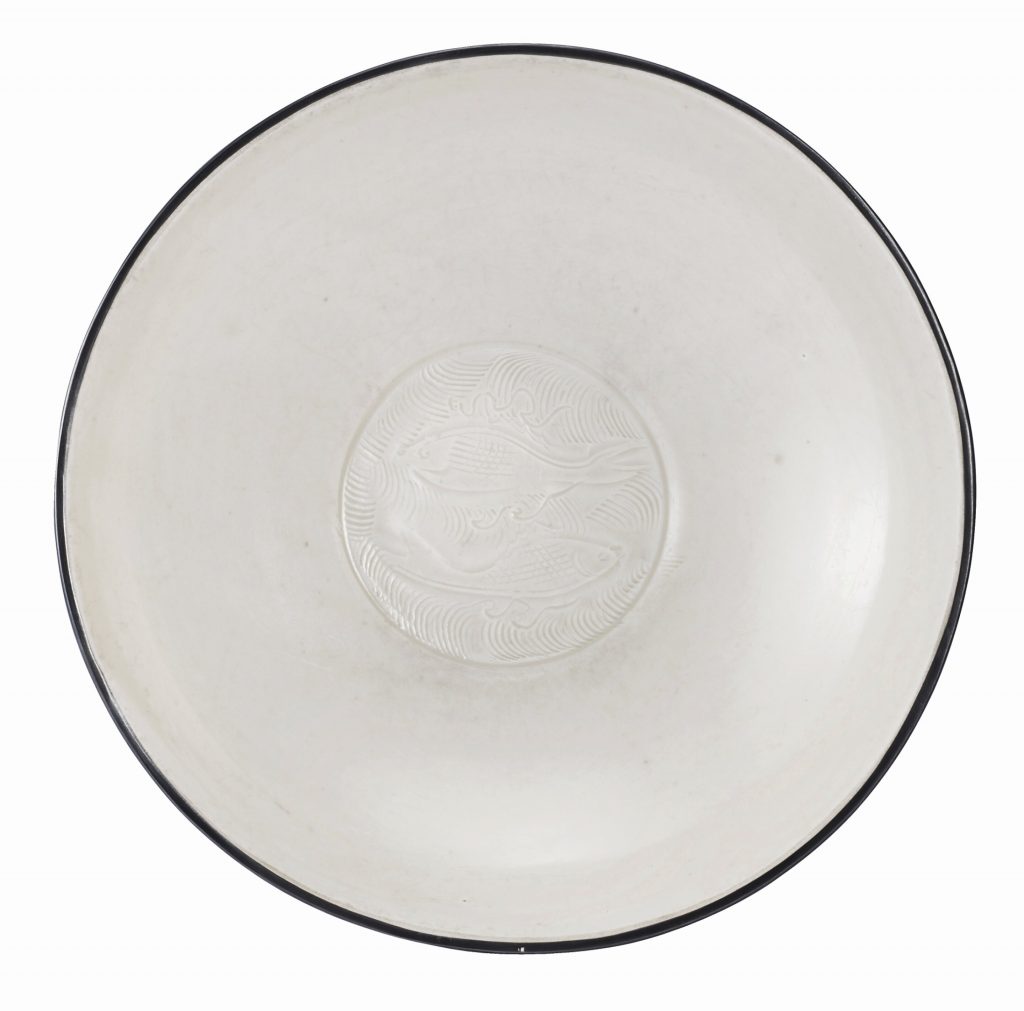
估價 500,000 – 700,000 HKD
已售出 625,000 HKD
描述
ceramic
20.2 公分,8 英寸
finely potted with deep rounded sides rising from a low footring, swiftly incised on the recessed interior floor with two carps leaping above combed waves, applied overall with a pale ivory-tinged glaze occasionally pooling in darker tear-drops down the exterior, the rim encircled with metal, silk pouch and Japanese box
來源
壺中居,東京
拍品資料及來源
觀本品,細工精刻,起刀流暢,飾雙魚紋,自然靈動。同類者,多見各大博物館及私人珍藏。參考一例,藏台北國立故宮博物院,展《定州花瓷·院藏定窰細白瓷特展》,台北,2014年,圖版II-25。亦見一例,藏雅典貝納基博物館, 載 Leigh Ashton 及 R.L. Hobson,《Catalogue of the Benaki Museum》,雅典,1939年,圖版258。另見一例,Wayland Wells Williams 收藏,現藏紐黑文耶魯大學美術館,錄 George J. Lee,《Selected Far Eastern Art in the Yale University Art Gallery》,紐黑文,1970年,圖版292。參考一盌例,George Eumorfopoulos 收藏,載 R.L. Hobson,《The Eumorfopoulos Collection》,卷3,倫敦,1926年,圖版XXVI,編號C130。另見兩例,售倫敦蘇富比,其一於1963年5月28日,編號62,出自 V.W. Shriro 收藏;其二於1957年10月29日,編號131,原為 Blanco White 夫人收藏。
雙魚者,中國傳統紋飾,深入民心,寓意吉慶,作歲歲豐餘之意,表魚水和諧之美。
参考:苏富比
Qianlong – Poet And Collector
06 四月 2015 • 香港
拍品 3201
北宋 / 金 乾隆御題定窰葵花式盤
《乾隆丙申春御題》款 「古香」「太璞」印
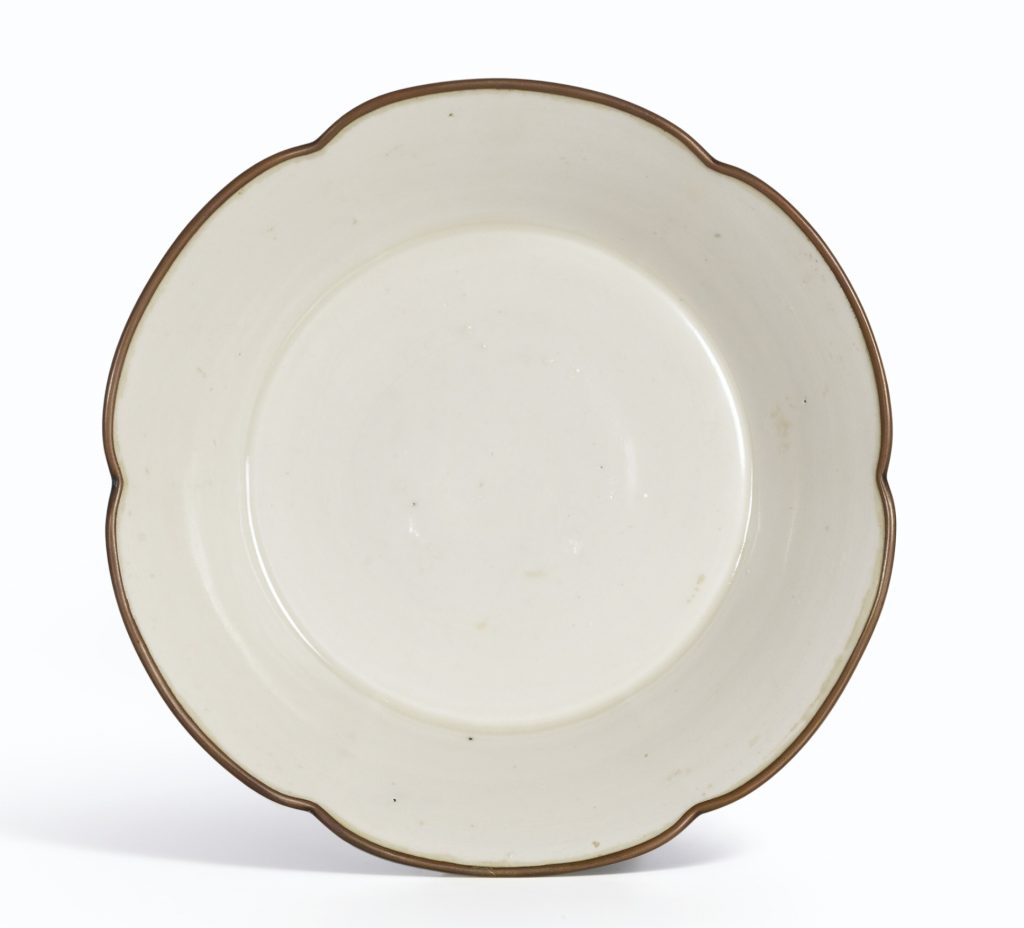
估價 1,500,000 – 2,000,000 HKD
已售出 2,000,000 HKD
描述
《乾隆丙申春御題》款
「古香」「太璞」印
ceramics
15.2 公分,6 英寸
詩文:
祗以光芒嫌定州,邢窰陶器作珍留;
獨緣世遠稱希見,髻墾仍多入市求。
來源
倫敦佳士得1970年10月12日,編號27
1972年11月從 P. Delplace 購得
比利時私人收藏
倫敦蘇富比2005年11月9日,編號268
拍品資料及來源
乾隆皇帝素以藝藏著稱,尤以宮內所藏為絕。且好詩,所題詠瓷詩無數,涵蓋汝、官、哥、定、鈞。據馮先銘,《中國古陶瓷文獻集釋》,台北,2000年,朝隆帝詠宋瓷詩共一百五十餘首,其中不少且鐫題於瓷器上。乾隆銘詩珍陶,現多藏台北國立故宮博物院,流散宮外者寥若晨星。
乾隆帝好古擅詩,據台北國立故宮博物院器物處研究員余佩瑾,〈乾隆皇帝的古陶瓷鑑賞〉,《得佳趣 -乾隆皇帝的陶瓷品味》,國立故宮博物院,台北,2011年,頁15,高宗曾於〈初集詩小序〉中寫道:「然幾務之暇無他可娛,往往作為詩古文賦……罔不形諸詠砍紀其梗概」。
此定窰葵花盤後銘文,與《清高宗御製詩五集》,卷23,頁27中錄之〈詠官窰盤子〉詩相近,只以「邢窰」替「官窰」便是。據前後所書詩文,該詩於五十一年(1786)四月收入高宗詩文集,較此盤紀年四十一年(1776)為晚。詩文收錄與鐫銘時間之差別,同見於大衛德基金會藏定窰瓷盌,圖見 Stacey Pierson 及 Amy Bames,《A Collector’s Vision: Ceramics for the Qianlong Emperor》,大英博物館, 倫敦,2001年,圖版25。Margaret Medley 曾探討此問題,見其著作《Illustrated Catalogue of Ting and Allied Wares》,倫敦,1980年,圖版6,編號44。該盌紀年丁酉四十二年(1777),卻歸入四十七年(1782)詩錄。〈詠官窰盤子〉詩,且見於台北國立故宮博物院藏汝窰圓洗,圖見《故宮宋瓷圖錄.汝窰 官窰 鈞窰》,台北,1973年,圖版17,然銘文章法不作六角形,仍以豎行畫寫,紀年璽印亦有所不同。
相類銘御題詩定窰瓷盤,可見於《得佳趣》,前述出處,圖版5及6。北京故宮博物院也藏類例,紀年甲午(1774),見《故宮博物院藏文物珍品全集.兩宋瓷器(上)》,香港,1996年,圖版70。定州窰位處河北曲陽,宋時屬定州。定窰典型瓷器薄胎白體,釉色牙黃,帶暗色垂滴。此花式盤,誠北宋定窰精品,素飾無紋,器底掛釉肥厚,尤適刻銘。
宋人葉寘《坦齋筆衡》云「本朝以定州白瓷,有芒不堪用,遂命汝州造青窰器」,學者時引用之,認為宮廷因定瓷澀口不施釉,是以棄定取汝。台北國立故宮博物院蔡玫芬於1996年紐約大都會藝術博物館研討會上,提出於瓷品上添加金屬邊稜乃當時宮廷貴冑品好,澀口正好可避免金稜滑脫之虞,因此「有芒」並非為了採用覆燒技術才衍生的瑕疵。「稜釦習尚如此風行,然定窰瓷在北宋中期之前尚未行覆燒技術;是以金稜非因掩飾芒口而產生,相反的,芒口可能因稜釦習尚而生」。負責飾品、隸屬工部的「文思院」,以及承辦內宮品物之「後苑造作所」,下皆設有「稜作」,專門加綴金銀稜釦。蔡氏因此指「定州白瓷,有芒不堪用」之句,或並不反映宋廷對有芒定瓷之嫌厭,反之可能因定瓷巧飾稜釦,用於特定御典有欠妥適。全文見蔡玫芬,〈論「定州白瓷器,有芒不堪用」句的真確性及十二世紀官方瓷器之諸問題〉,《故宮學術季刊》,1997年,第2期,頁63-102。
乾隆御題詩銘章法有序,末刻璽印,形呈六角,此式同見於其他刻詩宋瓷。大衛德基金會所藏汝窰盤與兩件官窰花式盤也具此特徵,見 Stacey Pierson 及 Amy Bames,前述出處,圖版3、8及9。與此器形相類之瓷盤,還見於玫茵堂藏,見康蕊君,《玫茵堂中國陶瓷》,倫敦,1994-2010年,卷1,圖版347,但該器體略大,未刻詩。另有一例,見 Michael Sullivan,《巴洛爵士及夫人所藏中國陶瓷、青銅器、玉器》,倫敦,1963年, 圖版42b。仇焱之舊藏且有一例,尺寸略大,售於倫敦蘇富比1980年12目6日,編號253。Lindberg 及艾弗瑞.克拉克舊藏器也可資比對,二盤分別售於倫敦蘇富比1978年12目2日,編號118,以及1975年3月25日,編號40。
参考:佳士得
2021年12月3日 | 現場拍賣 20195
淡掃蛾眉 – 頌德堂藏中國宋代瓷器
拍品 2839
北宋 定窯印花牡丹紋盌
NORTHERN SONG-JIN DYNASTY (960-1234)
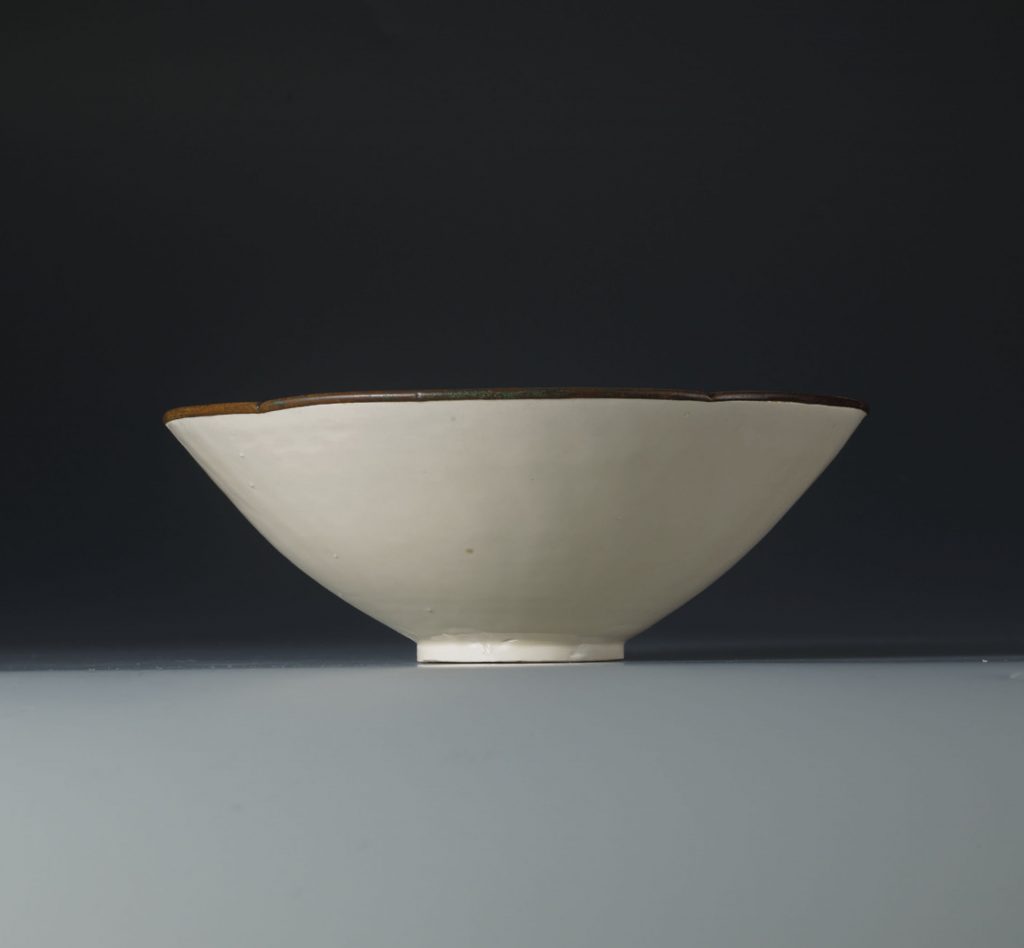
北宋 定窯印花牡丹紋盌
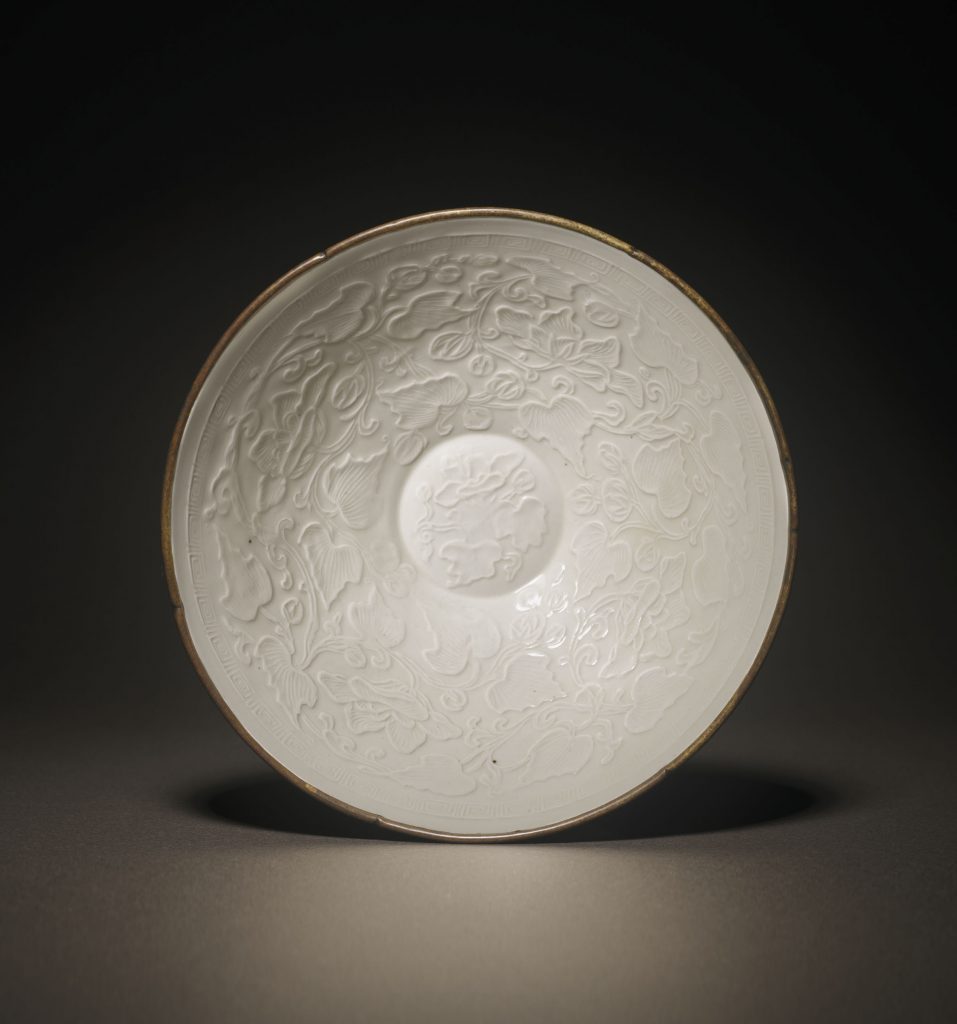
北宋 定窯印花牡丹紋盌
估價 HKD 700,000 – HKD 900,000
北宋 定窯印花牡丹紋盌
NORTHERN SONG-JIN DYNASTY (960-1234)
7 ½ in. (19 cm.) diam., box
展覽
香港大學美術博物館 ,《大繁若簡 – 宋金元朝的單色釉瓷展出》,2012 年,圖版 28 號
狀況報告
謹請注意,所有拍品均按「現狀」拍賣,閣下或閣下的專業顧問應於拍賣前親自查看拍品以評鑑拍品之狀況。
-整體品相良好
-釉面有些許磨損及輕微劃痕
拍品專文
此盌印紋清晰,釉色亮麗,品相完美,在已知的相關資料中只發現另一相同例子,藏於法國巴黎吉美博物館,屬館藏定窯常設展品之一,藏品編號MA4163 。
参考:苏富比
The Pilkington Collection of Chinese Art /
05 四月 2016 • 香港
拍品 4
宋 定窰白釉刻魚紋葵口盤
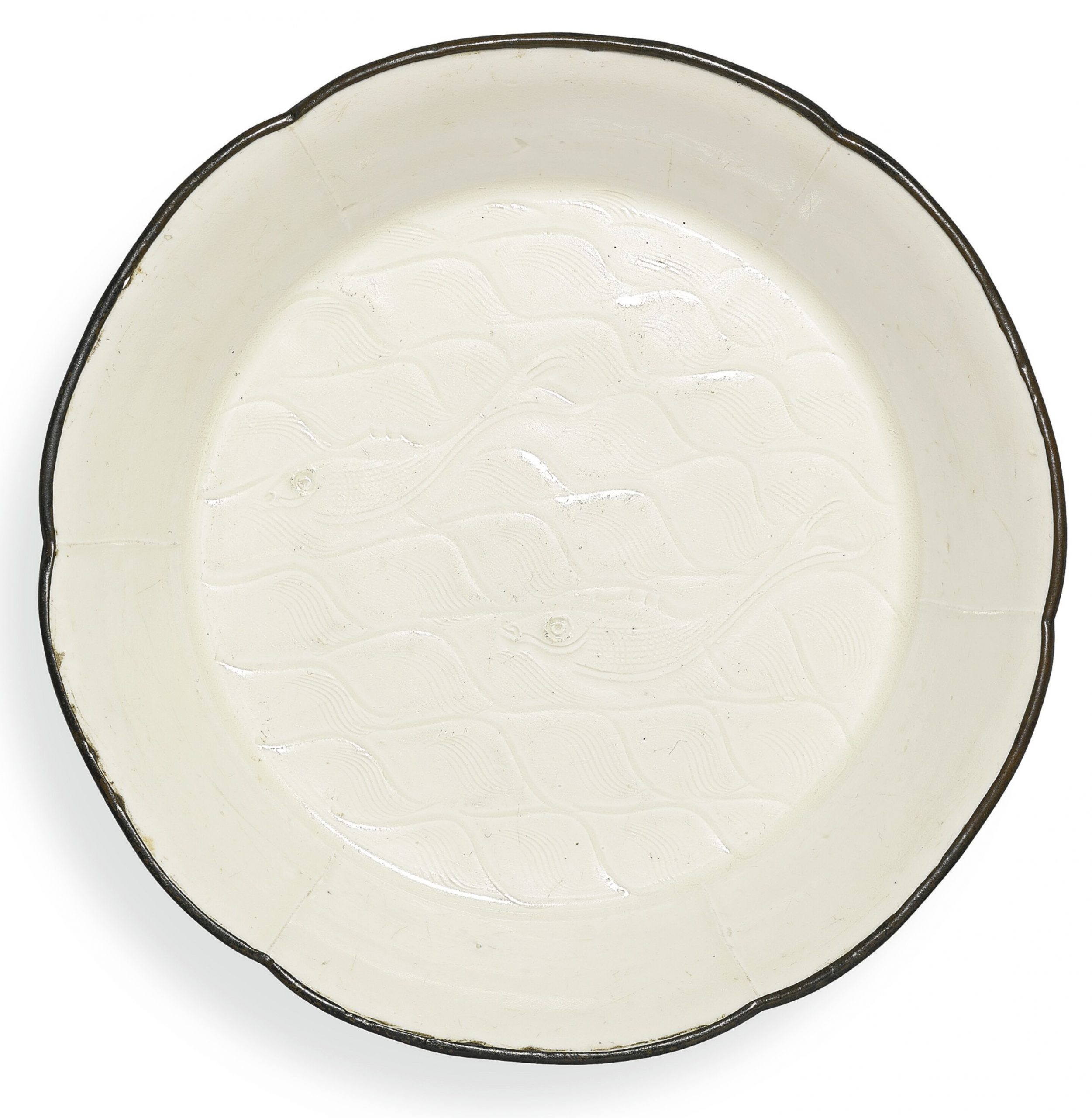
估價 120,000 – 180,000 HKD
已售出 2,120,000 HKD
描述
stoneware and copper
14.7 公分,5 3/4 英寸
the flat base rising to flaring sides divided into six lobes by raised vertical ribs, freely carved to the interior with a pair of fish swimming amongst rippled waves, applied overall with a creamy ivory glaze, the lobed rim bound with copper
來源
Martin d. Corke 收藏,至1959年
倫敦蘇富比1959年2月17日,編號13(£150)
Bluett & Sons Ltd,倫敦,1959年(£150)
羅傑琵金頓(1928-69年)收藏 , 自1959年(£200)
拍品資料及來源
此六瓣盤,器形柔雅,所刻魚水紋,渾然靈動,當屬罕有佳作。台北故宮藏一相類雙魚紋盤例,魚游向相反,展於《定州花瓷:院藏定窰系白瓷特展》,國立故宮博物院,台北,2014年,圖版II-88;同錄一盤例,模印矮足刻單魚紋,見圖版II-89。
魚水紋極為常見,多雙魚作對。「魚」象徵婚姻合美,子孫繁盛,寓意和睦幸福。而雙魚游於水中則尤表夫妻恩愛如「魚水和諧」。
参考:苏富比
天民樓﹕歷代華瓷萃集
29 五月 2019 • 香港
Tianminlou – A Small History of Chinese Ceramics
Lot 10
AN INCISED DINGYAO CUP NORTHERN SONG DYNASTY
北宋 定窑刻花碗
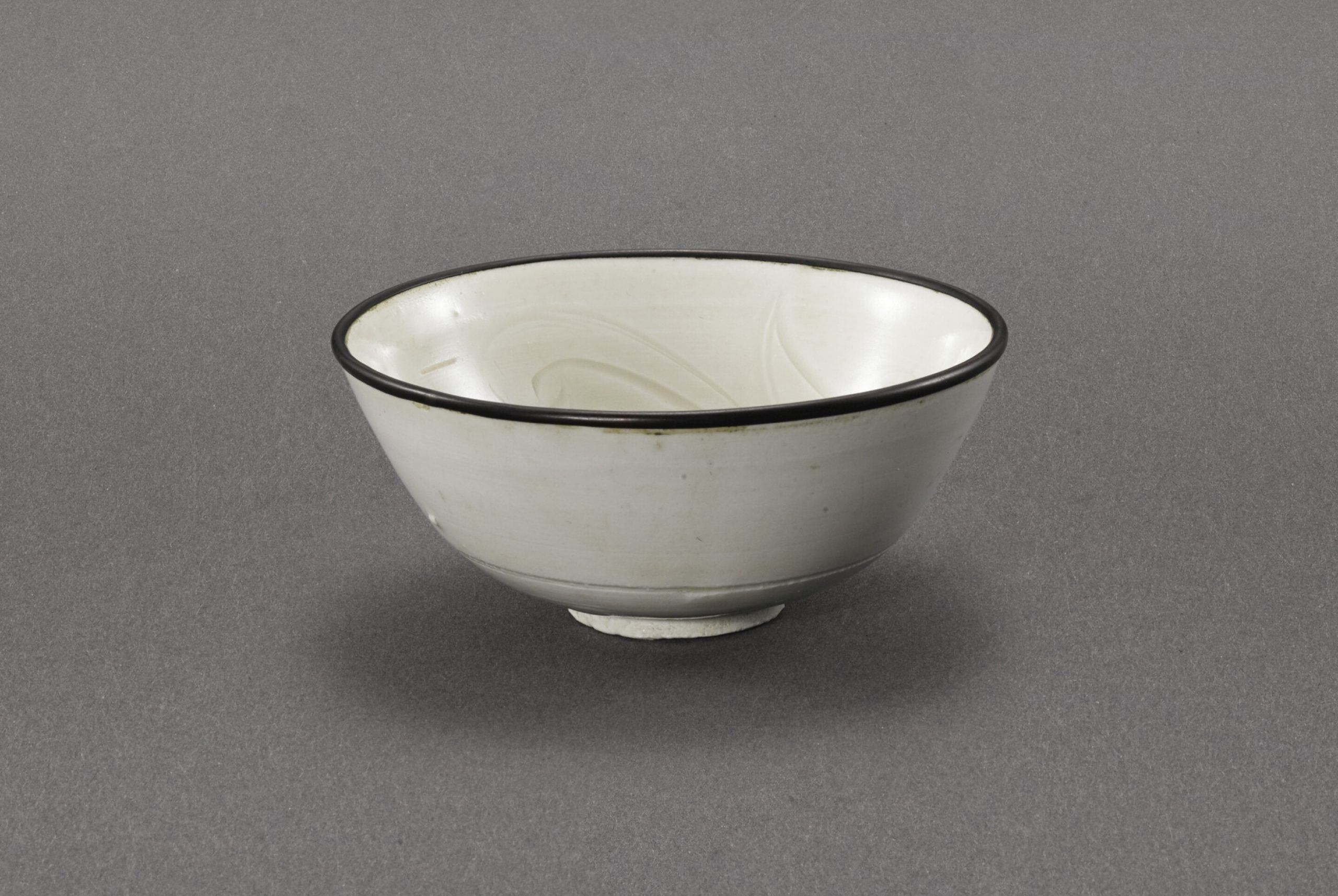
Estimate 100,000 – 150,000 HKD
Sold 375,000 HKD
Description
with rounded sides supported on a neatly knife-pared foot, the interior swiftly incised with a lotus bloom and broad leaves borne on curling stems, the exterior encircled with a carved line around the lower body, applied overall with an ivory-tinged transparent glaze, metal-bound rim
参考:苏富比
天民樓﹕歷代華瓷萃集
29 五月 2019 • 香港
Tianminlou – A Small History of Chinese Ceramics
Lot 11 北宋 定窑 刻荷花瓜棱形碗
AN INCISED DINGYAO ‘LOTUS’ LOBED DISH
SONG DYNASTY
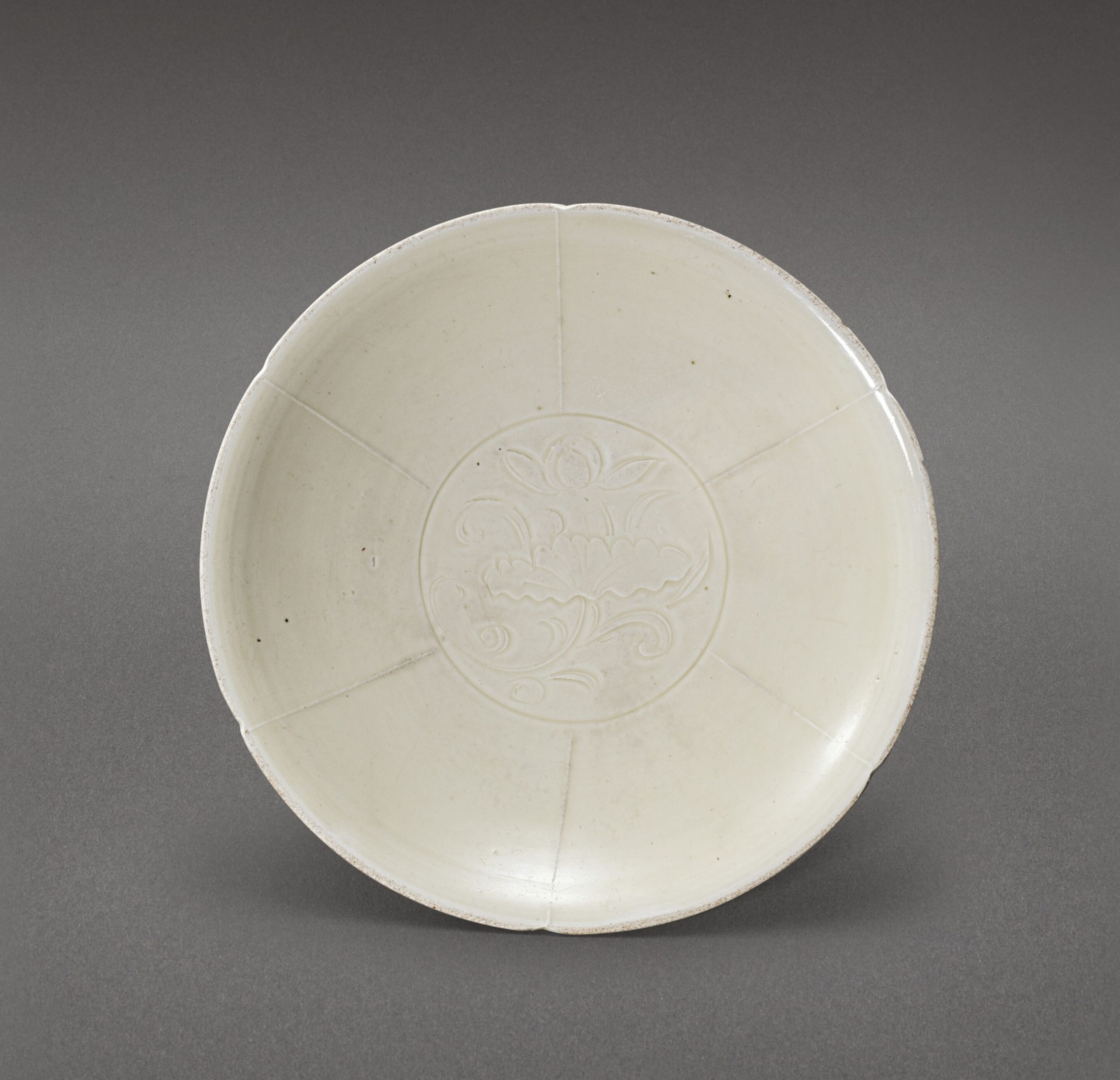
Estimate 400,000 – 500,000 HKD
Sold 625,000 HKD
Description
with rounded sides rising from a short foot to a gently flared six-lobed rim, the interior decorated with a medallion enclosing a lotus bloom and broad furled leaves borne on curling stems, the cavetto divided with ridges demarcating the petals, applied overall with an ivory-tinged transparent glaze
参考:
佳士得
2018 5月29| 現場拍賣 15959
重要中國瓷器及工藝精品
拍品 3091
北宋 定窯刻萱草紋花口盌
NORTHERN SONG DYNASTY (960-1127)

成交價 HKD 525,000
估價 HKD 250,000 – HKD 400,000
細節
北宋 定窯刻萱草紋花口盌
8 1/2 in. (21.5 cm.) diam., box
來源
倫敦蘇富比,2004年11月10日,拍品525號
参考:佳士得
現場拍賣 12175
中國瓷器及工藝精品
2016年9月15
VARIOUS PROPERTIES 2016 | 現場拍賣 12175
中國瓷器及工藝精品
拍品 1312
金 定窯印花盤
JIN DYNASTY (1115-1234)

成交價 USD 68,750
估價 USD 20,000 – USD 30,000
参考:佳士得
30 5月 2010 | 現場拍賣 2811
中國宮廷御製藝術精品、重要中國瓷器及工藝精品
拍品 1984 北宋 定窑刻鴛鴦紋盌
A RARE FINELY CARVED DINGYAO ‘DUCKS’ BOWL
THE PROPERTY OF A GENTLEMAN

成交價 HKD 2,180,000
估價 HKD 1,200,000 – HKD 1,800,000
A RARE FINELY CARVED DINGYAO ‘DUCKS’ BOWL
細節
盌敞口,斂腹,圈足。口部無釉,鑲銅口。通體施白釉。盌內斜刀刻劃一雙鴛鴦游弋於蕩漾的水波之中,旁有蓮花、水草,一副悠然自得的景象。外壁光素無紋飾,帶垂釉淚痕,露胎數處。
此器製作工整,胎薄釉潤,刻劃刀法嫻熟流暢,簡潔生動。在傳世品中,如此大的盌也不為多見,為定窑器中之典型,典型器中之精品。
此器源自菲格斯爵士(Sir John Figgess)舊藏,2005年7月12日於倫敦佳士得拍賣,拍品74號。
來源
Sir John Figgess, KBE, CMG
Previously sold at Christie’s London, 12 July 2005, lot 74
狀況報告
– There are two hairlines to the rim, one measuring approx. 10 cm. long the other approx. 7.5 cm. long.
– There is minor surface wear and scratches, especially to the interior.
拍品專文
This is a classic Ding ware bowl, with all the features of fine Ding wares from the Northern Song period. It is well potted with a fine-textured white body and clear, ivory-toned glaze including the characteristic ‘tear stains’ on the exterior. The low foot is well cut and bears the finger nail mark of the potter who held the foot while dipping the bowl into the vat of glaze. The decoration of a pair of ducks on a pond with aquatic plants is fluently incised with some of the major lines of the design being emphasised through the use of parallel lines. The decorative theme of a pair of ducks was a very popular one in China, especially in association with weddings. A pair of ducks symbolise fidelity, and if they swim on a lotus pond the message is extended, since one of the Chinese words for lotus is pronounced he, which is a homophone for harmony.
Two Ding bowls decorated with a scene depicting a pair of swimming ducks, and of the same size and similar shape as the current bowl are in the collection of the National Palace Museum, Taipei (see Catalogue of the Special Exhibition of Ting Ware White Porcelain, National Palace Museum, Taipei, 1987, nos. 44 and 46). A similarly sized Ding bowl with a design of a pair of swimming ducks, formerly in the Eumorfopoulos Collection, is now in the collection of the Percival David Foundation (see M. Medley, Illustrated Catalogue of Ting and Allied Wares, Percival David Foundation, London, 1980, p. 17, no. 33). A Ding ware bowl of similar shape, size and decoration is in the collection of the Art Institute of Chicago (illustrated in Masterpieces of Chinese Arts from the Art Institute of Chicago, Museum of Oriental Ceramics, Osaka, 1989, p. 79, no. 67). This bowl, formerly in the collection of Lucy Maud Buckingham, entered the Chicago collection in 1924.
参考:苏富比 Important Chinese Art
拍品 83
宋 定窰白釉花式大盌

估價5,000 – 7,000 USD
已售出62,500 USD
描述
the gently curved sides rising from a short straight foot to a slightly everted rim, the interior sides molded with six radiating lines for a lobed effect, covered overall in a creamy ivory glaze, the rim bound in metal
参考:The Cleveland Museum of Art
Bowl
12th Century
China, Hebei province, Chuyang District, Jin dynasty
(1115-1234)
White porcelain, Ding ware

Diameter: 21 cm (8 1/4 in.); Overall: 6.4 cm (2 1/2 in.)
The Fanny Tewksbury King Collection 1956.699
HIDEPROVENANCE
?-1956
Fanny Tewksbury King [d. 1949], Cleveland, OH, ?-1956, sold by her estate to the Cleveland Museum of Art
1956-
The Cleveland Museum of Art, Cleveland, OH, 1956-present
HIDECITATIONS
Lee, Sherman Emery, and James Robinson. The Colors of Ink: Chinese Paintings and Related Ceramics from the Cleveland Museum of Art. New York: Asia Society; distributed by New York Graphic Society, 1974. Cat. No. 60
HIDEEXHIBITION HISTORY
Year in Review: 1970. The Cleveland Museum of Art (February 10-March 7, 1971).
The Colors of Ink. The Cleveland Museum of Art (organizer) (April 9-May 12, 1974).
RELATED CONTENT
Collection: China – Jin Dynasty
Department: Chinese Art
Type of artwork: Ceramic
Medium: White porcelain, Ding ware
Credit line: The Fanny Tewksbury King Collection
参考:故宫博物院
【定窑白釉印花海兽鱼纹洗】
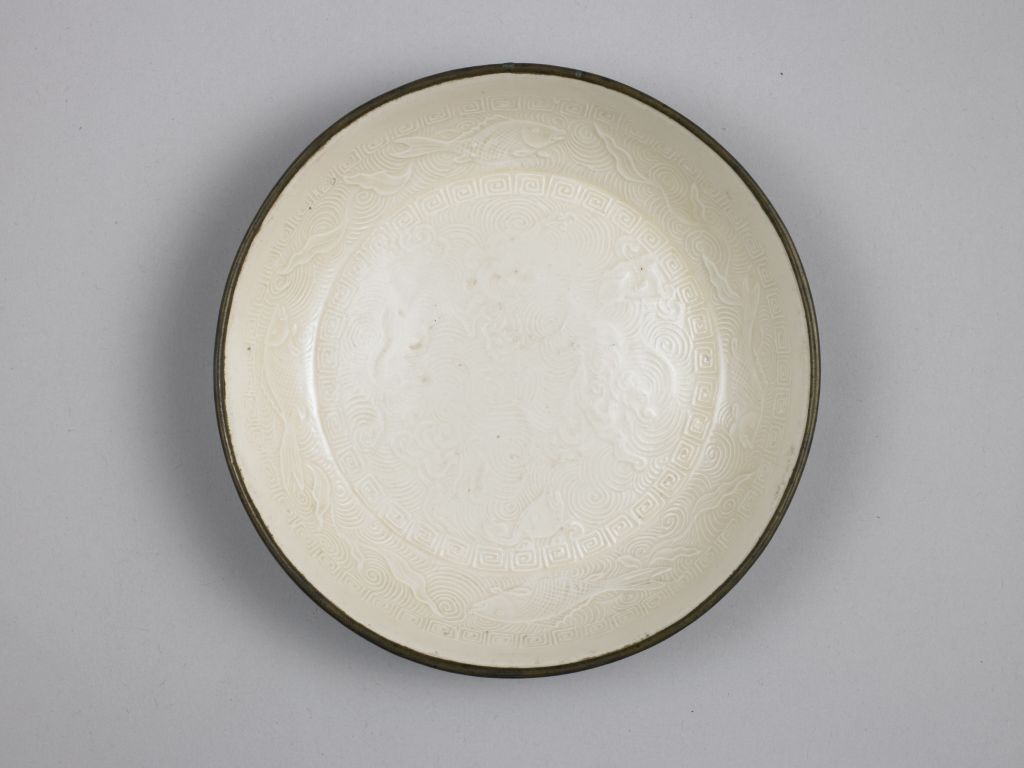
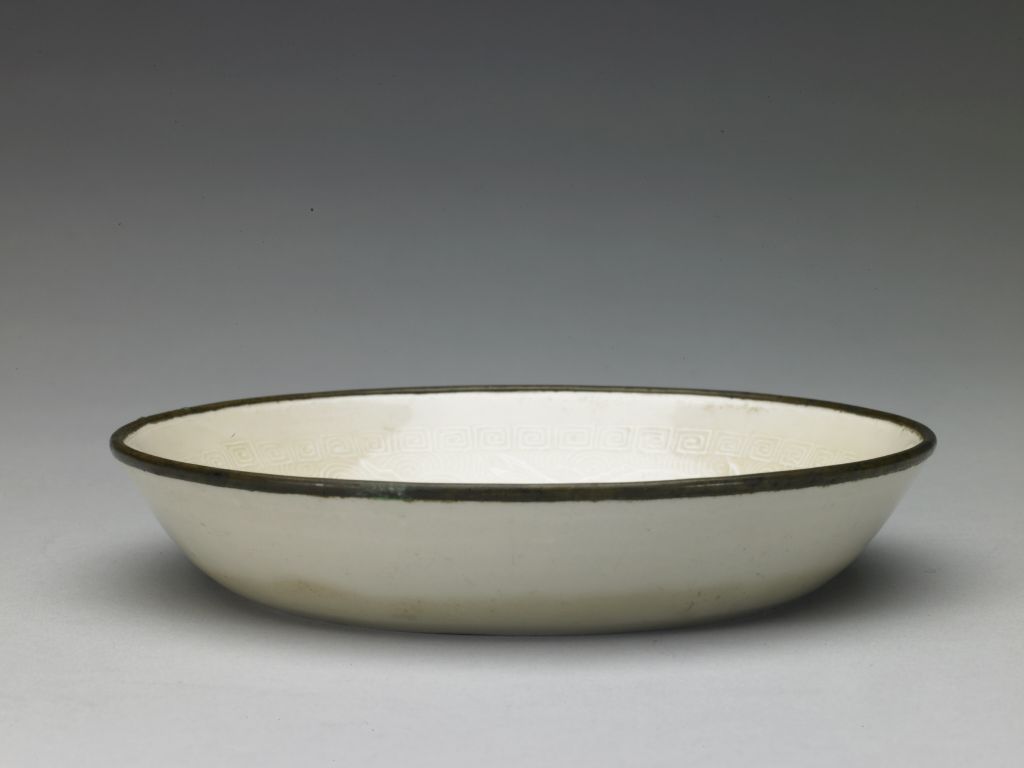
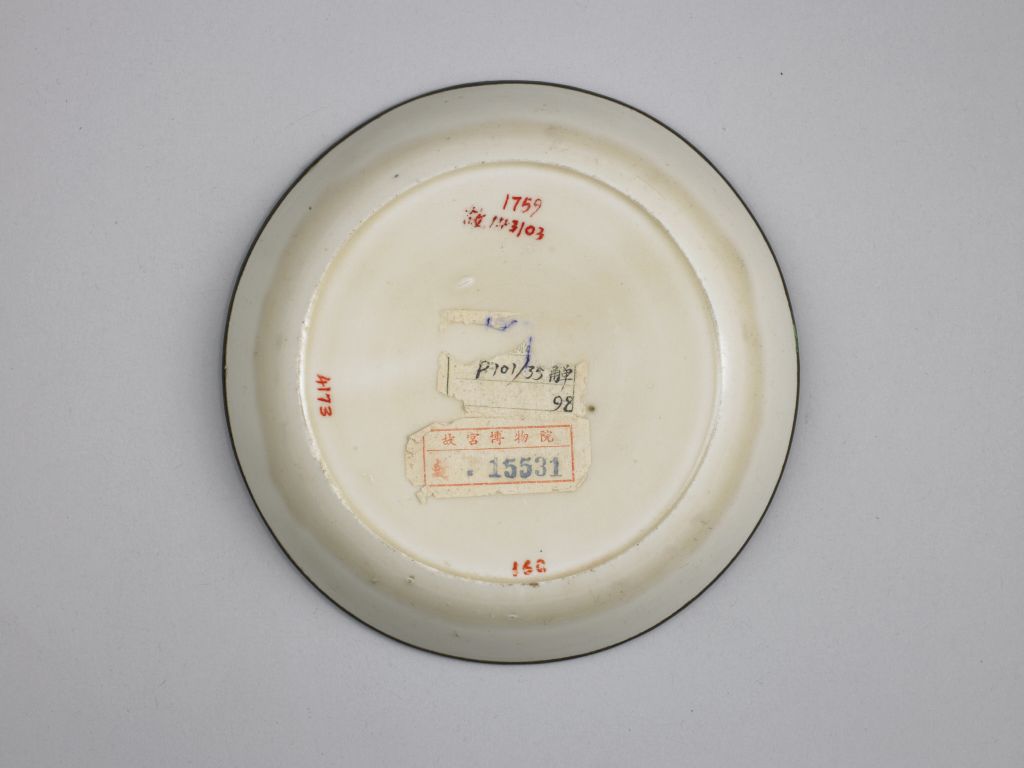
定窑白釉印花海兽鱼纹洗,金,高2.5厘米,口径13.8厘米,足径9.5厘米。故宫博物院藏。
洗敞口,浅弧壁,圈足。通体内外施白釉,口沿无釉,镶嵌铜釦。洗内印花装饰,内底印一海兽,环以回纹。内壁印游鱼四条穿行于海水之中,近口沿处印一周回纹。
此洗内虽满印花纹,但画面安排错落有致,繁而不乱,体现出高超的制作工艺水平。
撰稿人:孙悦
关键词: 定窑 印花 海兽 鱼纹 镶嵌 回纹
参考:故宫博物院
【定窑白釉印花云龙纹盘】
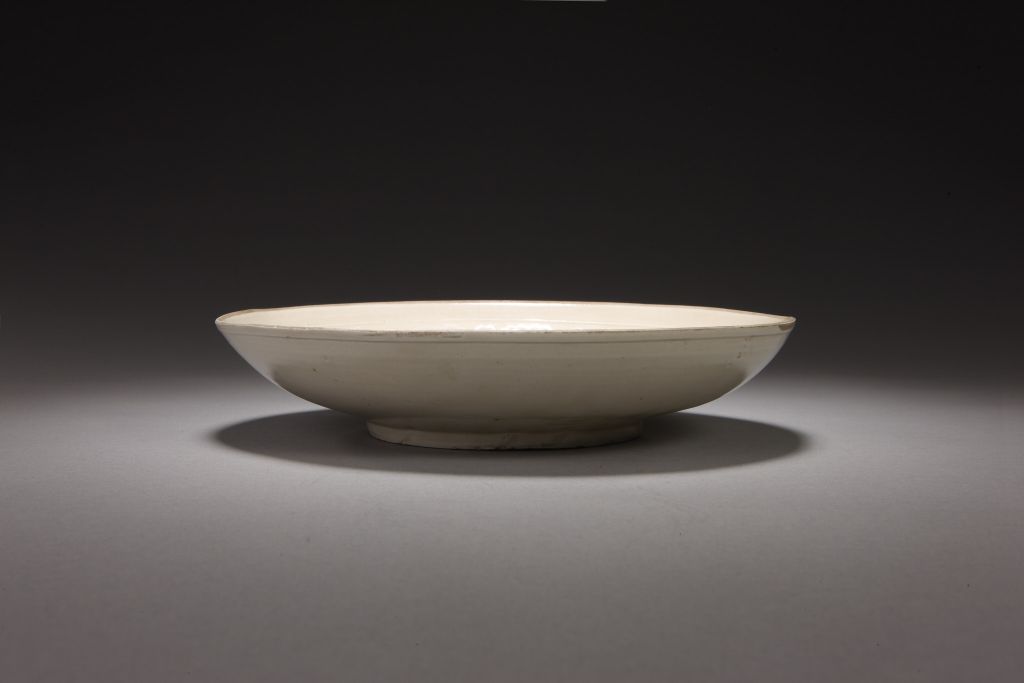
【定窑白釉印花云龙纹盘】
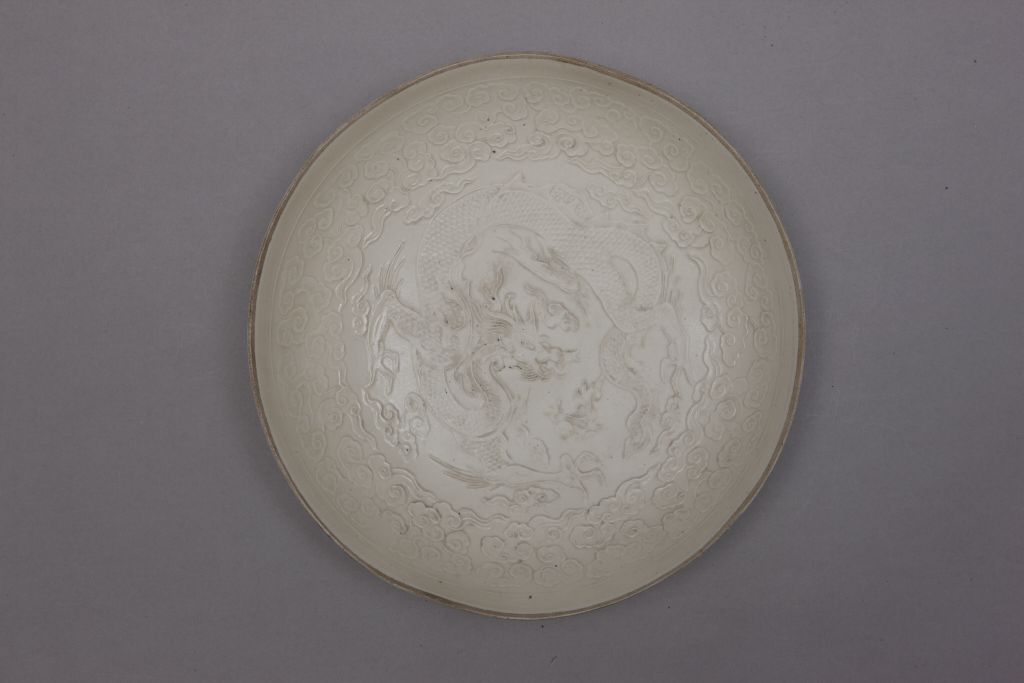
【定窑白釉印花云龙纹盘】
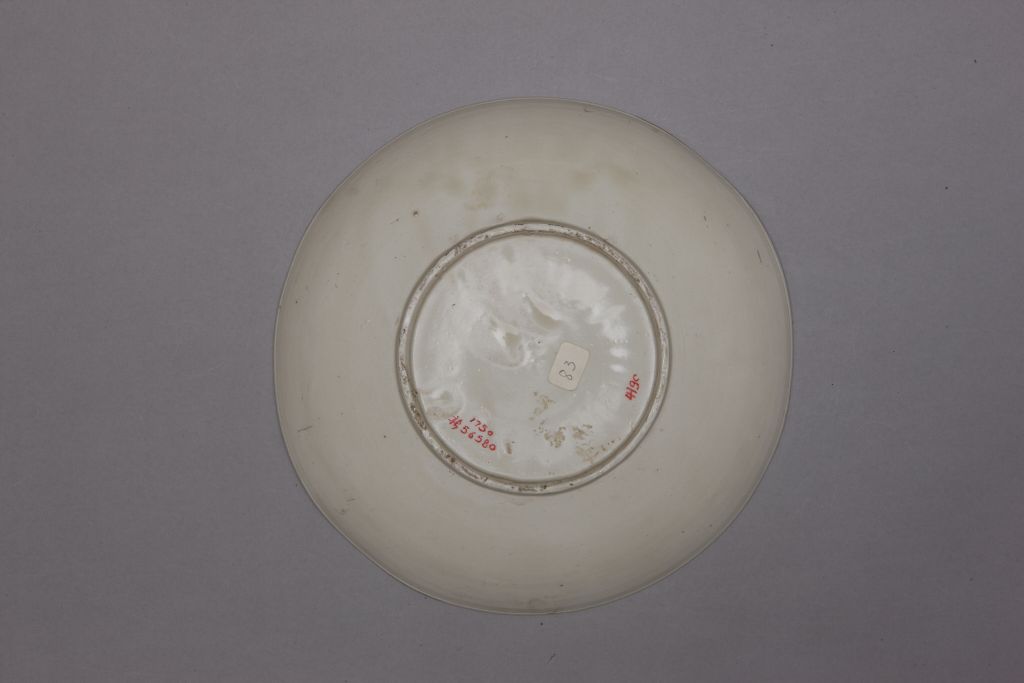
【定窑白釉印花云龙纹盘】
定窑白釉印花云龙纹盘,北宋,高5.2厘米,口径23.3厘米,足径10.2厘米。故宫博物院藏
盘敞口,浅弧壁,圈足。内外施白釉,釉色白中闪牙黄,口沿无釉。盘外壁光素,内模印花装饰,内壁饰祥云纹,内底为一矫健行龙。
定窑瓷器上常见龙凤纹装饰,表明定窑瓷业生产应与宫廷间有着密切的联系。
撰稿人:黄卫文
关键词: 定窑 印花 龙纹 行龙
参考:故宫博物院
【定窑白釉印花缠枝海石榴纹笠式碗】
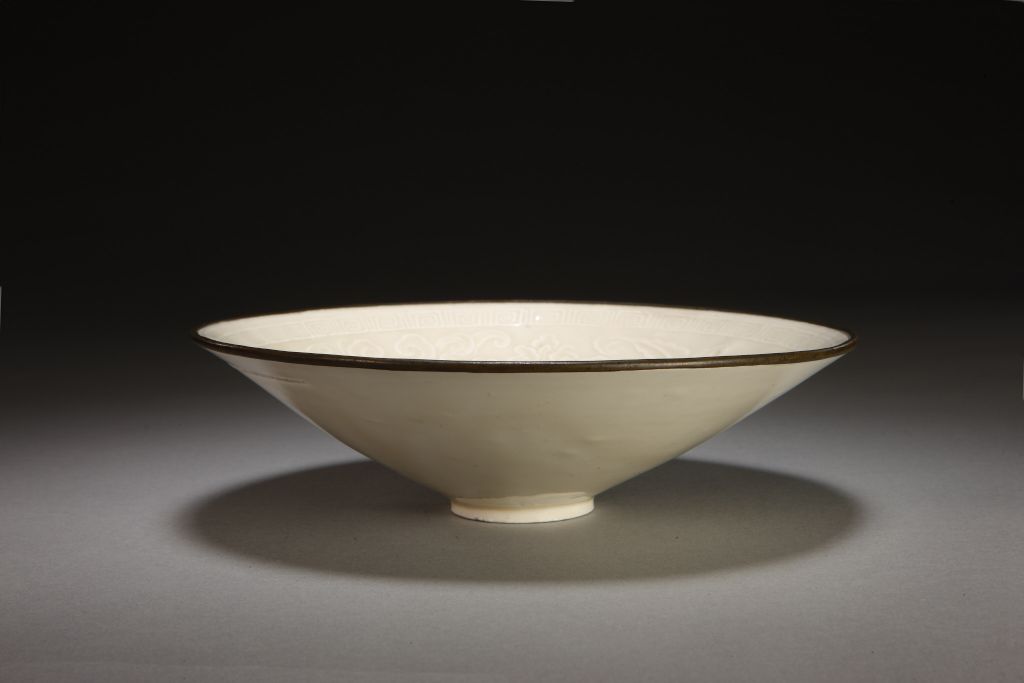
【定窑白釉印花缠枝海石榴纹笠式碗】
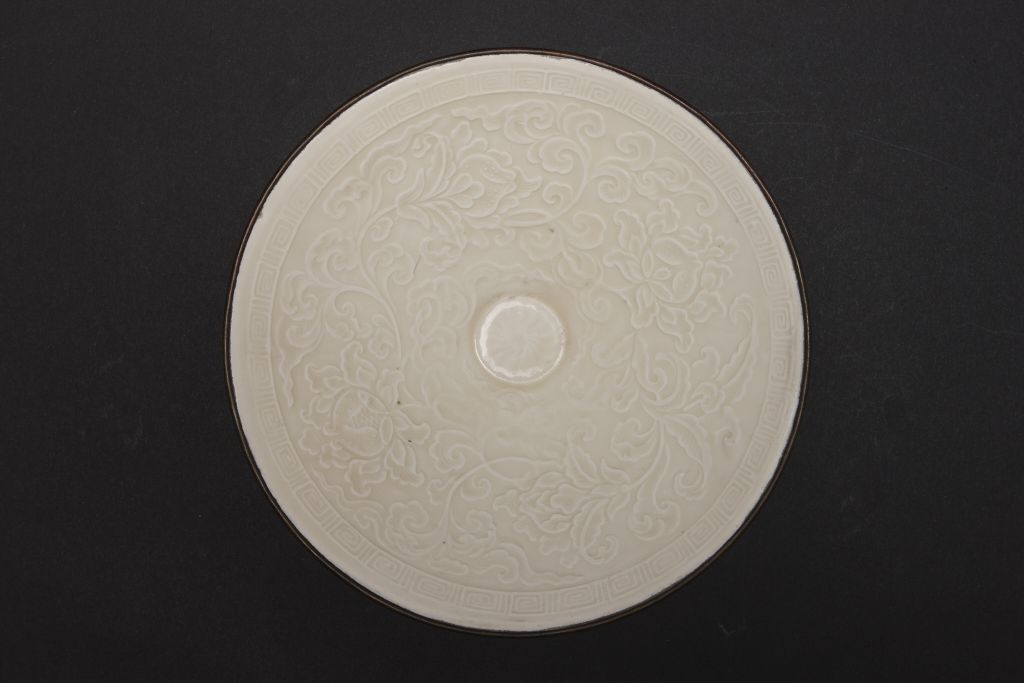
【定窑白釉印花缠枝海石榴纹笠式碗】
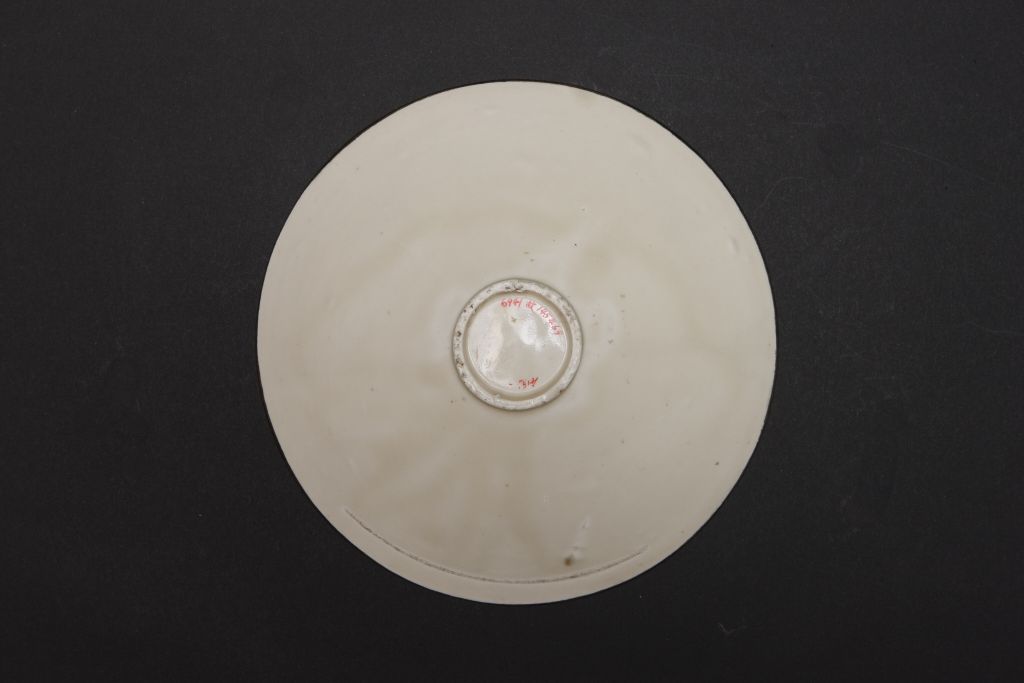
【定窑白釉印花缠枝海石榴纹笠式碗】
定窑白釉印花缠枝海石榴纹笠式碗,北宋,高5.7厘米,口径20.3厘米,足径4.4厘米。故宫博物院藏。
碗呈斗笠式,圈足。内外施白釉,口镶铜扣。碗内印花装饰,近口沿处印一周回纹,内壁印缠枝石榴花纹。
石榴因多子而满足了人们祈求多子多孙的愿望,故被赋予吉祥寓意,被大量用作各种工艺美术品的装饰题材。此碗所印缠枝石榴花异常清晰,反映了定窑印花瓷器高超的制作水平。
撰稿人:孙悦
关键词: 定窑 印花 缠枝 回纹 花瓷
参考:
福建博物院
宋定窑白釉划莲花纹大碗
2019-08-01 15:41:34
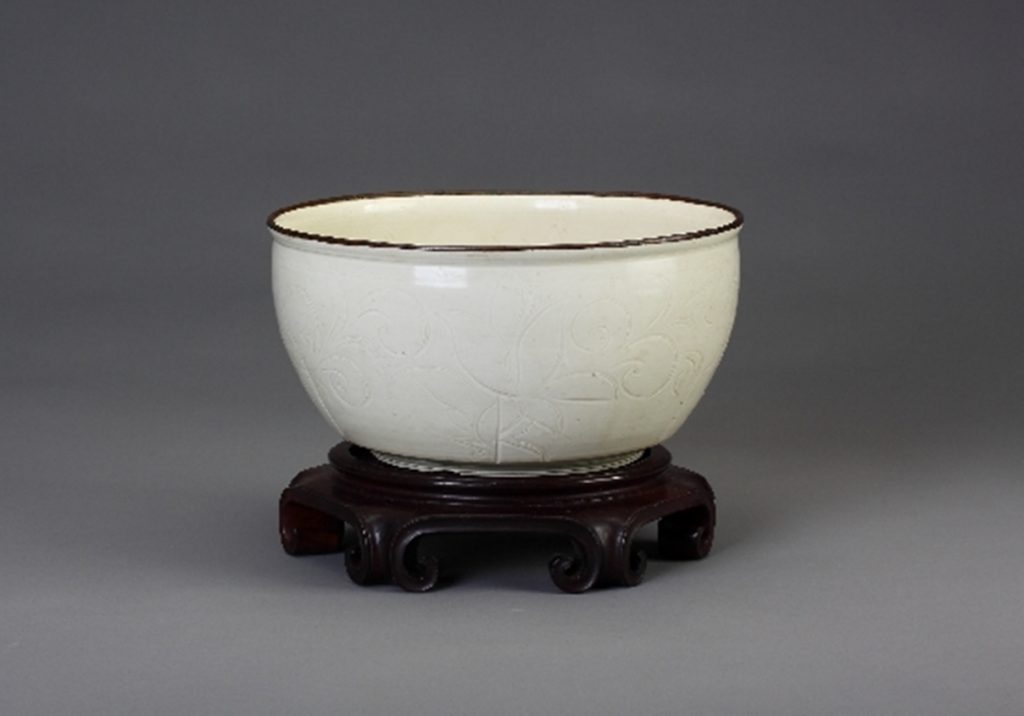
福建地区窑口众多,白瓷系以素有“象牙白”、“中国白”美誉的德化窑而著称,极具价值的文物很多,包括“何朝宗”款观音像、达摩像等如此宝贵的国家一级文物,但是北方地区白瓷窑址的珍稀器物却鲜有收藏。现藏于福建博物院的宋代定窑白釉划莲花纹大碗,是一件不可多得的传世稀品。
此器侈口,包红铜边,沿微外卷,弧腹下微收,状若扁鼓。碗内心刻划团花,内外壁刻划缠枝莲,外壁下端刻划六道直线纹。通体施牙黄釉,釉面柔和洁净。浅圈足,足底露胎,胎质灰白坚致,声色清脆悠扬。附红木底座。
定窑是中国古代北方著名白瓷窑址,是宋代“五大名窑”之一,位于河北省曲阳县涧磁村一带,总面积约10平方公里,曲阳宋属定州,故称定窑。定窑创烧于唐代,受邢窑影响烧制白瓷,兼烧黑釉、酱釉、绿釉及白釉剔花器。宋代极盛,逐步成为白瓷窑之首,元代逐渐衰落,烧瓷历史长达六、七百年之久。其器形、纹饰、覆烧技法对各地瓷窑影响较大,形成了一个以定窑为主的定窑瓷系。产品远销海外,在瓷器发展史上占有重要地位。
该器物造型端庄古雅,胎质细腻,比较轻薄,敲声清脆,朗朗入耳。釉色莹润柔和,纹饰清晰简练,疏密得体。定窑对花纹装饰特别讲究,北宋早期是定窑装饰的转变期,吸收了越窑、耀州窑的装饰风格,当时最流行莲瓣纹,用偏刀斜挖,具有浅浮雕的效果。小阴刻线则用划花方法,长短不一致。定窑后期首创“覆烧法”这一高效率的装烧工艺,胎体变薄,偏刀深挖不合适了,于是出现刻划结合、刻印结合的独特风格。该器物纹饰以莲花为主,莲瓣肥大,刻工技巧娴熟,刀法流畅自如,线条圆浑有力,画面立体感强。北宋后期普遍使用“覆烧法”,则器口不能施釉,以免粘连于垫圈上,于是出现了“芒口”,宋代往往镶一圈金、银或铜为饰,既美观,又提升了器物价值。用金属对器物进行镶口的工艺早在唐代已经出现,最早用在漆器上,用银包口以增加使用寿命,也有镶耳、包脚等。
这件莲花纹大碗解放前原藏于刘勇业家,解放后被刘家带到上海。1962年福建省文物总店付尚节、刘斯章从上海刘家收购,后由黄汉杰商购、经何必然批准收购入藏福建博物院。如此精工大器的定瓷极为难得,1995年经鉴定确认为国宝级文物。
参考: 佳士得
賞心菁華-琵金頓珍藏重要中國工藝精品
2016年4月6日 | 上午 10:00 HKT
香港
4 宋 定窰白釉刻魚紋葵口盤

估價 120,000 — 180,000 港幣
拍品已售 2,120,000 港幣 成交價 (含買家佣金)
宋 定窰白釉刻魚紋葵口盤
14.7 公分,5 3/4 英寸
來源
Martin d. Corke 收藏,至1959年
倫敦蘇富比1959年2月17日,編號13(£150)
Bluett & Sons Ltd,倫敦,1959年(£150)
羅傑琵金頓(1928-69年)收藏 , 自1959年(£200)
相關資料
此六瓣盤,器形柔雅,所刻魚水紋,渾然靈動,當屬罕有佳作。台北故宮藏一相類雙魚紋盤例,魚游向相反,展於《定州花瓷:院藏定窰系白瓷特展》,國立故宮博物院,台北,2014年,圖版II-88;同錄一盤例,模印矮足刻單魚紋,見圖版II-89。
魚水紋極為常見,多雙魚作對。「魚」象徵婚姻合美,子孫繁盛,寓意和睦幸福。而雙魚游於水中則尤表夫妻恩愛如「魚水和諧」。
参考: 佳士得
賞心菁華-琵金頓珍藏重要中國工藝精品
2016年4月6日 | 上午 10:00 HKT
香港
1 宋 定窰白釉刻蓮紋盤
估價 250,000 — 350,000 港幣
拍品已售 2,240,000 港幣 成交價 (含買家佣金)

20.7 公分,8 1/8 英村
狀況報告
整體品相良好
來源
Frederick T. Fuller 收藏,至1965年
倫敦佳士得1965年6月28/29日,編號277(1000 gns.)
Bluett & Sons Ltd,倫敦,1965年(1000 gns.)
羅傑琵金頓(1928-69年)收藏, 自1965年(£1500)
相關資料
河北曲陽定窰,位列宋代五大名窰,乃中國瓷器名品之一,此件白釉刻蓮紋盤為定窰器制中秀雅絕凡且具代表性之例。一件尺寸紋飾皆相近刻花圓盤,1986年12月8日售於倫敦佳士得,編號232,後入私人宋瓷珍藏,2011年3月23日售於紐約蘇富比,編號513。戴潤齋藏一件定窰花口盤,光素無紋,2011年3月22日售於紐約蘇富比,編號294。北宋金石學家呂大臨(1038-1093)家族墓,出土二件定窰白釉素紋花口盤,展出於賽克勒考古與藝術博物館,北京大學,2013年,錄於《異世同調:陝西省藍田呂氏家族墓地出土文物》,北京,2013年,編號30、31。
参考:佳士得
2020 | 現場拍賣 18244
重要中國瓷器及工藝精品
29 11月 2020
拍品 3001
北宋晚期/金早期 定窯刻蓮紋大盌
LATE NORTHERN SONG-EARLY JIN DYNASTY, 11TH-12TH CENTURY
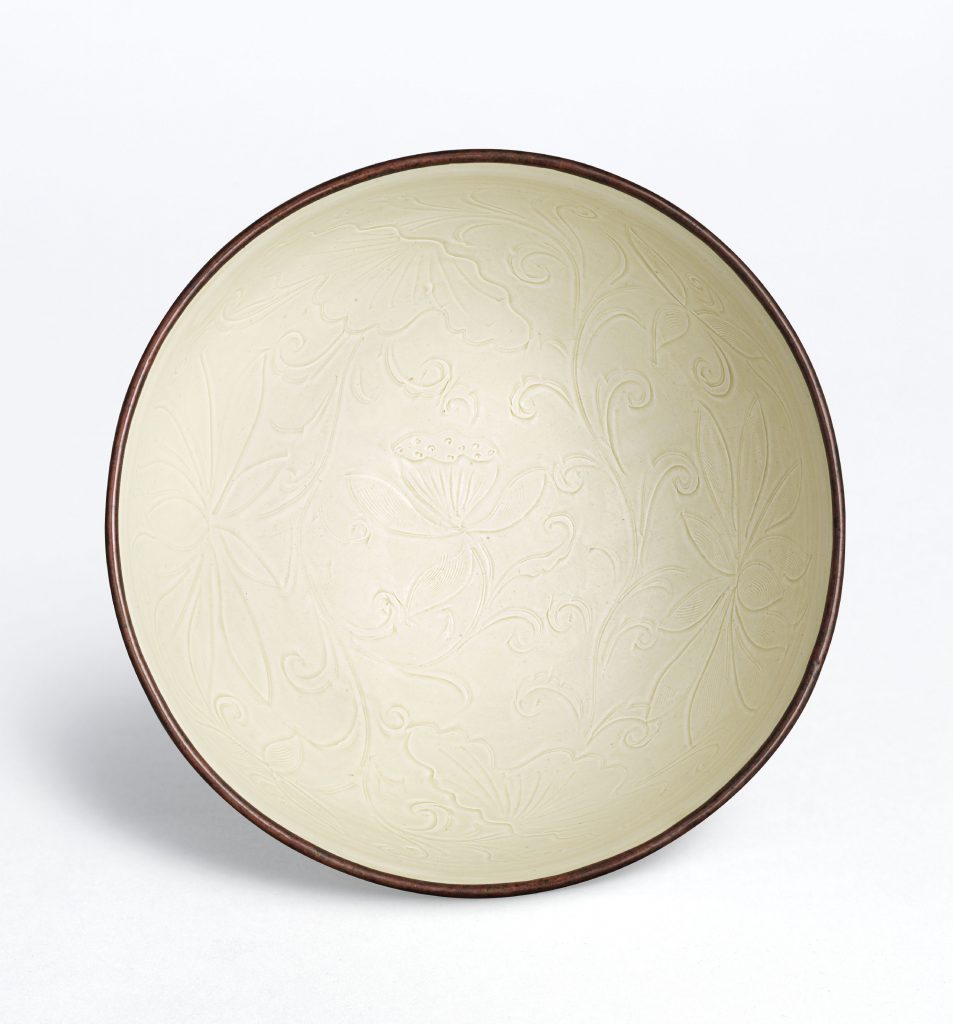
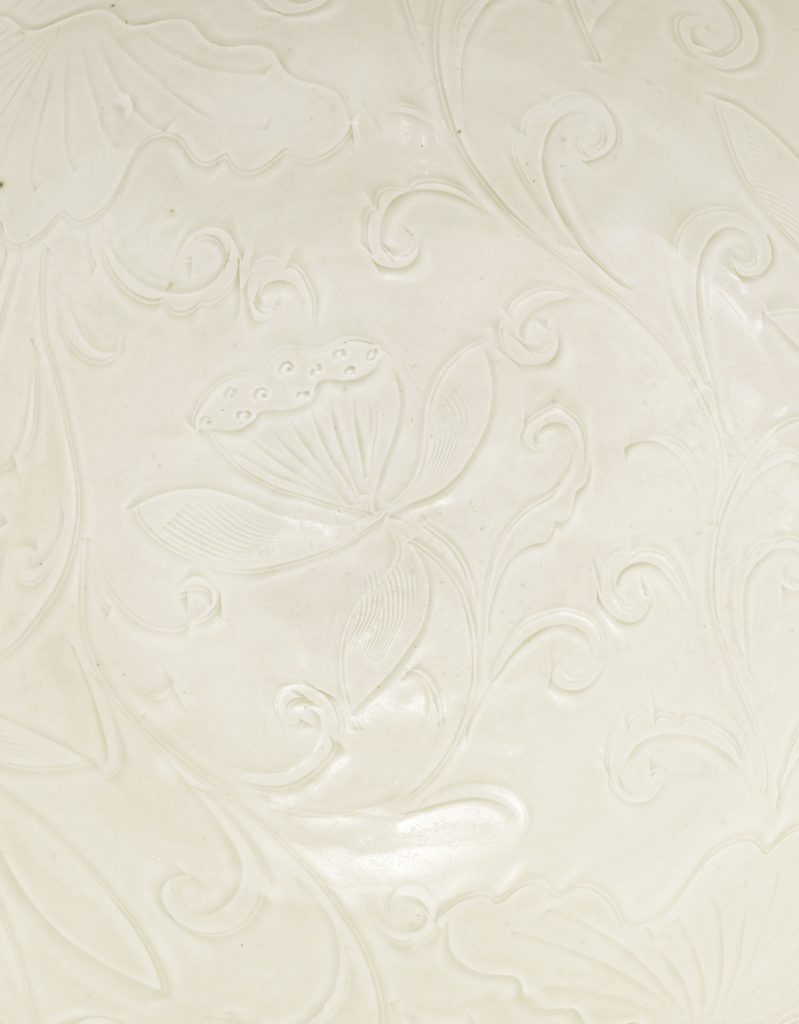
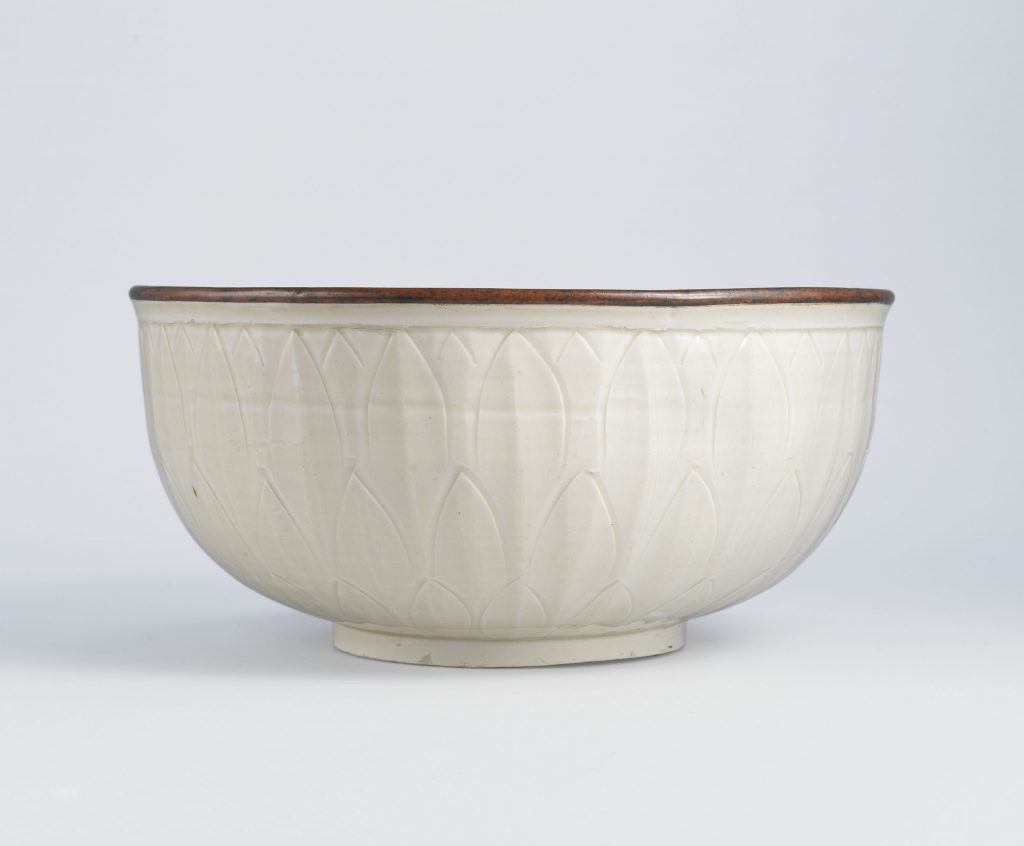
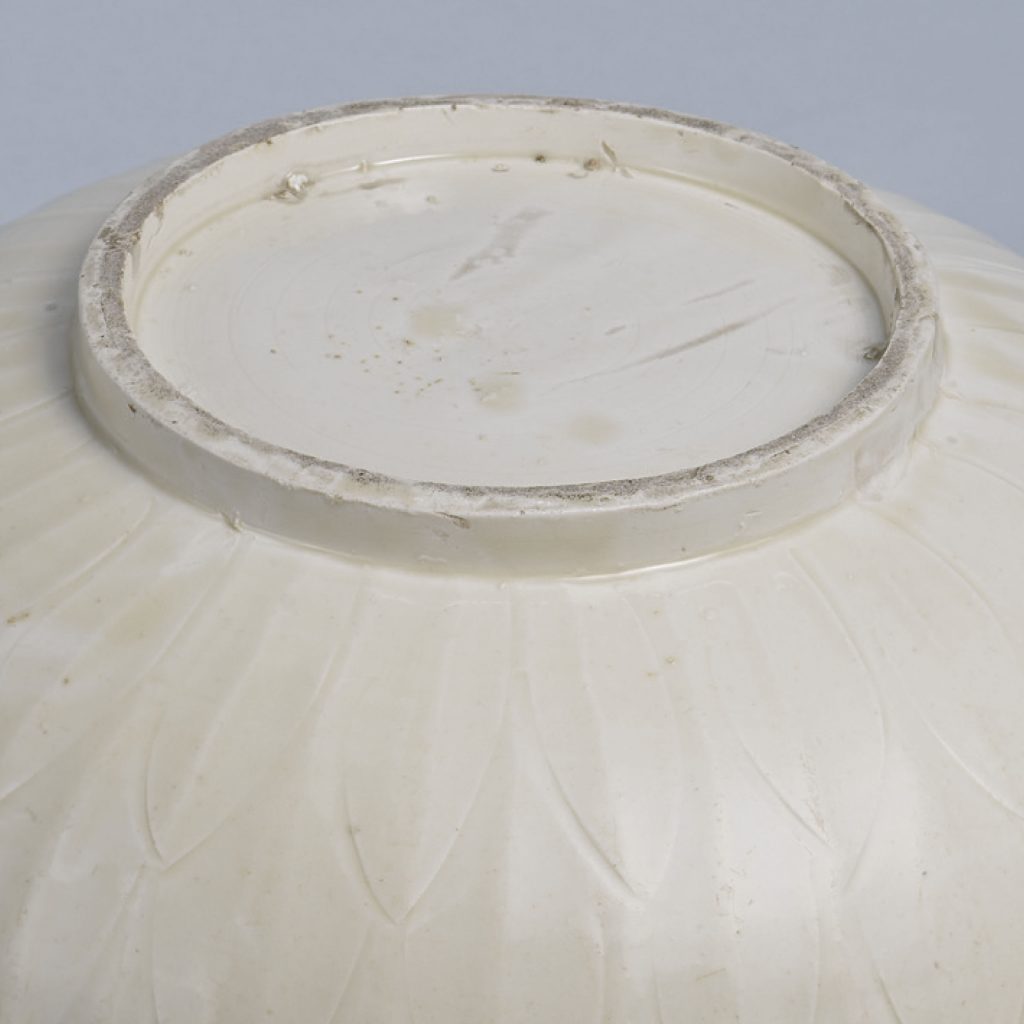
成交價 HKD 27,850,000
估價 HKD 6,000,000 – HKD 8,000,000
亞歷山大定窯盌
蘇玫瑰 國際亞洲藝術部學術總監
是次拍賣的定窯大盌清雅絕俗,經手藏家無不赫赫有名,銀行家亞歷山大(William Cleverly Alexander,1840至1916年)(圖一)為其中之一。亞歷山大富甲一方,本身亦是眼光獨到的中日藝術鑑藏家。他更是畫家惠斯勒(James McNeil Whistler)的早期贊助人之一,後者曾受託為亞歷山大千金繪製肖像,更為其倫敦府邸及薩塞克斯鄉間別墅構思裝飾格局。1916年,英國藝術家暨評論家弗萊(Roger Fry)在訃聞中提到,亞歷山大的購藏生涯處處體現了藏家的遠見卓識。除蒐藏中國陶瓷和玉器之外,亞歷山大亦是倫敦伯靈頓美術俱樂部(Burlington Arts Club)成員,並多次外借藏品予重量級展覽會,1895年的伯靈頓美術俱樂部展覽會便是一例。
本拍品亦曾借予曼徹斯特城美術館,在1913年一場意義重大的工藝品展覽會上亮相,圖見《Catalogue of an exhibition of Chinese applied art: bronzes, pottery, porcelains, jades, embroideries, carpets, enamels, lacquers, etc.》編號774 (曼徹斯特城美術館,1913)。亞歷山大去世之後,其女兒將庋藏名畫贈予倫敦國家美術館。1931年5月,她們委託倫敦蘇富比拍賣亞歷山大亞洲藝術珍藏,前後歷時兩天,本定窯大盌乃芸芸拍品之一(拍品編號48),最終花落倫敦古董名商Bluett & Sons。亞歷山大中國珍藏件件精奇,英國收藏泰斗大維德爵士亦頻頻出手且收穫甚豐。
此例定窯大盌不僅雋雅大氣,且盡顯北宋製瓷工藝之精湛。呎吋大如本拍品的定窯盤盌少之又少,因為對陶匠或窯師而言,其燒造難度相當大。燒製定窯器多用饅頭窯或馬蹄窯,饅頭窯盛行於宋代華北地區,屬橫焰窯,爐溫可高達1300oC左右,而定窯器富含氧化鋁,瓷土須高溫燒成。饅頭窯的缺點是窯膛較小,而定窯上乘白釉器俱用匣鉢(泥匣)窯燒,以隔擋窯內碎屑,因此窯膛內單品所佔空間更大。為了用一個匣缽燒造兩件或以上的器物,又要確保所有作品完好無缺,多級覆燒墊鉢與L形支圈遂應運而生。由此定窯器方能覆燒(即抹去器物口沿的釉,再將之上下倒置)而成。一般來說,多級覆燒墊鉢適用於器型漸次增加者,而相同大小的盤則宜用L形墊圈。覆燒大小與本拍品相若的器物,窯燒時變形及/或開裂的風險甚高,對陶匠和窯師來說都是一項嚴峻的考驗。除了諸多的技術難題,窯燒的燃料亦成本不菲,加上每批燒造的大型器物數量有限,所以像本拍品一類的大盌定然造價高昂。製作方固然嚴陣以待,而訂製者亦非富則貴。難怪器型敦碩如本拍品的定窯盤盌,傳世者少如鳳毛麟角。現存同類型大盌之中,器內飾魚紋或蓮紋者居多,器外或光素無紋,或飾纏枝蓮紋,也有像本拍品般淺刻交疊瓣紋的例子。此類大盌的成功之作看來數量極少,故此傳世品彌足珍貴。北京中國國家博物館藏一例,盌內飾蓮紋,器外淺刻交疊瓣紋,圖見en.chnmuseum.cn/collections_577/collection_highlights_608/201911/t20191121_172679.html。
台北國立故宮博物院藏一盌紋飾(圖二)雷同,圖見《定窰白瓷特展圖錄》編號32;另一例館藏盌內飾蓮紋,器外光素,圖見前述圖錄編號30(台北:1987)。福建博物院藏一件定窯大盌,內外分別飾以蓮花和纏枝蓮紋,圖見《中國文物精華大全:陶瓷卷》頁270編號334(台北:1993)。
此外,舊金山亞洲藝術博物館藏中也有一件近似例,其盌內飾蓮紋,器外淺雕交疊瓣紋(館藏號B60P1491)。有意思的是,位於韓國開城的公元1152年高麗古墓中,亦曾出土一件略小的近似例,其盌內飾蓮紋,器外光素,現藏東京國立博物館,圖見《定窯白磁》編號121 (東京:根津美術館,1983)。蓮被視為佛教、純潔、和諧與美麗的化身,所以在諸多中國藝術形式中,此類題材長盛不衰。宋代學者周敦頤(公元1017至1073年)著有《愛蓮說》,堪稱中國文學史上最膾炙人口的咏蓮之作,文中的蓮花更被喻為儒家推許的君子之德。古畫之中,蓮的形象千姿百態,如含苞、盛放、結籽或荷葉舒卷等皆時可得見。由於蓮的苞、花、籽實可同時出現,故形同三個人生階段:過去、現在與未來。宋瓷鮮有此類描寫,而定窯器則泰半飾纏枝蓮紋,或較為樸拙的蓮花與蓮葉。本拍品既承襲了古代畫風,且蓮蓬、花葉無不生動傳神、宛然如見,其珍罕程度可謂不言而喻。
北宋晚期/金早期 定窯刻蓮紋大盌
狀況報告
謹請注意,所有拍品均按「現狀」拍賣,閣下或閣下的專業顧問應於拍賣前親自查看拍品以評鑑拍品之狀況。
-整體品相非常好,保存完整,非常難得
-器面有些許輕微磨損,屬正常現象,尤其在盌心位置
-銅扣能移除
-銅扣下口沿有一小磕,約0.6公分寬
-外壁有一鐵斑,於燒製時產生
北宋晚期/金早期 定窯刻蓮紋大盌
12 3/8 in. (31.5 cm.) diam.
來源
英國亞歷山大(William Cleverley Alexander)紳士(1840-1916)珍藏,後流傳至亞歷山大小姐
倫敦蘇富比,1931年5月6日,拍品48號(成交價150英鎊)
購自倫敦Bluett & Sons(175英鎊)
出版
R.L. Hobson及A.L. Hetherington,《The Art of the Chinese Potter》,倫敦,1923年,圖版XLIV
展覽
曼徹斯特城美術館,1913年,編號774

![[临渊阁]天地一家春](https://www.antiquekeeper.ca/wp-content/uploads/2023/03/cropped-Asian-Art-Wallpaper-Painting3-6-1.jpg)





































